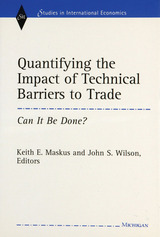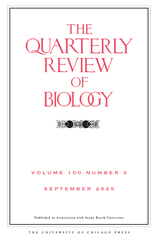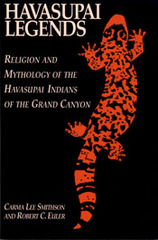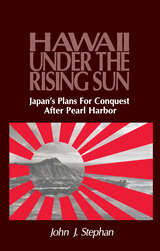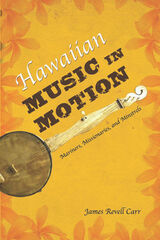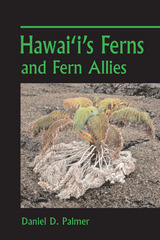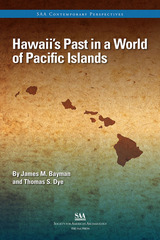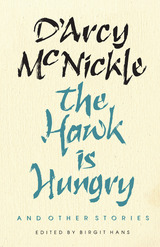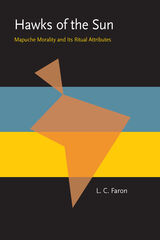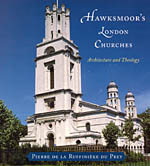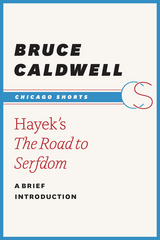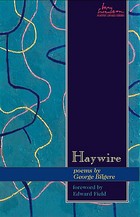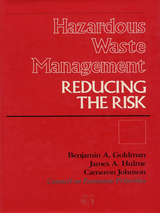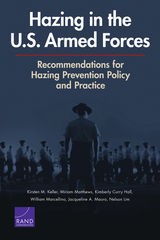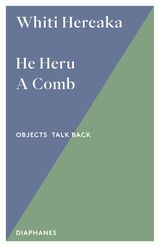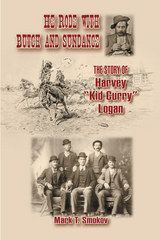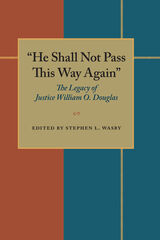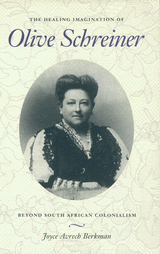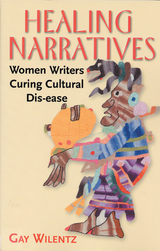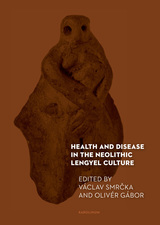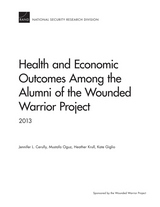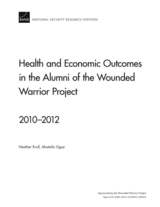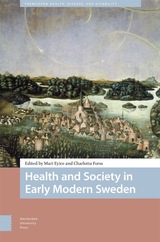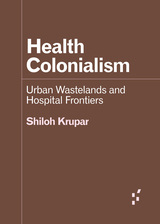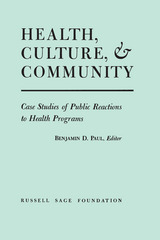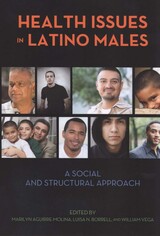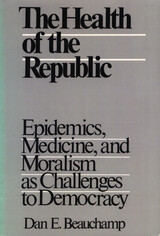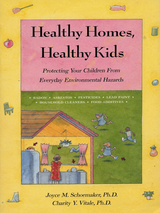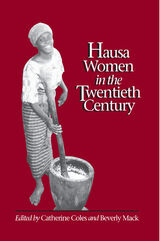 Hausa Women in the Twentieth Century
Edited by Catherine M. Coles and Beverly Mack
University of Wisconsin Press, 1991 The Hausa are one of the largest ethnic groups in Africa, with populations in Nigeria, Niger, and Ghana. Their long history of city-states and Islamic caliphates, their complex trading economies, and their cultural traditions have attracted the attention of historians, political economists, linguists, and anthropologists. The large body of scholarship on Hausa society, however, has assumed the subordination of women to men.
Hausa Women in the Twentieth Century refutes the notion that Hausa women are pawns in a patriarchal Muslim society. The contributors, all of whom have done field research in Hausaland, explore the ways Hausa women have balanced the demands of Islamic expectations and Western choices as their society moved from a precolonial system through British colonial administration to inclusion in the modern Nigerian nation. This volume examines the roles of a wide variety of women, from wives and workers to political activists and mythical figures, and it emphasizes that women have been educators and spiritual leaders in Hausa society since precolonial times. From royalty to slaves and concubines, in traditional Hausa cities and in newer towns, from the urban poor to the newly educated elite, the "invisible women" whose lives are documented here demonstrate that standard accounts of Hausa society must be revised.
Scholars of Hausa and neighboring West African societies will find in this collection a wealth of new material and a model of how research on women can be integrated with general accounts of Hausa social, religious, political, and economic life. For students and scholars looking at gender and women's roles cross-culturally, this volume provides an invaluable African perspective.
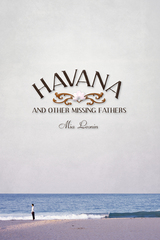 Havana and Other Missing Fathers
Mia Leonin
University of Arizona Press, 2009 Mia Leonin spent the first sixteen years of her life believing her father was dead. All she knew of the man came through stories told by her mother. At times he had been a surgeon, at others a psychiatrist. In truth, he had been a fantasy.
Shortly after her sixteenth birthday, Leonin learned from her mother that her father, a Cuban exile, was very much alive and living in Florida. Her attempts to contact him, however, were thwarted until four years later, when she left home in search of her roots.
She meets her father, but trying to discover the truth behind him proves to be a more daunting task. Her journey takes her to Miami, Colombia, and Cuba, and her search for cultural identity leads her to create memories, friendships, and romances. She finds moments of connection and redemption, ending up in Havana not as a cultural tourist but as an illegitimate daughter of Cuba looking for validation. What she discovers is an island bereft of fathers and brimming with paternalism. As she becomes entangled with two different men, she descends further into the Havana of poverty, humiliation, and despair, as well as the ever-inventive city that is as passionate as it is contradictory.
Insightful, imaginative, and often poetic, Havana and Other Missing Fathers is Mia Leonin’s recollection of this journey and her longing to learn more about her origins. In the end, she must learn to accept the answers she discovers as well as the questions that remain.
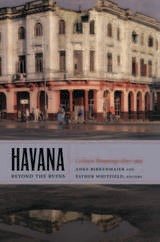 Havana beyond the Ruins: Cultural Mappings after 1989
Anke Birkenmaier and Esther Whitfield, eds.
Duke University Press, 2011 In Havana beyond the Ruins, prominent architects, scholars, and writers based in and outside of Cuba analyze how Havana has been portrayed in literature, music, and the visual arts since Soviet subsidies of Cuba ceased, and the Cuban state has re-imagined Havana as a destination for international tourists and business ventures. Cuba’s capital has experienced little construction since the revolution of 1959; many of its citizens live in poorly maintained colonial and modernist dwellings. It is this Havana—of crumbling houses, old cars, and a romantic aura of ruined hopes—that is marketed in picture books, memorabilia, and films. Meanwhile, Cuba remains a socialist economy, and government agencies maintain significant control of urban development, housing, and employment. Home to more than two million people and a locus of Cuban national identity, Havana today struggles with the some of the same problems as other growing world cities, including slums and escalating social and racial inequalities. Bringing together assessments of the city’s dwellings and urban development projects, Havana beyond the Ruins provides unique insights into issues of memory, citizenship, urban life, and the future of the revolution in Cuba. Contributors
Emma Álvarez-Tabío Albo
Eric Felipe-Barkin
Anke Birkenmaier
Velia Cecilia Bobes
Mario Coyula-Cowley
Elisabeth Enenbach
Sujatha Fernandes
Jill Hamberg
Patricio del Real
Cecelia Lawless
Jacqueline Loss
Orlando Luis Pardo Lazo
Antonio José Ponte
Nicolás Quintana
Jose Quiroga
Laura Redruello
Rafael Rojas
Joseph L. Scarpaci
Esther Whitfield
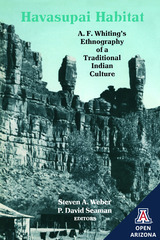 Havasupai Habitat: A. F. Whiting's Ethnography of a Traditional Indian Culture
A. F. Whiting; Edited by Steven A. Weber and P. David Seaman
University of Arizona Press, 1985 The Havasupai Indians have lived for centuries in Cataract Canyon, and even came to be confined there by treaty. When anthopologist Alfred F. Whiting set out to study the Havasupai in the early 1940s, he found a culture that in many aspect remained unchanged. In Havasupai Habitat editors Weber and Seaman have distilled Whiting's ethnographic research. Part I comprises ten thematic chapters dealing with various aspects of culture, such as hunting and gathering, child care, housing, and religion. Part II offers a systematic presentation of Havasupai knowledge of weather and astronomy, minerals, animals, and plants; and for each item listed, Whiting has provided scientific and common English terminology, phonetic spelling, and a description of usage.
Published in 1985, Havasupai Habitat offers a rich ethnography on lifeways of the Havasupai people.
Havasupai Legends: Religion and Mythology of the Havasupai Indians of the Grand Canyon
Robert C Euler
University of Utah Press, 1994 For almost seven hundred years, the Havasupai Indians, who call themselves People of the Blue Water, have lived in an area that includes the depths of the western Grand Canyon and the heights of the San Francisco Peaks. Here they inhabited the greatest altitude variation of any Indians in Southwestern America.
Written in consultation with some of the last Havasupai shamans, this book details their religious beliefs, customs, and healing practices. A second section presents legends of the Havasupai origin, the first people, and tales of Coyote, Gila Monster, Bear, and others.
Have
Marc Gaba
Tupelo Press, 2011 Marc Gaba is from Quezon City, Philippines, where he continues to live. He received an M.F.A. in Creative Writing from the Iowa Writers’ Workshop. Also a visual artist who has had solo and group exhibitions, he is curator of the art gallery Krem Contemporary Art. Previous publications include two chapbooks and Atomic Neutral, a single-edition collection of poems published as part of an exhibit, Birdsounds.
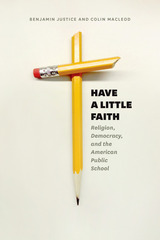 Have a Little Faith: Religion, Democracy, and the American Public School
Benjamin Justice and Colin Macleod
University of Chicago Press, 2016 It isn’t just in recent arguments over the teaching of intelligent design or reciting the pledge of allegiance that religion and education have butted heads: since their beginnings nearly two centuries ago, public schools have been embroiled in heated controversies over religion’s place in the education system of a pluralistic nation. In this book, Benjamin Justice and Colin Macleod take up this rich and significant history of conflict with renewed clarity and astonishing breadth. Moving from the American Revolution to the present—from the common schools of the nineteenth century to the charter schools of the twenty-first—they offer one of the most comprehensive assessments of religion and education in America that has ever been published.
From Bible readings and school prayer to teaching evolution and cultivating religious tolerance, Justice and Macleod consider the key issues and colorful characters that have shaped the way American schools have attempted to negotiate religious pluralism in a politically legitimate fashion. While schools and educational policies have not always advanced tolerance and understanding, Justice and Macleod point to the many efforts Americans have made to find a place for religion in public schools that both acknowledges the importance of faith to so many citizens and respects democratic ideals that insist upon a reasonable separation of church and state. Finally, they apply the lessons of history and political philosophy to an analysis of three critical areas of religious controversy in public education today: student-led religious observances in extracurricular activities, the tensions between freedom of expression and the need for inclusive environments, and the shift from democratic control of schools to loosely regulated charter and voucher programs.
Altogether Justice and Macleod show how the interpretation of educational history through the lens of contemporary democratic theory offers both a richer understanding of past disputes and new ways of addressing contemporary challenges.
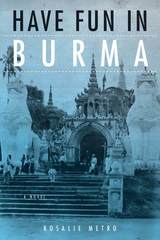 Have Fun in Burma: A Novel
Rosalie Metro
Northern Illinois University Press, 2018 Adela Frost wants to do something with her life. When a chance encounter and a haunting dream steer her toward distant Burma, she decides to spend the summer after high school volunteering in a Buddhist monastery. Adela finds fresh confidence as she immerses herself in her new environment, teaching English to the monks and studying meditation with the wise abbot. Then there’s her secret romance with Thiha, an ex-political prisoner with a shadowy past.
But when some of the monks express support for the persecution of the country’s Rohingya Muslim minority, Adela glimpses the turmoil that lies beneath Burma’s tranquil surface. While investigating the country’s complex history, she becomes determined to help stop communal violence. With Thiha’s assistance, she concocts a scheme that quickly spirals out of control. Adela must decide whether to back down or double down, while protecting those she cares about from the backlash of Buddhist and Muslim extremists. Set against the backdrop of Burma’s fractured transition to democracy, this coming-of-age story weaves critiques of “voluntourism” and humanitarian intervention into a young woman’s quest for connection across cultural boundaries. This work of literary fiction will fascinate Southeast Asia buffs and anyone interested in places where the truth is bitterly contested territory.
 Have I Got Dirt For You: Using Office Gossip to Your Advantage
Dominique Darmon
Amsterdam University Press, 2022 Even though office gossip is generally frowned upon, many studies show that gossip in organizations is not only inevitable, but can even be a positive communication tool. However, by gossiping in the wrong way, employees can easily lose the trust of their colleagues and be perceived negatively very quickly.
Research shows that people who claim to never gossip tend to be considered as socially inept, but those that are constantly gabbing at the coffee machine are quickly seen as untrustworthy. There is an optimal amount of time one should gossip – somewhere in the middle – which we call the sweet spot of gossip. However, it’s not only the amount of time one spends gossiping that will make or break an employee or manager. Other factors such as credibility, what we gossip about, whom we gossip with, culture, and place, all play an equally crucial role in the art of gossiping successfully at work. Finding the right balance for all of these factors is of the essence.
Winner of a Silver Medal from the Axiom Business Book Awards, shortlisted by the Order of Organization Advisors (Ooa).
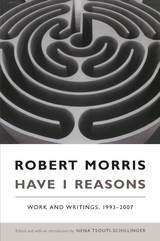 Have I Reasons: Work and Writings, 1993–2007
Robert Morris
Duke University Press, 2008 Robert Morris, a leading figure in postwar American art, is best known as a pioneer of minimalist sculpture, process art, and earthworks. Yet Morris has resisted affiliation with any one movement or style. An extraordinarily versatile artist, he has produced dances, performance pieces, prints, paintings, drawings, and installations, working with materials including plywood, felt, dirt, aluminum, steel mesh, fiberglass, and encaustic. Throughout his career, Morris has written influential critical essays, commenting on his own work as well as that of other artists, and exploring through text many of the theoretical concerns addressed in his artwork—about perception, materiality, space, and the process of artmaking. Have I Reasons presents seventeen of Morris’s essays, six of which have never been published before. Written over the past fifteen years, the essays, along with the volume’s many illustrations, provide an invaluable record of the recent thought of a major American artist. The writings are arranged chronologically, beginning with “Indiana Street,” a vivid autobiographical account of the artist’s early years in Kansas City, Missouri. Have I Reasons includes reflections on Morris’s own site-specific installations; transcripts of seminars he conducted in conjunction with exhibitions; and the textual element of The Birthday Boy, the two-screen video-and-sound piece he installed at the Galleria dell’Accademia in Florence, Italy, on the occasion of the five hundredth anniversary of Michelangelo’s David. Essays range from original interpretations of Cézanne’s Mont Sainte-Victoire paintings and Jasper Johns’ early work to engagements with one of Morris’s most significant interlocutors, the philosopher Donald Davidson. Have I Reasons conveys not only Morris’s enduring deep interest in philosophy and issues of resemblance and representation but also his more recent turn toward directly addressing contemporary social and political issues such as corporate excess and preemptive belligerence.
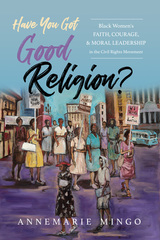 Have You Got Good Religion?: Black Women's Faith, Courage, and Moral Leadership in the Civil Rights Movement
AnneMarie Mingo
University of Illinois Press, 2024 What compels a person to risk her life to change deeply rooted systems of injustice in ways that may not benefit her? The thousands of Black Churchwomen who took part in civil rights protests drew on faith, courage, and moral imagination to acquire the lived experiences at the heart of the answers to that question. AnneMarie Mingo brings these forgotten witnesses into the historical narrative to explore the moral and ethical world of a generation of Black Churchwomen and the extraordinary liberation theology they created. These women acted out of belief that what they did was bigger than themselves. Taking as their goal nothing less than the moral transformation of American society, they joined the movement because it was something they had to do. Their personal accounts of a lived religion enacted in the world provide powerful insights into how faith steels human beings to face threats, jail, violence, and seemingly implacable hatred. Throughout, Mingo draws on their experiences to construct an ethical model meant to guide contemporary activists in the ongoing pursuit of justice. A depiction of moral imagination that resonates today, Have You Got Good Religion? reveals how Black Churchwomen’s understanding of God became action and transformed a nation.
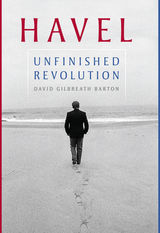 Havel: Unfinished Revolution
David Barton
University of Pittsburgh Press, 2020 This is the story of a man who tried to resurrect the spirit of democratic life. He was born into a time of chaos and absurdity, and he took it as his fate to carry a candle into the night. This is his story and the story of many others, the writers, artists, actors, and philosophers who took it upon themselves to remember a tradition that had failed so miserably it had almost been forgotten.
Václav Havel (1936–2011), the famous Czech dissident, intellectual, and playwright, was there when a half million people came to Wenceslas Square to demand an end to Communism in 1989. Many came to hear him call for a free Czechoslovakia, for democratic elections, and a return to Europe. The demonstrators roared when he spoke. “Havel to the castle,” they chanted— meaning Havel for president. And a few weeks later, Havel became a most unusual president. He was sometimes misunderstood and not always popular, but by the time of his death in 2011, the world recognized Havel as one of the most prominent figures of the twentieth century.
Born into one of the most prominent and wealthy families in Prague, Havel was the constant subject of attention and an artistic eccentric in a family of businessmen. A young Havel and his family were cast by the Communist takeover as class enemies. Havel traveled a dark road that, ironically, provided the experiences he needed to reconnect not only to his own “ground of being” but to the traditions of civic society. This biography is the story of Havel’s inward journey in his underground years and thus the story of how Havel, the outsider, became the ultimate insider as president of the nation.
In this intimate and sweeping portrayal of Havel, David Barton reveals the eccentricities of the last president of Czechoslovakia, and the first president of the Czech Republic.
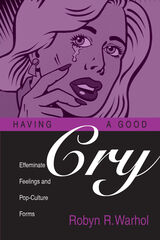 HAVING A GOOD CRY: Effeminate Feelings and Pop-Culture Forms
Robyn R. Warhol
Ohio State University Press, 2003 Robyn R. Warhol’s goal is to investigate the effects of readers’ emotional responses to formulaic fiction of the nineteenth and twentieth centuries on gendered subjectivity. She argues that modern literary and cultural studies have ignored nonsexual affectivity in their inquiries. The book elaborates on Warhol’s theory of affect and then focuses on sentimental stories, marriage plots, serialized novels, and soap operas as distinct genres producing specific feelings among fans. Popular narrative forms use formulas to bring up familiar patterns of feelings in the audiences who love them. This book looks at the patterns of feelings that some nineteenth- and twentieth-century popular genres evoke, and asks how those patterns are related to gender. Soap operas and sentimentalism are generally derided as “effeminate” forms because their emotional range is seen as hyperfeminine. Having a Good Cry presents a celebration of effeminate feelings and works toward promoting more flexible, less pejorative concepts of gender. Using a psychophysiological rather than a psychoanalytic approach to reading and emotion, Warhol seeks to make readers more conscious of what is happening to the gendered body when we read.
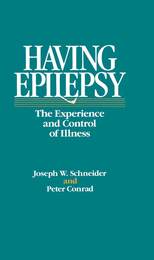 Having Epilepsy: The Experience and Control of Illness
Joseph W. Schneider and Peter Conrad
Temple University Press, 1985 "Well written and fascinating to read. This fine book takes a large step in...contributing to the only slowly dawning awareness of the general public, and the health workers too, of the significance of chronic illness."
--Anselm Strauss, University of California, San Francisco
Based on in-depth interviews with eighty people who have epilepsy, this book gives a first-hand account of what it is like to cope with a chronic illness, while working, playing, and building relationships. The authors recount how people discover they have epilepsy and what it means; how families respond to someone labeled "epileptic"; how seizures affect a person's sense of self and self-control.
Epilepsy patients explain what they want from their doctors and why the medication practices they develop may not coincide with "doctor's orders." The variety of experiences of epilepsy is suggested both by the interviews and by the range of terms for seizures--Petit Mal, Grand Mal, auras, fits, absences.
The principal difficulty for many people with epilepsy is not the medical condition but the social stigma. A person with epilepsy has to cope with discrimination in obtaining a job, insurance, or a driver's license, and he or she may be cautious about revealing this "disabling" condition to an employer or even a spouse. People with epilepsy may manage information about themselves and their "lapses" and look for "safe places" like restrooms where they can be alone should a seizure begin. Many of those interviewed complained of overreactions to seizures by colleagues or bystanders: epilepsy patients were embarrassed at having provoked a public crisis or were annoyed at waking up in a hospital emergency room.
This is a book for people who have epilepsy, for their families and friends; for health care professionals who deal with chronic illnesses; and for students of medical sociology and the sociology of deviance.
"For anyone who would like to 'get inside' the experience of having epilepsy, this book is probably as close as one can come."
--Epilepsia
"In dispelling the notion that 'the person is the illness,' these interviews with 80 individuals reveal that those suffering from epilepsy have learned to accept it as merely another facet of their lives. A valuable contribution for those with epilepsy, for their family and friends, for medical personnel, and for the general public."
--Booklist
"...carefully outlined and clearly written.... Those affected by chronic conditions may find the book most helpful.... Family and helping professionals may discover new insights.... Social scientists, especially those interested in chronic illnesses, will benefit from the research conclusions and suggestions for further research."
--Medical Anthropology Quarterly
"It represents an important advance in the medical sociology literature as well as a contribution to qualitative sociology. I think that the book should become a contemporary classic in medical sociology."
--Qualitative Sociology
"...an important contribution.... In focusing on what it is like to have epilepsy in this society, Schneider and Conrad have reversed an earlier concern for the medicalization of deviance, opting in this work for an understanding of the stigmatization of illness."
--Contemporary Sociology
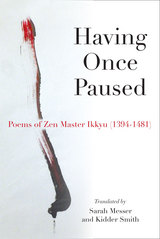 Having Once Paused: Poems of Zen Master Ikkyu (1394-1481)
Ikkyu Sojun
University of Michigan Press, 2015 The influence of Zen Master Ikkyū (1394-1481) permeates the full field of medieval Japanese aesthetics. Though best known as a poet, he was central to the shaping and reshaping of practices in calligraphy, Noh theater, tea ceremony, and rock gardening, all of which now define Japan’s sense of its cultural tradition. Ikkyū is unique in Zen for letting his love of all appearance occupy him until it destroys any possibility for safety or seclusion. In his poetry, he turns the eye of enlightenment to all phenomena: politics, pine trees, hard meditation practice, sex, wine. A lifelong outsider to religious establishments, Ikkyū nonetheless accepted Imperial command to rebuild his home temple, Daitoku-ji, destroyed in the civil wars. He died before that project was complete. The poems in this collection express the unborn bliss of Ikkyū’s realization and equally his devastation at the horrors of this world. They are peopled with ancient Chinese poets, cantankerous Japanese Zen Masters, contemporary warlords, and his lover Mori, a blind musician who lived with Ikkyū the last eleven years of his life. All of this is his Buddhism. His awakening outshines the small idols of reason, emotion, self, desire, doctrine, even of Buddhism itself.
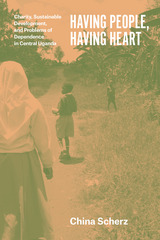 Having People, Having Heart: Charity, Sustainable Development, and Problems of Dependence in Central Uganda
China Scherz
University of Chicago Press, 2014 Believing that charity inadvertently legitimates social inequality and fosters dependence, many international development organizations have increasingly sought to replace material aid with efforts to build self-reliance and local institutions. But in some cultures—like those in rural Uganda, where Having People, Having Heart takes place—people see this shift not as an effort toward empowerment but as a suspect refusal to redistribute wealth. Exploring this conflict, China Scherz balances the negative assessments of charity that have led to this shift with the viewpoints of those who actually receive aid.
Through detailed studies of two different orphan support organizations in Uganda, Scherz shows how many Ugandans view material forms of Catholic charity as deeply intertwined with their own ethics of care and exchange. With a detailed examination of this overlooked relationship in hand, she reassesses the generally assumed paradox of material aid as both promising independence and preventing it. The result is a sophisticated demonstration of the powerful role that anthropological concepts of exchange, value, personhood, and religion play in the politics of international aid and development.
 Having the World in View: Essays on Kant, Hegel, and Sellars
John McDowell
Harvard University Press, 2013 A crucial moment came in the developing split between Anglo-American and continental European philosophers when G. E. Moore and Bertrand Russell rebelled against the “Hegelianism” of their teachers and inaugurated the tradition of “analytic” philosophy. In this new book, John McDowell builds on his much discussed Mind and World—one of the most highly regarded books in contemporary philosophy. McDowell, who has long commanded attention for his fresh approach to issues in contemporary epistemology, philosophy of language, and philosophy of mind, shocked some mainstream analytic philosophers in Mind and World by drawing inspiration not only from analytic philosophers but also from continental philosophers, most notably Hegel.
McDowell argues that the roots of some problems plaguing contemporary philosophy can be found in issues that were first discerned by Kant, and that the best way to get a handle on them is to follow those issues as they are reshaped in the writings of Hegel and Sellars. Having the World in View will be a decisive further step toward healing the divisions in contemporary philosophy, by showing how central methods of the two traditions remain deeply entangled and by revealing how philosophers in both camps might still learn from each other.
Having Thought: Essays in the Metaphysics of Mind
John Haugeland
Harvard University Press, 1998 The unifying theme of these thirteen essays is understanding. What is it? What does it take to have it? What does it presuppose in what can be understood? In the first group of essays, John Haugeland addresses mind and intelligence. Intelligibility comes to the fore in a set of “metaphysical” pieces on analog and digital systems and supervenience. In the third set of papers, Haugeland elaborates and then undermines a battery of common presuppositions about the foundational notions of intentionality and representation. Finally, the fourth and most recent group of essays confronts the essential character of understanding in relation to what is understood. The necessary interdependence between personality and intelligence is developed and explained, specifically in the conditions of the possibility of objective scientific knowledge.
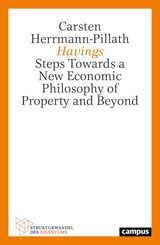 Havings: Steps Towards a New Economic Philosophy of Property and Beyond
Carsten Herrmann-Pillath
Campus Verlag, 2025 Redefines ownership by introducing the concept of “havings,” a radical framework that challenges the economic and legal foundations of capitalism and socialism.
Rethinking the foundations of ownership, Havings confronts conventional notions of property by introducing a radical new framework. Moving beyond the ideological constraints of capitalism and socialism, Carsten Herrmann-Pillath investigates how “having” can reshape economic and legal thought. Through an analysis of appropriation and assignment alongside possession and ownership, the book redefines the structures that govern our relationships with material and immaterial assets.
Through a blend of economic theory, sociology, and philosophy, Havings presents two compelling cases that demonstrate the real-world implications of this shift in perspective. The final chapter offers a daring vision for a post-capitalist economic system grounded in the multidimensionality of having. A thought-provoking read for those interested in economics, law, and social sciences, this work opens up new pathways for reimagining economic systems and property rights in an era of increasing inequality and global transformation.
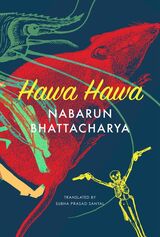 Hawa Hawa: and Other Stories
Nabarun Bhattacharya
Seagull Books, 2022 A collection of inventive and surprising short stories from one of India’s most prominent countercultural writers.
In this wildly inventive collection of Nabarun Bhattacharya’s stories, we meet characters such as a trigger-happy cop in an authoritarian police state, a man who holds on to a piece of rope from a deadly noose, a retired revolutionary thrilled by delusions of grandeur, and people working for a corporation that arranges lavish suicides for a price. Ranging from scathing satires of society to surreal investigations of violence and love, these stories are also a window onto the political and social climate in Bengal, tracing both pan-Indian developments like the 1975 Emergency and local ones like militant-leftist Naxalism and the decades-long Communist reign in the state. Expertly translated from the Bengali, Hawa Hawa and Other Stories is a journey through the mind of one of the most daring countercultural writers of India, one with particular resonance in these chaotic times.
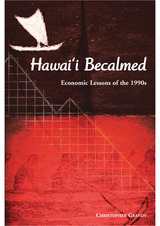 Hawai‘i Becalmed: Economic Lessons of the 1990s
Christopher Grandy
University of Hawaii Press, 2002 "At the annual average rate of growth Hawaii experienced between 1959 and 1990, the size of the economy would double every 14 years. At the rate of growth experienced between 1991 and 1998, it would take 93 years for Hawaii's economy to double in size."--from the Introduction
What happened during the decade of the 1990s that caused Hawaii's once full economic sails to deflate, leaving the economy in the doldrums? What can Hawaii's leaders do to revive economic growth-or can anything be done? What lessons does this period of prolonged economic stagnation hold for those who care about Hawaii's future?
The author recounts many of the external and internal events that affected Hawaii during the 1990s, their long-term economic impact, and the issues our elected policymakers must address to restart our economy. After a period of denial, Hawaii's leaders began exploring a wide variety of policies designed to remove perceived competitive barriers and to stimulate the economy. These efforts culminated in policy initiatives that may have assured Governor Ben Cayetano's re-election in 1998. Subsequent economic recovery permitted the pursuit of more questionable economic policies, but the tragic events of 9-11 remind us of the tenuous nature of Hawaii's economic recovery.
This highly readable book will challenge students, businesspeople, social scientists, and government leaders to think about the significant issues associated with a near zero-growth economy, and ways to revitalize our economy. A fundamental understanding of Hawaii's position in the global economy-and the challenges it poses for public policy-is essential for all citizens before effective decisions can be made on how to move Hawaii's economy forward.
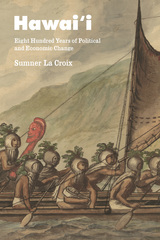 Hawai'i: Eight Hundred Years of Political and Economic Change
Sumner La Croix
University of Chicago Press, 2019 Relative to the other habited places on our planet, Hawai‘i has a very short history. The Hawaiian archipelago was the last major land area on the planet to be settled, with Polynesians making the long voyage just under a millennium ago. Our understanding of the social, political, and economic changes that have unfolded since has been limited until recently by how little we knew about the first five centuries of settlement.
Building on new archaeological and historical research, Sumner La Croix assembles here the economic history of Hawai‘i from the first Polynesian settlements in 1200 through US colonization, the formation of statehood, and to the present day. He shows how the political and economic institutions that emerged and evolved in Hawai‘i during its three centuries of global isolation allowed an economically and culturally rich society to emerge, flourish, and ultimately survive annexation and colonization by the United States. The story of a small, open economy struggling to adapt its institutions to changes in the global economy, Hawai‘i offers broadly instructive conclusions about economic evolution and development, political institutions, and native Hawaiian rights.
 Hawai'i Is My Haven: Race and Indigeneity in the Black Pacific
Nitasha Tamar Sharma
Duke University Press, 2021 Hawaiʻi Is My Haven maps the context and contours of Black life in the Hawaiian Islands. This ethnography emerges from a decade of fieldwork with both Hawaiʻi-raised Black locals and Black transplants who moved to the Islands from North America, Africa, and the Caribbean. Nitasha Tamar Sharma highlights the paradox of Hawaiʻi as a multiracial paradise and site of unacknowledged antiBlack racism. While Black culture is ubiquitous here, African-descended people seem invisible. In this formerly sovereign nation structured neither by the US Black/White binary nor the one-drop rule, nonWhite multiracials, including Black Hawaiians and Black Koreans, illustrate the coarticulation and limits of race and the native/settler divide. Despite erasure and racism, nonmilitary Black residents consider Hawaiʻi their haven, describing it as a place to “breathe” that offers the possibility of becoming local. Sharma's analysis of race, indigeneity, and Asian settler colonialism shifts North American debates in Black and Native studies to the Black Pacific. Hawaiʻi Is My Haven illustrates what the Pacific offers members of the African diaspora and how they in turn illuminate race and racism in “paradise.”
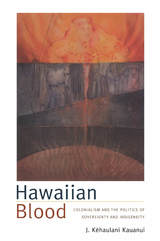 Hawaiian Blood: Colonialism and the Politics of Sovereignty and Indigeneity
J. Kauanui Kahaulani
Duke University Press, 2008 In the Hawaiian Homes Commission Act (HHCA) of 1921, the U.S. Congress defined “native Hawaiians” as those people “with at least one-half blood quantum of individuals inhabiting the Hawaiian Islands prior to 1778.” This “blood logic” has since become an entrenched part of the legal system in Hawai‘i. Hawaiian Blood is the first comprehensive history and analysis of this federal law that equates Hawaiian cultural identity with a quantifiable amount of blood. J. Kēhaulani Kauanui explains how blood quantum classification emerged as a way to undermine Native Hawaiian (Kanaka Maoli) sovereignty. Within the framework of the 50-percent rule, intermarriage “dilutes” the number of state-recognized Native Hawaiians. Thus, rather than support Native claims to the Hawaiian islands, blood quantum reduces Hawaiians to a racial minority, reinforcing a system of white racial privilege bound to property ownership. Kauanui provides an impassioned assessment of how the arbitrary correlation of ancestry and race imposed by the U.S. government on the indigenous people of Hawai‘i has had far-reaching legal and cultural effects. With the HHCA, the federal government explicitly limited the number of Hawaiians included in land provisions, and it recast Hawaiians’ land claims in terms of colonial welfare rather than collective entitlement. Moreover, the exclusionary logic of blood quantum has profoundly affected cultural definitions of indigeneity by undermining more inclusive Kanaka Maoli notions of kinship and belonging. Kauanui also addresses the ongoing significance of the 50-percent rule: Its criteria underlie recent court decisions that have subverted the Hawaiian sovereignty movement and brought to the fore charged questions about who counts as Hawaiian.
Hawaiian Music in Motion: Mariners, Missionaries, and Minstrels
James Revell Carr
University of Illinois Press, 2014 Hawaiian Music in Motion explores the performance, reception, transmission, and adaptation of Hawaiian music on board ships and in the islands, revealing the ways both maritime commerce and imperial confrontation facilitated the circulation of popular music in the nineteenth century. James Revell Carr draws on journals and ships' logs to trace the circulation of Hawaiian song and dance worldwide as Hawaiians served aboard American and European ships. He also examines important issues like American minstrelsy in Hawaii and the ways Hawaiians achieved their own ends by capitalizing on Americans' conflicting expectations and fraught discourse around hula and other musical practices.
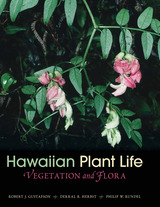 Hawaiian Plant Life: Vegetation and Flora
Robert J. Gustafson, Derral R. Herbst, and Philip W. Rundel
University of Hawaii Press, 2014 Hawaiian Plant Life has been written with both the layperson and professional interested in Hawai‘i’s natural history and flora in mind. In addition to significant text describing landforms and vegetation, the evolution of Hawaiian flora, and the conservation of native species, the book includes almost 875 color photographs illustrating nearly two-thirds of native Hawaiian plant species as well as a concise description of each genus and species shown. The work can be used either as a stand-alone reference or as a companion to the two-volume Manual of the Flowering Plants of Hawai‘i.
Learning more about threatened and endangered plants is essential to conserving them, and there is no more endangered flora in the world today than that of the Hawaiian Islands. Striking species complexes such as the silverswords and the remarkable lobeliads represent unique stories of adaptive radiation that make the Hawai‘i a living laboratory for evolution. Public appreciation for Hawaiian biodiversity requires outreach and education that will determine the future conservation of this rich heritage, and Hawaiian Plant Life has been designed to help fill that need.
Hawaii’s Past in a World of Pacific Islands
James M. Bayman
University Press of Colorado, 2013 Given its relatively late encounter with the West, Hawaii offers an exciting opportunity to study a society whose traditional lifeways and technologies were recorded in native oral traditions and written documents before they were changed by contact with non-Polynesian cultures. This book in the SAA Press Current Perspectives Series chronicles the role of archaeology in constructing a narrative of Hawaii’s cultural past, focusing on material evidence dating from the Polynesians’ first arrival on Hawaii’s shores about a millennium ago to the early decades of settlement by Americans and Europeans in the nineteenth century. A final chapter discusses new directions taken by native Hawaiians toward changing the practice of archaeology in the islands today.
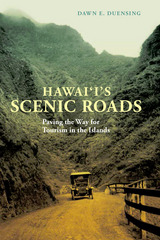 Hawai`i's Scenic Roads: Paving the Way for Tourism in the Islands
Dawn E. Duensing
University of Hawaii Press, 2015 Hawai‘i’s Scenic Roads examines a century of overland transportation from the kingdom’s first constitutional government until World War II, discovering how roads in the world’s most isolated archipelago rivaled those on the continental U.S. Building Hawai‘ i’s roads was no easy feat, as engineers confronted a unique combination of circumstances: extreme isolation, mountainous topography, torrential rains, deserts, volcanic eruptions, earthquakes, and on Haleakalā, freezing temperatures. By investigating the politics and social processes that facilitated road projects, Hawai‘i’s Scenic Roads explains that foreign settlers wanted roads to “civilize” the Hawaiians and promote economic development, specifically agriculture. Once sugar became the dominant driver, civic and political leaders turned their attention to constructing scenic roads. Viewed as “commercial enterprises,” scenic byways became an essential factor in establishing tourism as Hawai‘i’s “third crop” after sugar and pineapple. These thoroughfares also served as playgrounds for the islands’ elite residents and wealthy visitors who could afford the luxury of carriage driving, and after 1900, motorcars. Duensing’s provocative analysis of the 1924 Hawai‘i Bill of Rights reveals that roads played a critical role in redefining the Territory of Hawai‘i’s status within the United States. Politicians and civic leaders focused on highway funding to argue that Hawai‘i was an “integral part of the Union,” thus entitled to be treated as if it were a state. By accepting this Bill of Rights, Congress confirmed the territory’s claim to access federal programs, especially highway aid. Washington’s involvement in Hawai‘i increased subsequently, as did the islands’ dependence on the national government. Federal money helped the territory weather the Great Depression as it became enmeshed in New Deal programs and philosophy. Although primarily an economic protest, the Hawai‘i Bill of Rights was a crucial stepping stone on the path to eventual statehood in 1959. At the core of this book is the intriguing tales of road projects that established the islands' most renowned scenic drives, including the Pali Highway, byways around Kīlauea Volcano, Haleakalā Highway, and the Hāna Belt Road. The author’s unique approach provides a fascinating perspective for understanding Hawai‘i’s social dynamics, as well as its political, environmental, and economic history.
The Hawk Is Hungry and Other Stories
D'Arcy McNickle; Edited by Birgit Hans
University of Arizona Press, 1992 These sixteen stories—ten of which have not been previously published—represent the work of one of the most influential Native American writers of the twentieth century—held by many to be the most important Native Americans to write fiction before N. Scott Momaday. Birgit Hans's introductory essay provides a brief biography of McNickle, sets the stories in the context of his better known work, and provides insights into their literary significance. Together, they constitute a collection essential to an adequate understanding of McNickle and of the development of Native American fiction.
CONTENTS
The Reservation
Hard Riding
En roulant ma boule, roulant...
Meat for God
Snowfall
Train Time
Montana
The Hawk Is Hungry
Debt of Gratitude
Newcomers
Man's Work
Going to School
The City
Manhattan Wedlock
Let the War Be Fought
In the Alien Corn
Six Beautiful in Paris
The Silver Locket
Hawker Hunter: the story of a thoroughbred
Sreco Bradic
Amsterdam University Press, 2023 The most successful British jet fighter produced was without doubt the sleek and graceful Hawker Hunter. As usual for every new aircraft type it had its share of teething problems, but once these were all adequately solved the U.K. had at that time one of the best jet fighters available. It was built in large numbers and exported to many countries.
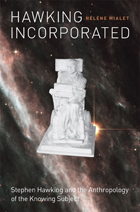 Hawking Incorporated: Stephen Hawking and the Anthropology of the Knowing Subject
Hélène Mialet
University of Chicago Press, 2012 These days, the idea of the cyborg is less the stuff of science fiction and more a reality, as we are all, in one way or another, constantly connected, extended, wired, and dispersed in and through technology. One wonders where the individual, the person, the human, and the body are—or, alternatively, where they stop. These are the kinds of questions Hélène Mialet explores in this fascinating volume, as she focuses on a man who is permanently attached to assemblages of machines, devices, and collectivities of people: Stephen Hawking.
Drawing on an extensive and in-depth series of interviews with Hawking, his assistants and colleagues, physicists, engineers, writers, journalists, archivists, and artists, Mialet reconstructs the human, material, and machine-based networks that enable Hawking to live and work. She reveals how Hawking—who is often portrayed as the most singular, individual, rational, and bodiless of all—is in fact not only incorporated, materialized, and distributed in a complex nexus of machines and human beings like everyone else, but even more so. Each chapter focuses on a description of the functioning and coordination of different elements or media that create his presence, agency, identity, and competencies. Attentive to Hawking’s daily activities, including his lecturing and scientific writing, Mialet’s ethnographic analysis powerfully reassesses the notion of scientific genius and its associations with human singularity. This book will fascinate anyone interested in Stephen Hawking or an extraordinary life in science.
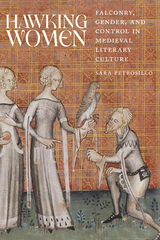 Hawking Women: Falconry, Gender, and Control in Medieval Literary Culture
Sara Petrosillo
Ohio State University Press, 2023 While critical discourse about falconry metaphors in premodern literature is dominated by depictions of women as unruly birds in need of taming, women in the Middle Ages claimed the symbol of a hawking woman on their personal seals, trained and flew hawks, and wrote and read poetic texts featuring female falconers. Sara Petrosillo’s Hawking Women demonstrates how cultural literacy in the art of falconry mapped, for medieval readers, onto poetry and challenged patriarchal control. Examining texts written by, for, or about women, Hawking Women uncovers literary forms that arise from representations of avian and female bodies. Readings from Sir Orfeo, Chrétien de Troyes, Guillaume de Machaut, Chaucer’s Troilus and Criseyde, and hawking manuals, among others, show how female characters are paired with their hawks not to assert dominance over the animal but instead to recraft the stand-in of falcon for woman as falcon with woman. In the avian hierarchy female hawks have always been the default, the dominant, and thus these medieval interspecies models contain lessons about how women resisted a culture of training and control through a feminist poetics of the falconry practice.
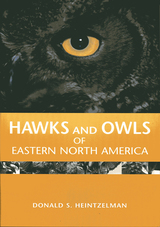 Hawks and Owls of Eastern North America
Heintzelman, Donald S.
Rutgers University Press, 2004 Hawks and owls, or raptors, as they are sometimes called, are charismatic birds. Ranging in size from the majestic bald eagle to the tiny northern saw-whet owl, these fascinating creatures occupy forests, woodlots, fields, and wetlands, as well as urban parks and tree-lined city streets. The adventurous peregrine falcon has even been spotted on the cliff-like skyscrapers and tall bridges of New York City and Philadelphia. Raptors are all around us-all we need to do is look for them at the right times, in the right places. Hawks and Owls of Eastern North America provides a readable, accessible introduction to our native birds of prey. Illustrated with over eighty black and white and thirty stunning color photographs, this natural history guide introduces readers to these incredible birds, describing their identifying characteristics, their behaviors, their habitats, and what's being done to protect them. In chapters on citizen science and recreation, readers will learn how they can experience raptors firsthand through study and observation. Birders, hawk and owl watchers, nature and wildlife photographers, youth groups, and high school and college students can all turn to this book as a reliable source of information on birds of prey.
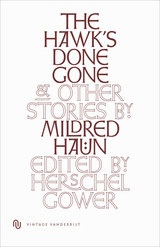 The Hawk's Done Gone
Mildred Haun
Vanderbilt University Press, 1968 The stores of Mildred Haun, collected here for the first time, are unique in the annals of American literature. Set in the Smoky Mountains of East Tennessee and covering a span of family history from the Civil War to 1940, these tales achieve the forceful, intractable simplicity of the traditional ballads. But one also finds in these twenty-three stories an overview of the forces of nature, the paradoxes inherent in the human condition, and a full acceptance of the real world and the supernatural. Born to the milieu about which she wrote, Mildred Haun recorded a world which combined stark natural phenomena and passionate supernatural forces. And because the supernatural is woven into the dramatic fabric of the stories, it contributes, paradoxically, to the final credibility of events. Few writers in the twentieth century have set down so rich and complex a rendering of folk tradition and such a comprehensive treatment of superstition in the southern Appalachians. In these tales we meet a talking apple tree, a boy with the “hant bleach” of doom upon his brow, a bleeding ghost, a child’s winding sheet wet with tears, and God’s revelation in a blue bird. No other dialect collection from the South has been as close to the oral tradition or has achieved the same distinctive flavor and natural tonal qualities. The speech strikes the ear directly from the printed page. The language is simple and strong. A sparse, direct economy prevails. The total impact is explosive. Although Miss Haun dramatized themes of cruelty, revenge, and the loss of personal dignity in a harsh world, the comic tales in this volume call to mind the Native American humor of the Old Southwest and demonstrate that a female humorist, without coyness or bawdry, can hold her own alongside Davy Crockett, Sut Lovingood, and the nameless spinners of tall tales.
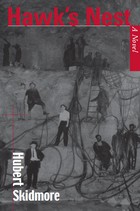 Hawk's Nest: A Novel
Hubert Skidmore
University of Tennessee Press, 2004 Appalachian Echoes
Thomas E. Douglass, series fiction editor
The building of a tunnel at Gauley Bridge, West Virginia, beginning in 1930 has been called the worst industrial disaster in American history: more died there than in the Triangle Shirtwaist Factory fire and the Sunshine and Farmington mine disasters combined. And when native West Virginian Hubert Skidmore tried to tell the real story in his 1941 novel, Union Carbide and Carbon Corporation apparently convinced publisher Doubleday, Doran & Co. to pull the book from publication after only a few hundred copies had appeared.
Now the Appalachian Echoes series makes Hawk’s Nest available to a new generation of readers. This is the riveting tale of starving men and women making their way from all over the Depression-era United States to the hope and promise of jobs and a new life. What they find in West Virginia is “tunnelitis,” or silicosis, a disease which killed at least seven hundred workers—probably many more—a large number of them African American, virtually all of them poor. Skidmore’s roman à clef provides a narrative with emotional drive, interwoven with individual stories that capture the hopes and the desperation of the Depression: the Reips who come from the farm with their pots and pans and hard-working children, the immigrants Pete and Anna, kind waitress Lessie Lee, and “hobos” Jim Martin, “Long” Legg, and Owl Jones, the last of whom, as an African American, receives the worst treatment. This important story of conscience encompasses labor history, Appalachian studies, and literary finesse.
Hawks of the Sun: Mapuche Morality and Its Ritual Attributes
L. C. Faron
University of Pittsburgh Press, 1964
Southern central Chile supports one of the largest functioning indigenous societies in South America, the Mapuche, who have withstood more than four hundred years of persistent efforts at colonization and missionization. In spite of inevitable cultural and social change during those years, they have maintained a great measure of cultural and social integrity, and remain a regional, ethically conscious minority in Chile.
The Mapuche, in their own words, are “another race,” with their own gods, their own notions of right and wrong, their own symbolism. Abiding by the rules of their society ensures their eternal place among the hawks of the sun.
Hawksmoor's London Churches: Architecture and Theology
Pierre de la Ruffinière du Prey
University of Chicago Press, 2000 Six remarkable churches built by Nicholas Hawksmoor from 1712 to 1731 still stand in London. In this book, architectural historian Pierre de la Ruffinière du Prey examines these designs as a coherent whole—a single masterpiece reflecting both Hawksmoor's design principles and his desire to reconnect, architecturally, with the "purest days of Christianity."
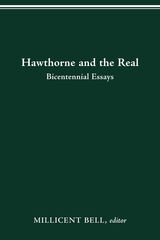 HAWTHORNE AND THE REAL: BICENTENNIAL ESSAYS
MILLICENT BELL
Ohio State University Press, 2005 In this edited collection commemorating the bicentennial of Hawthorne’s birth in 1804, Millicent Bell gathers essays by distinguished scholars and critics that examine the ways in which Hawthorne related himself to the “real” in his own world and expressed that relation in his writing. Radically revising the older view that he was detached from conditions of actual life in 19th-century American society, the authors undertake to show how current social conditions, current events, and political movements taking place at a crucial point in American history were an evident part of Hawthorne’s consciousness. The essays situate his imaginative writings in a contemporary context of common experience and rediscover a Hawthorne alert to pressing problems of his day, especially slavery, feminism, and reform in general—the very issues that motivated his contemporaries on the eve of the Civil War. Hawthorne was, with his own complicity, long described as a writer of unreal romances (as he preferred to call his novels) or “allegories of the heart” as he termed some of his short stories. But the literary mode of his fiction has long needed to be redefined. The essays in this collection contribute to the turn in recent Hawthorne criticism which shows how deeply implicated in realism his writing was. This volume should long continue to provide new starting points for changing views of a great writer. Contributors: - Millicent Bell
- Nina Baym
- Michael T. Gilmore
- Leland S. Person
- David Leverenz
- Larry J. Reynolds
- Lawrence Buell
- Rita K. Gollin
- John Carlos Row
- Brenda Wineapple
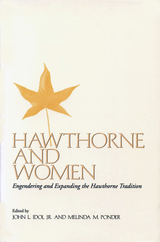 Hawthorne and Women: Engendering and Expanding the Hawthorne Tradition
John L. Idol
University of Massachusetts Press, 1999 Nathaniel Hawthorne is notorious for complaining in a letter to one of his publishers that a "damn'd mob of scribbling women" was stealing his audience. Elsewhere, he referred to women authors as "ink-stained Amazons" who were "without a single exception, detestable," and once expressed his wish that all women be "forbidden to write, on pain of having their faces deeply scarified with an oyster-shell."
This collection of original essays presents a more complex and positive view of Hawthorne's attitudes toward women, demonstrating his recognition of the crucial role that women played--as critics, reviewers, readers, and authors--in building a national readership that made his writing career so successful.
The book begins with an examination of the influence exerted by the women in Hawthorne's immediate family. It goes on to explore his links to a broad range of women writers, as well as his attitudes toward the female characters he created. Among the authors discussed are Margaret Fuller, Harriet Beecher Stowe, Louisa May Alcott, Emily Dickinson, Sarah Orne Jewett, Willa Cather, Charlotte Perkins Gilman, George Eliot, Virginia Woolf, Flannery O'Connor, and Toni Morrison.
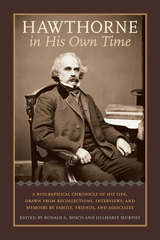 Hawthorne in His Own Time: A Biographical Chronicle of His Life,Drawn from Recollections,Interviews, and Memoirs by Family,Frie
Ronald A Bosco
University of Iowa Press, 2007 At his death, Nathaniel Hawthorne (1804–1864) was universally acknowledged in America and England as "the Great Romancer." Novels such as The Scarlet Letter and The House of the Seven Gables and stories published in such collections as Twice-Told Tales continue to capture the minds and imaginations of readers and critics to this day. Harder to capture, however, were the character and personality of the man himself. So few of the essays that appeared in the two years after his death offered new insights into his life, art, and reputation that Hawthorne seemed fated to premature obscurity or, at least, permanent misrepresentation. This first collection of personal reminiscences by those who knew Hawthorne intimately or knew about him through reliable secondary sources rescues him from these confusions and provides the real human history behind the successful writer. Remembrances from Elizabeth Peabody, Sophia Hawthorne, Oliver Wendell Holmes, Ralph Waldo Emerson, Bronson Alcott, Rebecca Harding Davis, and twenty others printed in Hawthorne in His Own Time follow him from his childhood in Salem, through his years of initial literary obscurity, his days in the Boston and Salem Custom Houses, his service as U.S. Consul to Liverpool and Manchester and his life in the Anglo-American communities at Rome and Florence, to his late years as the "Great Romancer." In their enlightening introduction, editors Ronald Bosco and Jillmarie Murphy assess the postmortem building of Hawthorne's reputation as well as his relationship to the prominent Transcendentalists, spiritualists, Swedenborgians, and other personalities of his time. By clarifying the sentimental associations between Hawthorne's writings and his actual personality and moving away from the critical review to the personal narrative, these artful and perceptive reminiscences tell the private and public story of a remarkable life.
Hawthorne’s Conception of the Creative Process
Richard J. Jacobson
Harvard University Press Richard Jacobson examines and delineates the processes of mind that Hawthorne conceived of as underlying the creative act. Taking issue with previous studies that have presented the novelist as an adherent of one or another of the particular schools of thought representative of his time, the author demonstrates that Hawthorne's views were, in fact, eclectically formed and were a fusion of classical and romantic attitudes. His intense preoccupation with the relationship between art and morality, and the validation of imaginative insights are central elements, Jacobson maintains, in Hawthorne's theory of the creative process.
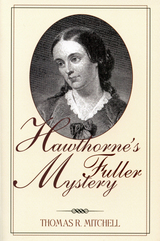 Hawthorne's Fuller Mystery
Thomas R. Mitchell
University of Massachusetts Press, 2009 This book explores the deeply emotional yet enigmatic relationship between two nineteenth-century American writers, showing how Margaret Fuller's radical ideas about women's rights, equality of the sexes, and the nature of marriage influenced Nathaniel Hawthorne's writing.
Drawing on recently published letters and journals, Thomas R. Mitchell describes how Julian Hawthorne's misrepresentation of his father's relationship with Fuller destroyed her literary reputation, promoted Hawthorne as a defender of conservative values, and continues to obscure the depth of Hawthorne's personal and intellectual involvement with her. Mitchell concludes that far from being repulsed by Fuller and her assertiveness--as many scholars have claimed--Hawthorne experienced with her perhaps the most intimate relationship that he ever had with a woman, his wife alone excepted.
Blending biography, cultural history, and literary and psychological analysis, Hawthorne's Fuller Mystery raises provocative questions about the origins and intent of Hawthorne's greatest works and offers compelling new readings of "Rapaccini's Daughter," The Scarlet Letter, The Blithedale Romance, and The Marble Faun.
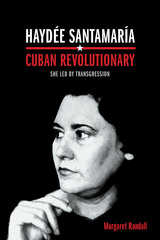 Haydée Santamaría, Cuban Revolutionary: She Led by Transgression
Margaret Randall
Duke University Press, 2015 Taking part in the Cuban Revolution's first armed action in 1953, enduring the torture and killings of her brother and fiancé, assuming a leadership role in the underground movement, and smuggling weapons into Cuba, Haydée Santamaría was the only woman to participate in every phase of the Revolution. Virtually unknown outside of Cuba, Santamaría was a trusted member of Fidel Castro's inner circle and friend of Che Guevara. Following the Revolution's victory Santamaría founded and ran the cultural and arts institution Casa de las Americas, which attracted cutting-edge artists, exposed Cubans to some of the world's greatest creative minds, and protected queer, black, and feminist artists from state repression. Santamaría's suicide in 1980 caused confusion and discomfort throughout Cuba; despite her commitment to the Revolution, communist orthodoxy's disapproval of suicide prevented the Cuban leadership from mourning and celebrating her in the Plaza of the Revolution. In this impressionistic portrait of her friend Haydée Santamaría, Margaret Randall shows how one woman can help change the course of history.
 Haydn and the Classical Variation
Elaine R. Sisman
Harvard University Press, 1993 In this first full-scale examination of the theme-and-variations form in the Classical era, Elaine Sisman demonstrates persuasively that it was Haydn's prophetic innovationsplacing the variation in every position of a multi-movement cycle, broadening its array of theme types, and transforming its larger shapethat truly created the Classical variation. She elucidates the concept and technique of variation, traces Haydn's development and use of the form in symphonies, chamber music, and keyboard works, and then shows how Mozart and Beethoven in their individual ways built on his contributions.
Throughout, Sisman's analysis reflects both musical thinking of the Classical period and today's critical interests. She discusses ornamentation and musical figures, explores the pervasive eighteenth-century notion of music as rhetoric, and relates the style of the variation to that of the other dominant form in this period: sonata form. Her book offers a revaluation of the nature of the variation form and a new approach to the music of Haydn. Haydn and the Classical Variation is addressed to students and scholars of music, but the author's unaffected style makes it accessible to nonprofessional music lovers as well.
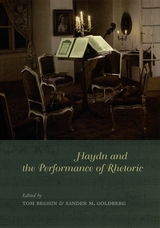 Haydn and the Performance of Rhetoric
Edited by Tom Beghin and Sander M. Goldberg
University of Chicago Press, 2007 Haydn is the last major composer whose music was regularly discussed by his contemporaries in terms derived from the classical tradition of rhetoric. Within a generation of his death, that discourse had fallen from favor, but the historical relationship between Haydn and the rhetorical tradition endured.
In this volume, a distinguished group of contributors in fields from classics to literature to musicology restores the rhetorical model to prominence and shows what can be achieved by returning to the idea of music as a rhetorical process. An accompanying DVD, specially designed for this project, presents performances and illustrations keyed to its chapters, making musicological arguments accessible to nonspecialists and advancing additional arguments of its own through the medium of performance. The volume thus reaches beyond musicology to enrich and complicate the larger debate over rhetoric's role in eighteenth-century culture.
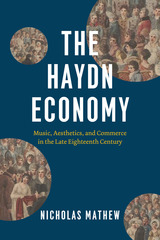 The Haydn Economy: Music, Aesthetics, and Commerce in the Late Eighteenth Century
Nicholas Mathew
University of Chicago Press, 2022 Analyzing the final three decades of Haydn’s career, this book uses the composer as a prism through which to examine urgent questions across the humanities.
In this far-reaching work of music history and criticism, Nicholas Mathew reimagines the world of Joseph Haydn and his contemporaries, with its catastrophic upheavals and thrilling sense of potential. In the process, Mathew tackles critical questions of particular moment: how we tell the history of the European Enlightenment and Romanticism; the relation of late eighteenth-century culture to incipient capitalism and European colonialism; and how the modern market and modern aesthetic values were—and remain—inextricably entwined.
The Haydn Economy weaves a vibrant material history of Haydn’s career, extending from the sphere of the ancient Esterházy court to his frenetic years as an entrepreneur plying between London and Vienna to his final decade as a venerable musical celebrity, during which he witnessed the transformation of his legacy by a new generation of students and acolytes, Beethoven foremost among them. Ultimately, Mathew asserts, Haydn’s historical trajectory compels us to ask what we might retain from the cultural and political practices of European modernity—whether we can extract and preserve its moral promise from its moral failures. And it demands that we confront the deep histories of capitalism that continue to shape our beliefs about music, sound, and material culture.
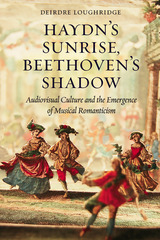 Haydn’s Sunrise, Beethoven’s Shadow: Audiovisual Culture and the Emergence of Musical Romanticism
Deirdre Loughridge
University of Chicago Press, 2016 The years between roughly 1760 and 1810, a period stretching from the rise of Joseph Haydn’s career to the height of Ludwig van Beethoven’s, are often viewed as a golden age for musical culture, when audiences started to revel in the sounds of the concert hall. But the latter half of the eighteenth century also saw proliferating optical technologies—including magnifying instruments, magic lanterns, peepshows, and shadow-plays—that offered new performance tools, fostered musical innovation, and shaped the very idea of “pure” music. Haydn’s Sunrise, Beethoven’s Shadow is a fascinating exploration of the early romantic blending of sight and sound as encountered in popular science, street entertainments, opera, and music criticism.
Deirdre Loughridge reveals that allusions in musical writings to optical technologies reflect their spread from fairgrounds and laboratories into public consciousness and a range of discourses, including that of music. She demonstrates how concrete points of intersection—composers’ treatments of telescopes and peepshows in opera, for instance, or a shadow-play performance of a ballad—could then fuel new modes of listening that aimed to extend the senses. An illuminating look at romantic musical practices and aesthetics, this book yields surprising relations between the past and present and offers insight into our own contemporary audiovisual culture.
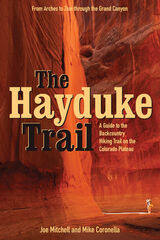 The Hayduke Trail: A Guide to the Backcountry Hiking Trail on the Colorado Plateau
Joe Mitchell
University of Utah Press, 2005 Traversing six national parks (Arches, Canyonlands, Capitol Reef, Bryce, Grand Canyon, Zion), a national recreation area, a national monument, and various wilderness, primitive, and wilderness study areas, the Hayduke Trail is a challenging, 800-mile backcountry route on the Colorado Plateau. Whimsically named for a character in Edward Abbey’s The Monkey Wrench Gang, the trail begins in Arches National Park and ends in Zion National Park, stays entirely on public land, and traverses the complete variety of terrain available to hikers on the Plateau short of technical climbing.
Joe Mitchell and Mike Coronella pioneered Hayduke after concluding that a long trail—such as the Appalachian or Pacific Crest— was possible on the Plateau, thus introducing more people to these unique and threatened public lands. The Hayduke Trail includes detailed maps of the entire route, suggested cache points, and a wealth of description and tips for tackling this intense undertaking.
Hiking the entire route requires at least three months, though like other long trails it can be broken into smaller segments. The guide, featured in the March 2005 issue of National Geographic Adventure Magazine, is designed for experienced desert trekkers seeking a thorough-hiking experience on a well-tested route.
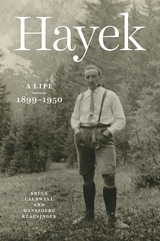 Hayek: A Life, 1899–1950
Bruce Caldwell and Hansjoerg Klausinger
University of Chicago Press, 2022 A 2022 Economist Best Book of the Year.
The definitive account of the distinguished economist’s formative years.
Few twentieth-century figures have been lionized and vilified in such equal measure as Friedrich Hayek—economist, social theorist, leader of the Austrian school of economics, and champion of classical liberalism. Hayek’s erudite arguments in support of individualism and the market economy have attracted a devout following, including many at the levers of power in business and government. Critics, meanwhile, cast Hayek as the intellectual forefather of “neoliberalism” and of all the evils they associate with that pernicious doctrine.
In Hayek: A Life, historians of economics Bruce Caldwell and Hansjörg Klausinger draw on never-before-seen archival and family material to produce an authoritative account of the influential economist’s first five decades. This includes portrayals of his early career in Vienna; his relationships in London and Cambridge; his family disputes; and definitive accounts of the creation of The Road to Serfdom and of the founding meeting of the Mont Pèlerin Society.
A landmark work of history and biography, Hayek: A Life is a major contribution both to our cultural accounting of a towering figure and to intellectual history itself.
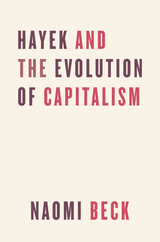 Hayek and the Evolution of Capitalism
Naomi Beck
University of Chicago Press, 2018 Few economists can claim the influence—or fame—of F. A. Hayek. Winner of the Nobel Prize, Hayek was one of the most consequential thinkers of the twentieth century, his views on the free market echoed by such major figures as Ronald Reagan and Margaret Thatcher.
Yet even among those who study his work in depth, few have looked closely at his use of ideas from evolutionary science to advance his vision of markets and society. With this book Naomi Beck offers the first full-length engagement with Hayek’s thought from this perspective. Hayek argued that the capitalism we see in advanced civilizations is an unintended consequence of group selection—groups that adopted free market behavior expanded more successfully than others. But this attempt at a scientific grounding for Hayek’s principles, Beck shows, fails to hold water, plagued by incoherencies, misinterpretations of the underlying science, and lack of evidence. As crises around the globe lead to reconsiderations of the place of capitalism, Beck’s excavation of this little-known strand of Hayek’s thought—and its failure—is timely and instructive.
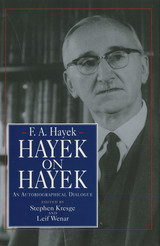 Hayek on Hayek: An Autobiographical Dialogue
F. A. Hayek
University of Chicago Press, 1994 The crumbling of the Berlin Wall, the fall of the iron curtain, and the Reagan and Thatcher "revolutions" all owe a tremendous debt to F. A. Hayek. Economist, social and political theorist, and intellectual historian, Hayek passionately championed individual liberty and condemned the dangers of state control. Now Hayek at last tells the story of his long and controversial career, during which his fortunes rose, fell, and finally rose again.
Through a complete collection of previously unpublished autobiographical sketches and a wide selection of interviews, Hayek on Hayek provides the first detailed chronology of Hayek's early life and education, his intellectual progress, and the academic and public reception of his ideas. His discussions range from economic methodology and the question of religious faith to the atmosphere of post-World War I Vienna and the British character.
Born in 1899 into a Viennese family of academics and civil servants, Hayek was educated at the University of Vienna, fought in the Great War, and later moved to London, where, as he watched liberty vanish under fascism and communism across Europe, he wrote The Road to Serfdom. Although this book attracted great public attention, Hayek was ignored by other economists for thirty years after World War II, when European social democracies boomed and Keynesianism became the dominant intellectual force. However, the award of the Nobel Prize in economics for 1974 signaled a reversal in Hayek's fortunes, and before his death in 1992 he saw his life's work vindicated in the collapse of the planned economies of Eastern Europe.
Hayek on Hayek is as close to an autobiography of Hayek as we will ever have. In his own eloquent words, Hayek reveals the remarkable life of a revolutionary thinker in revolutionary times.
"One of the great thinkers of our age who explored the promise and contours of liberty....[Hayek] revolutionized the world's intellectual and political life"—President George Bush, on awarding F. A. Hayek the Medal of Freedom
F. A. Hayek, recipient of the Medal of Freedom 1991 and the Nobel Memorial Prize in Economics in 1974, was a pioneer in monetary theory and the principal proponent of the libertarian philosophy. Hayek is the author of numerous books in economics, as well as books in political philosophy and psychology.
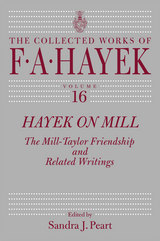 Hayek on Mill: The Mill-Taylor Friendship and Related Writings
F. A. Hayek
University of Chicago Press, 2015 Best known for reviving the tradition of classical liberalism, F. A. Hayek was also a prominent scholar of the philosopher John Stuart Mill. One of his greatest undertakings was a collection of Mill’s extensive correspondence with his longstanding friend and later companion and wife, Harriet Taylor-Mill. Hayek first published the Mill-Taylor correspondence in 1951, and his edition soon became required reading for any study of the nineteenth-century foundations of liberalism.
This latest addition to the University of Chicago Press’s Collected Works of F. A. Hayek series showcases the fascinating intersections between two of the most prominent thinkers from two successive centuries. Hayek situates Mill within the complex social and intellectual milieu of nineteenth-century Europe—as well as within twentieth-century debates on socialism and planning—and uncovers the influence of Taylor-Mill on Mill’s political economy. The volume features the Mill-Taylor correspondence and brings together for the first time Hayek’s related writings, which were widely credited with beginning a new era of Mill scholarship.
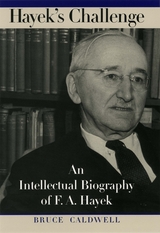 Hayek's Challenge: An Intellectual Biography of F.A. Hayek
Bruce Caldwell
University of Chicago Press, 2005 Friedrich A. Hayek is regarded as one of the preeminent economic theorists of the twentieth century, as much for his work outside of economics as for his work within it. During a career spanning several decades, he made contributions in fields as diverse as psychology, political philosophy, the history of ideas, and the methodology of the social sciences. Bruce Caldwell—editor of The Collected Works of F. A. Hayek—understands Hayek's thought like few others, and with this book he offers us the first full intellectual biography of this pivotal social theorist.
Caldwell begins by providing the necessary background for understanding Hayek's thought, tracing the emergence, in fin-de-siècle Vienna, of the Austrian school of economics—a distinctive analysis forged in the midst of contending schools of thought. In the second part of the book, Caldwell follows the path by which Hayek, beginning from the standard Austrian assumptions, gradually developed his unique perspective on not only economics but a broad range of social phenomena. In the third part, Caldwell offers both an assessment of Hayek's arguments and, in an epilogue, an insightful estimation of how Hayek's insights can help us to clarify and reexamine changes in the field of economics during the twentieth century.
As Hayek's ideas matured, he became increasingly critical of developments within mainstream economics: his works grew increasingly contrarian and evolved in striking—and sometimes seemingly contradictory—ways. Caldwell is ideally suited to explain the complex evolution of Hayek's thought, and his analysis here is nothing short of brilliant, impressively situating Hayek in a broader intellectual context, unpacking the often difficult turns in his thinking, and showing how his economic ideas came to inform his ideas on the other social sciences.
Hayek's Challenge will be received as one of the most important works published on this thinker in recent decades.
Hayek's The Road to Serfdom: A Brief Introduction
Bruce Caldwell
University of Chicago Press, 2013 The Road to Serfdom, F. A. Hayek’s 1944 warning against the dangers of government control, continues to influence politics more than seventy years after it was turned down by three American publishers and finally published by the University of Chicago Press. A classic work in political philosophy, intellectual and cultural history, and economics, the definitive edition of The Road to Serfdom included this essay as its Introduction. Here, acclaimed Hayek biographer and general editor of the Collected Works of F. A. Hayek series, Bruce Caldwell explains how Hayek came to write and publish the book, assesses misunderstandings of Hayek’s thought, and suggests how Hayek’s fears of Socialism lead him to abandon the larger scholarly project he had planned in 1940 to focus instead on a briefer, more popular and political tract—one that has influenced political and economic discourse ever since.
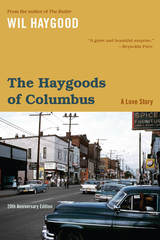 The Haygoods of Columbus: A Love Story
Wil Haygood
Ohio State University Press, 2016 Wil Haygood’s memoir of his hometown of Columbus, Ohio, is an uplifting and unsparing celebration of the ties that bind all loving American families. The lives of the Haygood clan—grandmother a hotel cook, mother a nightlife-loving waitress, father mostly absent, one brother a legendary pimp, the other a star-crossed dreamer, sisters whose fates included very little disposable income—were intertwined with that of Mount Vernon Avenue, a seductive street of shops, juke joints, and speakeasies at the epicenter of Columbus’s black community. Wil loved that avenue. Gifted and ambitious, he eventually found his first reporting terrain there, writing for the local paper, The Call & Post, while the first waves of urban renewal began to shake and shift the city of his childhood. Haygood tells here of his early passions: his fierce love for his restless mother, his enthusiasm for fishing in the Olentangy River, and his adolescent love of basketball, which drove him to ride buses surreptitiously.
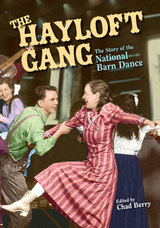 The Hayloft Gang: The Story of the National Barn Dance
Edited by Chad Berry
University of Illinois Press, 2007 The National Barn Dance was the nation's most popular country music radio show during the 1930s and 1940s. The pioneering radio program defined country and western entertainment until the Grand Ole Opry and rock 'n' roll supplanted it in the 1950s. Broadcast for more than three decades from Chicago on WLS's powerful 50,000-watt signal, the show reached listeners throughout the Midwest, the East Coast, and South, delivering popular entertainment to both rural and urban areas while celebrating the fading folk traditions of an increasingly urbanized America. The Hayloft Gang draws on the colorful commentary of performers and former listeners to analyze the National Barn Dance, its audience, and its impact. Contributors trace the history of barn dance radio, explore the paradox of a foundational country music program broadcast from a major city, investigate notions of authenticity in the presentation of country music and entertainment, and delve into provocative issues raised by the barn dance phenomenon. Contributors: Chad Berry, Michael T. Bertrand, Lisa Krissoff Boehm, Don Cusic, Wayne W. Daniel, Loyal Jones, Kristine M. McCusker, Stephen Parry, Susan Smulyan, Paul L. Tyler, and Michael Ann Williams.
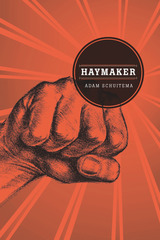 Haymaker
Adam Schuitema
Northern Illinois University Press, 2015 In a political culture infused with debates about personal liberties, the role of government, and even the definition of “freedom” itself, Haymaker tells the story of an isolated Michigan town that becomes the flashpoint for some of the principal ideological debates of our day. When a libertarian organization selects the town as its flagship community, hundreds of its members migrate and settle within the town’s borders. The resulting clash with local townspeople is violent and impassioned, even as the line that divides the two sides increasingly blurs.
The story follows characters on both of these sides: an eccentric millionaire known as The Man in White, who is still viewed as an outsider even after living in Haymaker for thirty years; a policewoman trained in hostage and suicide negotiations who questions raising children in this new environment; a teenage girl devoted to basketball and her desire to leave home, who has a close but complicated relationship with her uncle, a local who fistfights outsiders in an annual challenge; a libertarian PR expert, just hoping to calm the storm; and the town’s mayor, who owns a local diner and is raising a baby daughter as her husband becomes tragically unhinged.
A town first settled by lumberjacks, prostitutes, and roughnecks, Haymaker’s present becomes as volatile as its past. Haymaker is a story about the failure of best intentions and the personal freedom of individuals to do good or to harm. This witty and politically charged novel will certainly appeal to Michiganders and Midwesterners, but will also interest those looking for an entertaining fictional account of a situation that could plausibly play out in one of the many small, remote towns in the country.
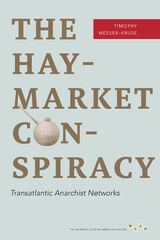 The Haymarket Conspiracy: Transatlantic Anarchist Networks
Timothy Messer-Kruse
University of Illinois Press, 2012 The Haymarket Conspiracy: Transatlantic Anarchist Networks traces the evolution of revolutionary anarchist ideas in Europe and their migration to the United States in the 1880s. A new history of the transatlantic origins of American anarchism, this study thoroughly debunks the dominant narrative through which most historians interpret the Haymarket Bombing and Trial of 1886–87.
Challenging the view that there was no evidence connecting the eight convicted workers to the bomb throwing at the Haymarket rally, Timothy Messer-Kruse examines police investigations and trial proceedings that reveal the hidden transatlantic networks, the violent subculture, and the misunderstood beliefs of Gilded Age anarchists. Messer-Kruse documents how, in the 1880s, radicals on both sides of the Atlantic came to celebrate armed struggle as the one true way forward and began to prepare seriously for conflict. Within this milieu, he suggests the possibility of a "Haymarket conspiracy": a coordinated plan of attack in which the oft-martyred Haymarket radicals in fact posed a real threat to public order and safety. Drawing on new, never-before published historical evidence, The Haymarket Conspiracy provides a new means of understanding the revolutionary anarchist movement on its own terms rather than in the romantic ways in which its agents have been eulogized.
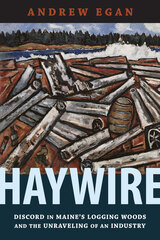 Haywire: Discord in Maine's Logging Woods and the Unraveling of an Industry
Andrew Egan
University of Massachusetts Press, 2022 Logging in the northern forest has been romanticized, with images of log drives, plaid shirts, and bunkhouses in wide circulation. Increasingly dismissed as a quaint, rural pastime, logging remains one of the most dangerous jobs in the United States, with loggers occupying a precarious position amid unstable markets, expanding global competition, and growing labor discord. Examining a time of transition and decline in Maine’s forest economy, Andrew Egan traces pathways for understanding the challenges that have faced Maine’s logging community and, by extension, the state’s forestry sector, from the postwar period through today.
Seeking greater profits, logging companies turned their crews loose at midcentury, creating a workforce of independent contractors who were forced to purchase expensive equipment and compete for contracts with the mills. Drawing on his own experience with the region’s forest products industry, interviews with Maine loggers, media coverage, and court documents, Egan follows the troubled recent history of the industry and its battle for survival.
Haywire: Poems
George Bilgere
Utah State University Press, 2006 Tenth annual winner of the May Swenson Poetry Award, Haywire is a well-polished collection from a highly accomplished poet. With humor, compassion, and an unflinching eye, Bilgere explores the human condition in accessible lines and a magician's way with language. In images bright and dark, tangible and immanent, Bilgere brings us time after time to the inner reaches of a contemporary life. In subjects ranging from adolescent agony to the loss of parents to the comic pain of middle age, he finds no reason to turn away his gaze, and ultimately no reason not to define himself in joy
Haywire was chosen for the Swenson Award by poet Edward Field, winner of numerous awards and a personal friend of the late May Swenson. Field describes the book this way. "This poet, you knew from his very first lines, didn’t fall for anything phony—his own language is irresistibly no-bullshit down to earth, even sassy."
 A Hazardous Inquiry: The Rashomon Effect at Love Canal
Allan Mazur
Harvard University Press, 1998 Love Canal. We hear these words and quickly recoil, remembering a community poisoned by toxic waste. Twenty years after the incident, Allan Mazur reexamines the circumstances that made this upstate New York neighborhood synonymous with ecological catastrophe and triggered federal "Superfund" legislation to clean up the nation's thousands of hazardous waste sites.
But is there only one true story of Love Canal? Borrowing the multi-viewpoint technique of the classic Japanese film Rashomon, Mazur's book reveals that there are many--often conflicting versions of what occurred at Love Canal. Hooker Chemical Company, which deposited the toxic wastes, explains why it subsequently donated the dump as the site for a new school. Lois Gibbs, whose son attended the school, tells of organizing the community to fight both the chemical threat and the uncaring state bureaucracy. Then there is the story of David Axelrod, New York's embattled commissioner of health, at odds with the homeowners over their assessment of the hazards and the proper extent of the state's response. We also hear from Michael Brown, the young reporter who developed the story in the Niagara Gazette and eventually brought the problem of toxic waste to national attention.
If A Hazardous Inquiry succeeded only in making us understand why one version of the events at Love Canal gained precedence over all others, it would be invaluable to policy makers, journalists, scientists, environmentalists, lawyers, and to citizens caught up in technical controversies that get played out (for better or worse) in the public arena. But the book moves beyond that to evaluate and reconcile the conflicting accounts of Love Canal, giving us a fuller, if more complex, picture than ever before. Through gripping personal tales, A Hazardous Inquiry tells how politics and journalism and epidemiology sometimes mesh, but often clash, when confronting a potential community disaster.
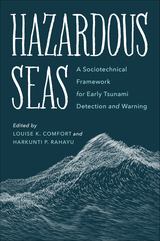 Hazardous Seas: A Sociotechnical Framework for Early Tsunami Detection and Warning
Edited by Louise K. Comfort and Harkunti P. Rahayu
Island Press, 2023 Tsunamis are infrequent but terrifying hazards for coastal communities. Difficult to predict, they materialize with little warning, claiming thousands of lives and causing billions of dollars in damage. Recent mega-tsunamis in Japan and Indonesia claimed close to 250,000 lives, triggering wide-scale economic and social disruption. Developing countries cannot afford costly underwater cable systems, and governments and relief organizations have been forced to rely on flawed warning systems such as deep-sea buoys. Now, a groundbreaking new approach to tsunami detection and warning, which relies on low-cost underwater sensors and networks of smartphone communication, has changed the equation. Developed by an international, interdisciplinary team of researchers, this approach allows at-risk coastal communities to have an economically viable, scientifically sound means to protect themselves.
Coeditors Louise K. Comfort and Harkunti P. Rahayu, accomplished experts in disaster preparedness, contend that it will give communities precious additional minutes to communicate warnings about imminent tsunamis to residents, potentially saving many lives. Chapters authored by a close group of collaborators present the science behind this new approach, describing conceptual design, computational models, and real-time testing of a prototype system in the warm equatorial waters of Indonesia’s Mentawai Sea. Introductory chapters explain the sociotechnical approach—how undersea sensors can transmit data to a network of electronic devices on land to alert residents to impending tsunami threats in near-real time. Subsequent chapters explore what this might look like: assessing communities at risk; designing interactive information systems for communication during an emergency; designing wireless networks for smartphone communication that can guide residents to safety; and designing community-based shelters. The book concludes with a thoughtful analysis of how these sociotechnical advances might be used for all coastal cities at risk of tsunamis, sea-level rise, storm surges, and other hazards.
Hazardous Seas is an invaluable guide for policy makers and international NGOs looking to save lives from tsunamis and mitigate crippling damage to communities, and provides a comprehensive overview of tsunami detection and warning for students of engineering, computer science, planning, policy, and economic and environmental analysis.
Hazardous Waste Management: Reducing The Risk
Benjamin Goldman
Island Press, 1986 Hazardous Waste Management: Reducing the Risk is the first book to study and rate toxic waste disposal sites and to provide step-by-step guidelines for evaluation, decision, and action. The innovative and practical ranking system shows how to rate facilities on the basis of site, management, and technology.
 Hazardous Waste Siting and Democratic Choice
Don Munton, Editor
Georgetown University Press, 1996 This volume analyzes the politics of hazardous waste siting and explores promising new strategies for siting facilities. Existing approaches to waste siting facilities have almost entirely failed, across all industrialized countries, largely because of community or NIMBY (Not in My Backyard) opposition. This volume examines a new strategy, voluntary choice siting—a process requiring mutual decisions negotiated between facility developers and the host communities. This bottom-up approach preserves democratic rights, recognizes the importance of public perceptions, and addresses issues of equity. In this collection, an interdisciplinary group of experts probes recent examples of waste facilities siting in the United States, Canada, Germany, and Japan. Both the successes and the failures presented offer practical insights into the siting process. The book includes an introductory review of the literature on facility siting and the NIMBY phenomenon as well as instructive essays on the use of voluntary processes in facilities siting. This book will be of value to policymakers, industry, and environmental groups, as well as to those working in environmental studies and engineering, political science, public health, geography, planning, and business economics.
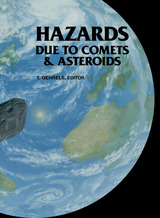 Hazards Due to Comets and Asteroids
Edited by T. Gehrels
University of Arizona Press, 1995 In 1993, the U.S. Department of Defense declassified information dealing with frequent explosions in the upper atmosphere caused by meteoric impact. It is estimated that impacts have occurred of a magnitude equivalent to the atomic bomb detonated at Hiroshima. Not all such space voyagers meet their end in the atmosphere, however; huge craters attest to the bombardment of earth over millions of years, and a major impact may have resulted in the extinction of dinosaurs. An impact in Siberia near the beginning of this century proves that such events are not confined to geologic time. Hazards Due to Comets and Asteroids marks a significant step in the attempt to come to grips with the threats posed by such phenomena. It brings together more than one hundred scientists from around the world, who draw on observational and theoretical research to focus on the technical problems related to all aspects of dealing with these hazards: searching for and identifying hazardous comets and asteroids; describing their statistics and characteristics; intercepting and altering the orbits of dangerous objects; and applying existent technologies—rocket boosters, rendezvous and soft-landing techniques, instrumentation—to such missions. The book considers defensive options for diverting or disrupting an approaching body, including solar sails, kinetic-energy impacts, nuclear explosives, robotic mass drivers, and various propulsion systems. A cataclysmic impact posing a threat to life on Earth is a possibility that tomorrow's technology is capable of averting. This book examines in depth the reality of the threat and proposes practical measures that can be initiated now should we ever need to deal with it.
Hazel
David Huddle
Tupelo Press, 2019 David Huddle’s twenty-first book, Hazel is a portrait of a woman both ordinary and exceptional, composed in glimpses of her life from child to elder. Hazel is a loner and somewhat of a pill. Although she’s not likeable in the regular ways, she’s rigorously honest in the way she examines her world, and in relationships with a few other people. Hazel’s nephew John Robert is captivated by the mystery of such a uniquely serious person. He assembles episodes from Hazel’s life, and the novel reveals a lifelong struggle by someone whose integrity is absolute. Huddle proves the complete life of almost anyone would be profoundly complex if seen whole.
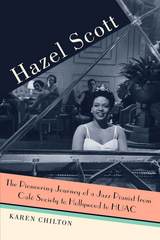 Hazel Scott: The Pioneering Journey of a Jazz Pianist, from Café Society to Hollywood to HUAC
Karen Chilton
University of Michigan Press, 2010 "Hazel Scott was an important figure in the later part of the Black renaissance onward. Even in an era where there was limited mainstream recognition of Black Stars, Hazel Scott's talent stood out and she is still fondly remembered by a large segment of the community. I am pleased to see her legend honored."
---Melvin Van Peebles, filmmaker and director "This book is really, really important. It comprises a lot of history---of culture, race, gender, and America. In many ways, Hazel's story is the story of the twentieth century."
---Murray Horwitz, NPR commentator and coauthor of Ain't Misbehavin' "Karen Chilton has deftly woven three narrative threads---Adam Clayton Powell, Jr., Harlem, and Hazel Scott---into a marvelous tapestry of black life, particularly from the Depression to the Civil Rights era. Of course, Hazel Scott's magnificent career is the brightest thread, and Chilton handles it with the same finesse and brilliance as her subject brought to the piano."
---Herb Boyd, author of Baldwin's Harlem: A Biography of James Baldwin "A wonderful book about an extraordinary woman: Hazel Scott was a glamorous, gifted musician and fierce freedom fighter. Thank you Karen Chilton for reintroducing her. May she never be forgotten."
---Farah Griffin, Institute for Research in African-American Studies, Columbia University In this fascinating biography, Karen Chilton traces the brilliant arc of the gifted and audacious pianist Hazel Scott, from international stardom to ultimate obscurity. A child prodigy, born in Trinidad and raised in Harlem in the 1920s, Scott's musical talent was cultivated by her musician mother, Alma Long Scott as well as several great jazz luminaries of the period, namely, Art Tatum, Fats Waller, Billie Holiday and Lester Young. Career success was swift for the young pianist---she auditioned at the prestigious Juilliard School when she was only eight years old, hosted her own radio show, and shared the bill at Roseland Ballroom with the Count Basie Orchestra at fifteen. After several stand-out performances on Broadway, it was the opening of New York's first integrated nightclub, Café Society, that made Hazel Scott a star. Still a teenager, the "Darling of Café Society" wowed audiences with her swing renditions of classical masterpieces by Chopin, Bach, and Rachmaninoff. By the time Hollywood came calling, Scott had achieved such stature that she could successfully challenge the studios' deplorable treatment of black actors. She would later become one of the first black women to host her own television show. During the 1940s and 50s, her sexy and vivacious presence captivated fans worldwide, while her marriage to the controversial black Congressman from Harlem, Adam Clayton Powell, Jr., kept her constantly in the headlines. In a career spanning over four decades, Hazel Scott became known not only for her accomplishments on stage and screen, but for her outspoken advocacy of civil rights and her refusal to play before segregated audiences. Her relentless crusade on behalf of African Americans, women, and artists made her the target of the House Un-American Activities Committee (HUAC) during the McCarthy Era, eventually forcing her to join the black expatriate community in Paris. By age twenty-five, Hazel Scott was an international star. Before reaching thirty-five, however, she considered herself a failure. Plagued by insecurity and depression, she twice tried to take her own life. Though she was once one of the most sought-after talents in show business, Scott would return to America, after years of living abroad, to a music world that no longer valued what she had to offer. In this first biography of an important but overlooked African American pianist, singer, actor and activist, Hazel Scott's contributions are finally recognized. Karen Chilton is a New York-based writer and actor, and the coauthor of I Wish You Love, the memoir of legendary jazz vocalist Gloria Lynne.
Hazing in the U.S. Armed Forces: Recommendations for Hazing Prevention Policy and Practice
Kirsten M. Keller
RAND Corporation, 2015 This report documents research focused on helping the Department of Defense build a more-systematic approach to hazing prevention and response. The report documents theory and research on the root causes of hazing and findings and recommendations regarding how best to define hazing, practices to prevent and respond to incidents of hazing, and how the armed forces can improve the tracking of hazing incidents.
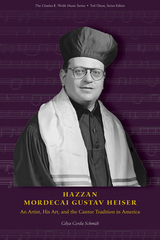 Hazzan Mordecai Gustav Heiser: An Artist, His Art, and the Cantor Tradition in America
Gilya Gerda Schmidt
University of Tennessee Press, 2024 When Gilya Gerda Schmidt met him in 1986, Cantor Heiser had spent forty-six of his eighty-one years as a US citizen and was well-acquainted with mourning. Heiser had assumed the cantorate at Congregation B’nai Israel in the East End of Pittsburgh, Pennsylvania, in 1942. A master of the cantor’s art, he was renowned for his style, elegant choir and service arrangements, and rich, dolesome voice, which seemed to pass effortlessly into hearers’ hearts.
But this book is more than a memorial to Heiser. Schmidt melds decades of archival research, conservation efforts, family interviews, and trips to Jerusalem and Berlin into a critical reconstruction of the life and vision of Hazzan Mordecai Gustav Heiser in the multiple contexts that shaped him. Coming of age in Berlin in the afterglow of the Second German Empire meant that young Gustav had tasted European Jewish culture in a rare state of refinement and modernity. But by January 30, 1940, when he reached New York with his wife, Elly, and two-and-a-half-year-old daughter, Judith, Cantor Heiser had lost nearly all of his living family relations to the extermination programs of the German Reich, after narrowly surviving a brief incarceration at Sachsenhausen.
While Cantor Heiser’s art was steeped in nineteenth-century tradition, Schmidt contends that Heiser’s music was a powerful affirmation of Jewish life in the twentieth century. In a final chapter, Schmidt describes his influence on the American cantorate and American culture and society.
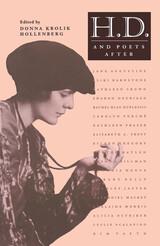 H.D. and Poets After
Donna Krolik Hollenberg
University of Iowa Press, 2000 From her work's first appearance under the Imagist label to its later development in innovative long poems and prose, H.D.'s excellence was recognized by her peers as well as her successors. H.D. and Poets After is the first book to explore her influence on contemporary American poetry.
Twenty essays—half by eminent American poets writing about their literary engagement with H.D. and half by critics writing about H.D. in relation to these same poets—provide a fruitful exchange of perceptions and interpretations. The dialogue between these two perspectives—the first autobiographical testimony and the second critical analysis by scholars attuned to both modern and contemporary poetries and poetics—calls into question both traditional notions of literary criticism and earlier theories of literary influence.
The volume includes a range of contemporary responses to H.D.'s work—from Alicia Ostriker's radical eroticism to Brenda Hillman's epistemological restlessness to Carolyn Forché's response to moral disasters of the century. H.D. and Poets After demonstrates key aspects of the poet's continuing importance as a "poet's poet" in the best sense.
He Heru. A Comb: An Ornament for the Most Sacred Part of the Body
Whiti Hereaka
Diaphanes, 2026 In Whiti Hereaka’s new fiction collection, a single comb becomes a universe of stories.
Drawing inspiration from a seemingly simple comb, or heru, this new text by Whiti Heraka comes in nine sections, “a part for each tooth, and a part for each space between them.” The parts tell stories of love, loss, and longing: tales of whales whose bones were used to make objects, of a carver creating a comb, of Maori gods and the power of women, of colonial whalers fishing their prey almost to extinction in the South Pacific, of a writer who cuts her hair and moves across worlds, weaving connections. Hereaka unfurls a stunning cosmology around the heru, combing with it through time and space to make “stories of ocean blue, blood red, bone white.”
 He Is the Sun, She Is the Moon: Women in Early Modern Germany
Heide Wunder
Harvard University Press, 1998 Renowned German social historian Heide Wunder refers to the cosmic image contained in the 1578 Book of Marital Discipline that characterizes the relationship between husband and wife. Today, "He is the sun, she is the moon" might be interpreted as a hierarchy of dominance and subordination. At the time it was used, however, sun and moon reflected the different but equal status of husband and wife.
Wunder shows how the history of women and the history of gender relations can provide crucial insights into how societies organize themselves and provide resources for political action. She observes actual circumstances as well as the normative rules that were supposed to guide women's lives. We learn what skills were necessary to take charge of households, what people ate, how they furnished their homes, what birth control measures were available, what role women played in peasant protest. Wunder finds that, in addition to the history of losses and setbacks for women observed by so many current interpreters, there is a history of gains as well. The regency of noble women was normal, as was the shared responsibility of wife and husband in a peasant household, an artisan's workshop, or a merchant's business.
Using sources as diverse as memoirs, wedding and funeral sermons, novels, and chronicles, and including a wealth of demographic information, Wunder reveals a surprising new image of early modern women and provides a richer interpretation of early modern Europe.
 He Knew She Was Right: The Independent Woman in the Novels of Anthony Trollope
Jane Nardin
Southern Illinois University Press, 1989
Trollope’s mother, wife, and a friend he loved platonically most of his life provided him three very different views of the Victorian woman. And, according to Jane Nardin, they were responsible for the dramatic shift in his treatment of women in his novels.
This is the first book in Sandra Gilbert’s Ad Feminam series to examine a male author. Nardin initially analyzes the novels Trollope wrote from 1855 to 1861, in which male concerns are central to the plot and women are angelic heroines, submissive and self-sacrificing. Even the titles of his novels written during this period are totally male oriented. The Three Clerks, Doctor Thorne, and The Bertrams all refer to men. Shortly after meeting Kate Field, Trollope wrote Orley Farm, which refers to the estate an angry woman steals from her husband and which marks a change in the attitudes toward women evident in his novels.
His next four books, The Small House at Allington, Rachel Ray, Can You Forgive Her?, and Miss Mackenzie, prove that women’s concerns had become central in his writing. Nardin examines specific novels written from 1861 to 1865 in which Trollope, with increasing vigor, subverts the conventional notions of gender that his earlier novels had endorsed.
Nardin argues that his novels written after 1865 and often recognized as feminist are not really departures but merely refinements of attitudes Trollope exhibited in earlier works.
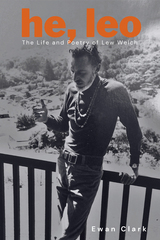 He, Leo: The Life and Poetry of Lew Welch
Ewan Clark
Oregon State University Press, 2023 Largely remembered for his mysterious disappearance in May 1971, Lew Welch was an important voice of the Beat Generation and San Francisco Renaissance. He spoke to key issues that America was facing in the aftermath of World War II—from the rise of consumerism and complacent suburban sensibilities to the threat of environmental disaster. He championed American speech, idioms, and identities. He found inspiration in the words of Gertrude Stein and William Carlos Williams, in the philosophies of Senzaki and the Buddha, and in his myriad friendships with some of the most renowned and revered poets, musicians, and artists of the 1950s and 1960s. His search for authenticity in language and poetry was a small part of a far greater search to establish a clear sense of himself.
He, Leo investigates Welch’s life and work in a chronological fashion, structured around Welch’s own notion of how three main aspects of his life—The Man, The Mountain, and The City—were interdependent. From his birth until his disappearance and presumed death, Welch’s life was often defined by problems, including a complex relationship with his mother, a long struggle with alcohol, and a fluctuating mental state. Yet he was open and candid about everything, a fact that is evident in all aspects of his work.
Each of the three main sections of He, Leo includes key poems, essays, and events—both personal and cultural—to help establish Welch’s importance as a prominent poet and figure during the San Francisco Renaissance. Despite his crushing self-criticism and his reputation as a “friend of,” he was bona fide poet with a strong voice and message of his own. With this first full-length biography, Ewan Clark restores Lew Welch to his rightful place as an important member of a significant American literary and cultural movement.
He Shall Not Pass This Way Again: The Legacy of Justice William O. Douglas
Stephen L. Wasby
University of Pittsburgh Press, 1990 After a successful career as a law professor and government regulator, William O. Douglas was appointed to the Supreme Court by Franklin D. Roosevelt in 1939. During his thirty-six years on the court, he became known as one of its most outspoken and controversial members. In this volume, which was originally published for the William O. Douglas Institute, distinguished scholars examine four major aspects of Justice Douglas's work: his relations with his colleagues; his views on civil liberties, which primarily led to his reputation as a liberal; his stance as an environmentalist; and his views as an internationalist.
He Spoke of Love: Selected Poems from the Satsai
Biharilal
Harvard University Press, 2022 The seventeenth-century Hindi classic treasured for its subtle and beautiful portrayal of divine and erotic love’s pleasures and sorrows.
The seven hundred poems of the Hindi poet Biharilal’s Satsai weave amorous narratives of the god Krishna and the goddess Radha with archetypal hero and heroine motifs that bridge divine and worldly love. He Spoke of Love brims with romantic rivalries, clandestine trysts, and the bittersweet sorrow of separated lovers. This new translation presents four hundred couplets from the enduring seventeenth-century classic, showcasing the poet’s ingenuity and virtuosity.
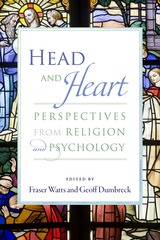 Head and Heart: Perspectives from Religion and Psychology
Fraser Watts
Templeton Press, 2013 Theologians and religious figures often draw a distinction between religion of the ‘”head” and religion of the “heart,” but few stop to ask what the terms “head” and “heart” actually denote. Many assume that this distinction has a scriptural basis, and yet many Biblical authors used the word “heart” as a synonym for “mind.” In fact, there isn’t a strict separation of the two concepts until the modern period, as in Pascal’s famous claim that “the heart has its reasons that reason can not know.” Since then, many other philosophers and theologians have made a similar distinction.
The fact that this distinction has been so persistent makes it an important area of study. Head and Heart: Perspectives from Religion and Psychology takes an inter-disciplinary approach, linking the thinking of theologians and philosophers with theory and research in present-day psychology. The tradition of using framing questions that have been developed in theology and philosophy can now be brought into dialogue with scientific approaches developed within cognitive psychology and neuroscience. Though these scientific approaches have not generally used the terms “head” and “heart,” they have arrived at a similar distinction in other ways. There is a notable convergence upon the realization that humans have two modes of cognition at their disposal that correspond to “head” and “heart.” The time is therefore ripe to bring the approaches of theology and science in to dialogue—an important dialogue that has been heretofore neglected.
Head and Heart draws on the unique expertise in relating theology and psychology of the University of Cambridge’s Psychology and Religion Research Group (PRRG). In addition to providing historical and theoretical perspectives, the contributors to this volume will also address practical issues arising from the group’s applied work in deradicalisation and religious education.
Contributors include Geoff Dumbreck, Nicholas J. S. Gibson, Malcolm Guite, Liz Gulliford, Russell Re Manning, Glendon L. Moriarty, Sally Myers, Sara Savage, Carissa A. Sharp, Fraser Watts, Harris Wiseman, and Bonnie Poon Zahl.
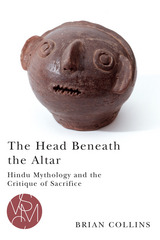 The Head Beneath the Altar: Hindu Mythology and the Critique of Sacrifice
Brian Collins
Michigan State University Press, 2014 In the beginning, says the ancient Hindu text the Rg Veda, was man. And from man’s sacrifice and dismemberment came the entire world, including the hierarchical ordering of human society. The Head Beneath the Altar is the first book to present a wide-ranging study of Hindu texts read through the lens of René Girard’s mimetic theory of the sacrificial origin of religion and culture. For those interested in Girard and comparative religion, the book also performs a careful reading of Girard’s work, drawing connections between his thought and the work of theorists like Georges Dumézil and Giorgio Agamben. Brian Collins examines the idea of sacrifice from the earliest recorded rituals through the flowering of classical mythology and the ancient Indian institutions of the duel, the oath, and the secret warrior society. He also uncovers implicit and explicit critiques in the tradition, confirming Girard’s intuition that Hinduism offers an alternative anti-sacrificial worldview to the one contained in the gospels.
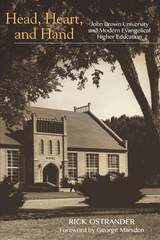 Head, Heart, and Hand: John Brown University and Modern Evangelical Higher Education
Rick Ostrander
University of Arkansas Press, 2018 Traveling evangelist John Brown believed that conventional colleges had become elitist and morally suspect, so he founded a small utopian college in 1919 to better combine evangelical Christianity and higher education. Historian Rick Ostrander places John Brown University in the long tradition of Christian education, but he also shows that evangelicalism had largely separated from mainstream higher education by the twentieth century. This engaging and objective history explores how John Brown University has adapted to modern American culture while maintaining its evangelical character. Brown set out to educate the poor, rural children of the Ozarks who had no other opportunity for schooling. He wanted to instill in them not only religious zeal but also his conception of what constituted significant work, namely manual labor. His concern with practical work is evident today in programs for broadcasting, engineering, teacher education, and business. His sons made academic excellence an institutional priority and gradually transformed the school into an accredited, respected liberal arts college. Head, Heart, and Hand deftly connects the story of John Brown University to the larger currents of American education and religion.
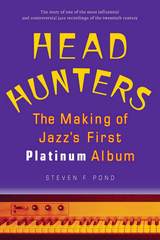 Head Hunters: The Making of Jazz's First Platinum Album
Steven F. Pond
University of Michigan Press, 2010 ". . . [a] very readable dissection of all the different ways in which Herbie Hancock's 1973 album Head Hunters broke the mould. . . . An entertaining and thought-provoking read."
---Jazzwise Magazine "An important and timely book. Pond's work reflects the insight an informed researcher and skilled performer can bring to the study of music."
---Travis Jackson, Associate Professor of American Music, University of Chicago Winner of the U.S. chapter of the International Association for the Study of Popular Music's Woody Guthrie Award for most distinguished work on popular music. Steven Pond's Head Hunters captures a transitional moment in modern music history, a time when jazz and rock intermingled to create a new, often controversial, genre. At the forefront of that style was Head Hunters, Herbie Hancock's foray into the fusion jazz market. The album became a turning point for a radical shift in both the production and reception of jazz. It was the best-selling jazz record of all time to that point, and the music industry quickly responded to the expanded market, with production and promotion budgets rising tenfold. Such a shift helped musicians pry open the control-booth door, permanently enlarging their role in production. But critics, believing that rock and funk might be appropriating jazz to new musical ends---or more ominously, for commercial reasons---grew increasingly alarmed at what they saw as the beginning of the end of jazz. Steven F. Pond is Associate Professor of music at Cornell University. He will become Editor-in-Chief for the journal Jazz Perspectives in 2011.
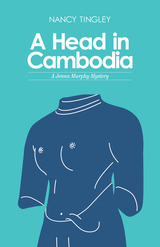 A Head in Cambodia: A Jenna Murphy Mystery
Nancy Tingley
Ohio University Press, 2017 When the alluring, eleventh-century Cambodian stone head of Radha, consort to Krishna, shows up at the Searles Museum, young curator Jenna Murphy doesn’t suspect that it will lead her to a murder. Asian art is her bailiwick, not criminal investigation, and her immediate concern is simply figuring out whether the head is one famously stolen from its body, or a fake. When a second decapitation happens—this time of an art collector, not a statue—Jenna finds herself drawn into a different kind of mystery, and the stakes are life or death. It turns out that the same talents for research and for unraveling puzzles—the bread and butter of an art historian—have perfectly equipped her to solve crimes. She’s certain the sculpture provides clues to help her solve the case, which takes her to Thailand and Cambodia. But the collectors, dealers, and con artists of the Bangkok art world only compound her questions. A Head in Cambodia is the fiction debut of noted Asian art expert Nancy Tingley. Readers will delight in the rarified world of collecting, as well as getting to know Jenna, an intrepid and shrewd observer who will easily find her place among V.I. Warshawski, Kinsey Milhone, and other great female sleuths.
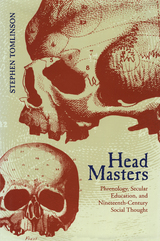 Head Masters: Phrenology, Secular Education, and Nineteenth-Century Social Thought
Stephen Tomlinson
University of Alabama Press, 2005 Contributes to a better understanding of Horace Mann and the educational reform movement he advanced
Head Masters challenges the assumption that phrenology—the study of the conformation of the skull as it relates to mental faculties and character—played only a minor and somewhat anecdotal role in the development of education. Stephen Tomlinson asserts instead that phrenology was a scientifically respectable theory of human nature, perhaps the first solid physiological psychology. He shows that the first phrenologists were among the most prominent scientists and intellectuals of their day, and that the concept was eagerly embraced by leading members of the New England medical community.
Following its progression from European theorists Franz-Joseph Gall, Johan Gasper Spurzheim, and George Combe to Americans Horace Mann and Samuel Gridley Howe, Tomlinson traces the origins of phrenological theory and examines how its basic principles of human classification, inheritance, and development provided a foundation for the progressive practices advocated by middle-class reformers such as Combe and Mann. He also elucidates the ways in which class, race, and gender stereotypes permeated 19th century thought and how popular views of nature, mind, and society supported a secular curriculum favoring the use of disciplinary practices based on physiology.
This study ultimately offers a reconsideration of the ideas and theories that motivated education reformers such as Mann and Howe, and a reassessment of Combe, who, though hardly known by contemporary scholars, emerges as one of the most important and influential educators of the 19th century.
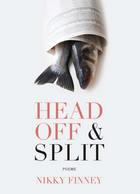 Head Off & Split: Poems
Nikky Finney
Northwestern University Press, 2011 Winner, 2011 National Book Award for Poetry
Winner, 2012 GCLS Award for Poetry
Winner, 2012 SIBA Book Award for Poetry
Nominee, 2012 NAACP Image Award for Outstanding Literary Work in Poetry
The poems in Nikky Finney's breathtaking new collection Head Off & Split sustain a sensitive and intense dialogue with emblematic figures and events in African American life: from civil rights matriarch Rosa Parks to former secretary of state Condoleezza Rice, from a brazen girl strung out on lightning to a terrified woman abandoned on a rooftop during Hurricane Katrina. Finney's poetic voice is defined by an intimacy that holds a soft yet exacting eye on the erotic, on uncanny political and family events, like her mother's wedding waltz with South Carolina senator Strom Thurmond, and then again on the heartbreaking hilarity of an American president's final State of the Union address.
Artful and intense, Finney's poems ask us to be mindful of what we fraction, fragment, cut off, dice, dishonor, or throw away, powerfully evoking both the lawless and the sublime.
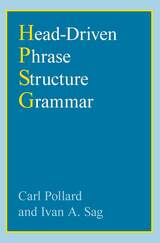 Head-Driven Phrase Structure Grammar
Carl Pollard and Ivan A. Sag
University of Chicago Press, 1994 This book presents the most complete exposition of the theory of head-driven phrase structure grammar (HPSG), introduced in the authors' Information-Based Syntax and Semantics. HPSG provides an integration of key ideas from the various disciplines of cognitive science, drawing on results from diverse approaches to syntactic theory, situation semantics, data type theory, and knowledge representation. The result is a conception of grammar as a set of declarative and order-independent constraints, a conception well suited to modelling human language processing.
This self-contained volume demonstrates the applicability of the HPSG approach to a wide range of empirical problems, including a number which have occupied center-stage within syntactic theory for well over twenty years: the control of "understood" subjects, long-distance dependencies conventionally treated in terms of wh-movement, and syntactic constraints on the relationship between various kinds of pronouns and their antecedents. The authors make clear how their approach compares with and improves upon approaches undertaken in other frameworks, including in particular the government-binding theory of Noam Chomsky.
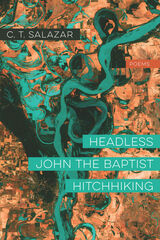 Headless John the Baptist Hitchhiking: Poems
C. T. Salazar
Acre Books, 2022 The coming-of-age chronicle of a queer Latinx Southerner.
In C. T. Salazar’s striking debut poetry collection, the speaker is situated in the tradition of Southern literature but reimagines its terrain with an eye on the South’s historic and ongoing violence. His restless relationship with religion (“a child told me there was a god / and because he was smiling, I believed him”) eventually includes a reclamation of the language of belief in the name of desire. “I felt myself become gospel in your hands,” the speaker tells his beloved. And, as the title poem asserts, a headless body “leaves more room for salvation.”
Though Salazar’s South is not a tender place, the book is a petition for tenderness, revealing in both place and people the possibilities for mercy, vulnerability, and wonder. The lyric I, as it creates an archive of experience, is not distanced from the poems’ subjects or settings, but deeply enmeshed in a tangled world. In poems with lush diction, ranging from a sonnet crown to those that explore the full field of the page, Headless John the Baptist Hitchhiking seeks—and finds—where the divine resides: “Praise our hollow-bell bodies still ringing.”
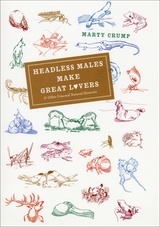 Headless Males Make Great Lovers: And Other Unusual Natural Histories
Marty Crump
University of Chicago Press, 2005 The natural world is filled with diverse—not to mention quirky and odd—animal behaviors. Consider the male praying mantis that continues to mate after being beheaded; the spiders, insects, and birds that offer gifts of food in return for sex; the male hip-pocket frog that carries his own tadpoles; the baby spiders that dine on their mother; the beetle that craves excrement; or the starfish that sheds an arm or two to escape a predator's grasp.
Headless Males Make Great Lovers and Other Unusual Natural Histories celebrates the extraordinary world of animals with essays on curious creatures and their amazing behaviors. In five thematic chapters, Marty Crump—a tropical field biologist well known for her work with the reproductive behavior of amphibians—examines the bizarre conduct of animals as they mate, parent, feed, defend themselves, and communicate. Crump's enthusiasm for the unusual behaviors she describes-from sex change and free love in sponges to aphrodisiac concoctions in bats-is visible on every page, thanks to her skilled storytelling, which makes even sea slugs, dung beetles, ticks, and tapeworms fascinating and appealing. Steeped in biology, Headless Males Make Great Lovers points out that diverse and unrelated animals often share seemingly bizarre behaviors—evidence, Crump argues, that these natural histories, though outwardly weird, are successful ways of living.
Illustrated throughout, and filled with vignettes of personal and scientific interest, Headless Males Make Great Lovers will enchant the general reader with its tales of blood-squirting horned lizards and intestine-ejecting sea cucumbers—all in the service of a greater appreciation of the diversity of the natural histories of animals.
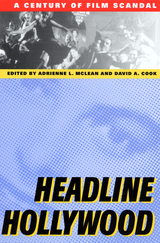 Headline Hollywood: A Century of Film Scandal
McLean, Adrienne L
Rutgers University Press, 2001 Hollywood has long been associated with scandal--with covering it up, with managing its effects, and, in some cases, with creating and directing it. In putting together Headline Hollywood, Adrienne McLean and David Cook approach the relationship between Hollywood and scandal from a fresh perspective. The contributors consider some of the famous transgressions that shocked Hollywood and its audiences during the last century, and explore the changing meaning of scandal over time by zeroing in on issues of power: Who decides what crimes and misdemeanors should be circulated for public consumption and titillation? What makes a Hollywood scandal scandalous? What are the uses of scandal? The essays are arranged chronologically to show how Hollywood scandals have evolved relative to changing moral and social orders. This collection will prove essential to the field of film studies as well as to anyone interested in the character and future direction of American culture. Contributors are Mark Lynn Anderson, Cynthia Baron, James Castonguay, Nancy Cook, Mary Desjardins, Lucy Fischer, Lee Grieveson, Erik Hedling, Peter Lehman, William Luhr, Adrienne L. McLean, Susan McLeland, and Sam Stoloff. Adrienne L. McLean is an assistant professor of film studies at the University of Texas at Dallas. David A. Cook is a professor of film and media studies at Emory University. He is the author of A History of Film Narrative.
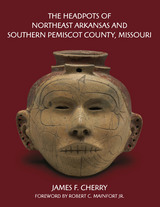 The Headpots of Northeast Arkansas and Southern Pemiscot County, Missouri
James F. Cherry
University of Arkansas Press, 2009 In 1981, James F. Cherry embarked on what evolved into a passionate, personal quest to identify and document all the known headpots of Mississippian Indian culture from northeast Arkansas and the bootheel region of southeast Missouri. Produced by two groups the Spanish called the Casqui and Pacaha and dating circa AD 1400–1700, headpots occur, with few exceptions, only in a small region of Arkansas and Missouri. Relatively little is known about these headpots: did they portray kinsmen or enemies, the living or the dead or were they used in ceremonies, in everyday life, or exclusively for the sepulcher? Cherry’s decades of research have culminated in the lavishly illustrated The Headpots of Northeast Arkansas and Southern Pemiscot County, Missouri, a fascinating, comprehensive catalog of 138 identified classical style headpots and an invaluable resource for understanding the meaning of these remarkable ceramic vessels.
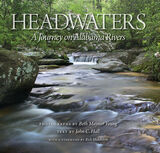 Headwaters: A Journey on Alabama Rivers
John C. Hall and Beth Maynor Young
University of Alabama Press, 2009 A breathtaking portrait of Alabama rivers
From their primal seepages in the Appalachian highlands or along the broad Chunnenuggee Hills, Alabama’s rivers carve through the rocky uplands and down the Fall Line rapids, then ease across the coastal plain to their eventual confluence with the Gulf of Mexico. Beth Maynor Young’s 155 full-color photographs constitute art through a lens; the colors, the light, and the angles all converge for a tender praise of her subject. Her stunning visuals are supported by tantalizing captions and introductory text from John C. Hall, a master field trip leader. Together, they tell a proud story of the native beauty and complexity of these Alabama watercourses that shepherd fully 20% of the nation’s fresh water to sea. The intimate close-up of verdant mosses or pebbled beaches pulls one into their space just as surely as does a sweeping scene of a watershed valley or a sparkling sunset over water. We all become eager listeners and observers on this guided “paddle to the Gulf,” drinking in the peace, delight, and beauty offered by the experience. At the end, we know we won’t be the same as before beginning the journey. In addition to being a celebration of their richness, Headwaters serves as a call to greater stewardship of these riverine resources. Conservation sidebars describe the current efforts in this direction and encourage further study and protection. This book tells us, in glorious color and instructive word, why we’ll always treasure these wonderful rivers.
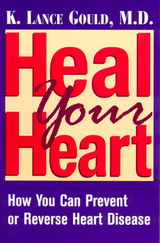 Heal Your Heart: How You Can Prevent or Reverse Heart Disease
Gould, K. Lance
Rutgers University Press, 2000 In Heal Your Heart, Dr. K. Lance Gould’s goals are better survival and improved health through the prevention and reversal of heart and vascular disease. His program provides practical, do-it-yourself steps and explores options beyond traditional invasive medical procedures for more definitive solutions. Designed for the general reader, Heal Your Heart can be used by anyone. Scientific information and practical guidelines are presented in simple, full-color illustrations, summary graphs or tables with brief, nontechnical text that incorporate the most recent medical knowledge. Dr. Gould introduces readers to new non-invasive medical imaging technologies such as cardiac PET that may potentially provide early diagnoses for people who may be at risk. Dr. Gould demonstrates how patients and physicians can work together to conquer one of the relentless causes of disability and death. He outlines what questions to ask medical staff and how to manage your own reversal program including your doctors, whether specialists or general practitioners. The principles of reversing cardiovascular disease in this program may be adapted to various lifestyles, habits, tastes, time constraints, and personalities. Dr. Gould’s program avoids multiple medical consultations and special facilities or equipment. The essentials are healthy living habits combined with medical management at home and work. This reversal program may replace surgical or catheter procedures for treating cardiovascular disease in most patients. In some specific cases, some people may also need balloon dilation or bypass surgery. Dr. Gould furnishes the criteria used to identify the minority of patients who need them. For this minority, Dr. Gould’s reversal program in addition to surgical treatment will provide optimal outcome by dramatically lowering further risk. For most people, this program produces a sense of well-being and reduces or eliminates symptoms.
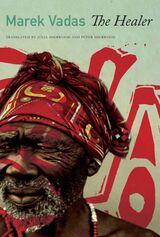 The Healer
Marek Vadas
Seagull Books, 2023 Traditional African narrative forms combined with European modernism.
The stories comprising The Healer, Marek Vadas’s first collection, which was originally published in 2006, are steeped in the culture, rituals, and traditions of Africa, blurring the boundaries between dream and reality and peopled with characters whose gender, shape, skin color or even memories may change at a stroke. Nevertheless, Vadas refuses to exoticize this world, and many of the stories, told in pared-down language, blend mythical elements with realistic depictions of harsh living conditions, economic deprivation, and colonial oppression. The narratives unfold from the perspective of their protagonists—children (often orphaned), and men struggling to make ends meet and trying in vain to resist the allure of strong women endowed with magic powers. As a Slovak writer focusing on the African continent, Vadas is a rare voice that helps to build bridges between very different cultures, and now his writing is introduced to the global anglophone readership.
 Healing Ableism: Stories About Disability and Religious Life
Darla Schumm
Rutgers University Press, 2026 Most people encounter disability at some point in their lives, either in their own bodies or through a friend or loved one. Faith leaders, sacred texts, and members of religious communities frequently offer religious teachings and metaphors as explanation for the presence of disability, but rarely do we hear the voices of people living with disabilities reflecting on their experiences of God, faith, or religious life. In Healing Ableism: Stories about Disability and Religious Life, Darla Schumm explores the extraordinary stories of people with disabilities who struggle with the ordinary human challenges of faith and doubt, exclusion and inclusion, and injustice and justice. Blending candid story-telling, cultural critique, and theory, Schumm invites readers to reflect on the experiences of people with disabilities in religious communities and organizations. Schumm argues that it’s not disability that needs healing, it’s ableism that needs healing. In the final chapter, Schumm offers accessible love as one avenue for healing ableism.
Healing and Society in Medieval England: A Middle English Translation of the Pharmaceutical Writings of Gilbertus Anglicus
Faye M. Getz
University of Wisconsin Press, 1991 Originally composed in Latin by Gilbertus Anglicus (Gilbert the Englishman), his Compendium of Medicine was a primary text of the medical revolution in thirteenth-century Europe. Composed mainly of medicinal recipes, it offered advice on diagnosis, medicinal preparation, and prognosis. In the fifteenth-century it was translated into Middle English to accommodate a widening audience for learning and medical “secrets.”
Faye Marie Getz provides a critical edition of the Middle English text, with an extensive introduction to the learned, practical, and social components of medieval medicine and a summary of the text in modern English. Getz also draws on both the Latin and Middle English texts to create an extensive glossary of little-known Middle English pharmaceutical and medical vocabulary.
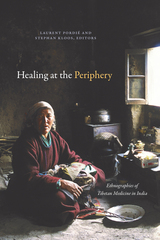 Healing at the Periphery: Ethnographies of Tibetan Medicine in India
Laurent Pordié and Stephan Kloos, editors
Duke University Press, 2022 India has long occupied an important place in Tibetan medicine's history and development. However, Indian Himalayan practitioners of Tibetan medicine, or amchi, have largely remained overlooked at the Tibetan medical periphery, despite playing a central social and medical role in their communities. Power and legitimacy, religion and economic development, biomedical encounters and Indian geopolitics all intersect in the work and identities of contemporary Himalayan amchi. This volume examines the crucial moment of crisis and transformation that occurred in the early 2000s to offer insights into the beginnings of Tibetan medicine's professionalization, industrialization, and official recognition in India and elsewhere. Based on fine-grained ethnographic studies in Ladakh, Zangskar, Sikkim, and the Darjeeling Hills, Healing at the Periphery asks how the dynamics of capitalism, social change, and the encounter with biomedicine affect small communities on the fringes of modern India, and, conversely, what local transformations of Tibetan medicine tell us about contemporary society and health care in the Himalayas and the Tibetan world.
Contributors. Florian Besch, Calum Blaikie, Sienna R. Craig, Barbara Gerke, Isabelle Guérin, Kim Gutschow, Pascale Hancart Petitet, Stephan Kloos, Fernanda Pirie, Laurent Pordié
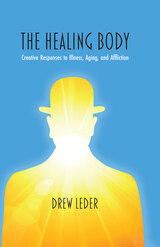 The Healing Body: Creative Responses to Illness, Aging, and Affliction
Drew Leder
Northwestern University Press, 2024 A philosophically and medically informed response to the physical vulnerabilities of our existence
As we grapple with the impacts of an aging population, the millions who struggle with chronic pain and illness, and the unknown number of COVID survivors dealing with long-term impairment, our individual and collective trust in our bodies is shaken. How to adapt? And how to live well, even when medical cure is unavailable? In The Healing Body: Creative Responses to Illness, Aging, and Affliction, philosopher and medical doctor Drew Leder shows how the phenomenology of lived embodiment makes available a variety of existential healing responses to bodily breakdown. Leder also turns to socially marginalized groups—people who have been incarcerated and those deemed “elderly”—to explore how individuals creatively cope with societal as well as physical challenges.
This book forwards current phenomenological research on the body, pain and suffering, disability, and aging. It deeply engages with the legacies of continental philosophy while also drawing insights from the traditions of Hinduism, Buddhism, and Taoism. The Healing Body is a uniquely creative and refreshingly innovative contribution to contemporary philosophy, demonstrating the importance of the philosophical method to the wider culture.
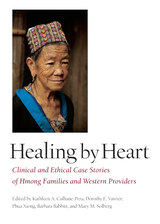 Healing by Heart: Clinical and Ethical Case Stories of Hmong Families and Western Providers
Kathleen A. Culhane-Pera
Vanderbilt University Press, 2003 Healing by Heart is a book of stories--stories of people's search for culturally responsive health care from U.S. providers. It offers resources to providers and institutions committed to delivering culturally responsive health care, paying special attention to building successful relationships with traditional Hmong patients and families. It makes available extensive information about the health-related beliefs, practices, and values of the Hmong people, including photographs of traditional healing methods.
Ranging in age from young infants to older adults, the patients in the stories present a wide range of health problems. The clinicians are from family practice, internal medicine, pediatrics, emergency medicine, surgery, obstetrics-gynecology, psychiatry/psychology, and hospice.
Each of the fourteen case stories is accompanied by discussion questions as well as two or three commentaries. The commentaries--written by patients, family members, shaman, Western clinicians (including Hmong physicians, nurses, and social workers), medical anthropologists, health care ethicists, social workers, psychologists, and clergy--are rich in personal reflections on cross-cultural health care experiences. Readers are rewarded with a combination of perspectives, including those of Hmong authors who have not previously published in English and scholars with years of professional experience working with the Hmong in Laos, Thailand, and the United States.
The editors offer a model for delivering culturally responsive health care with special attention to matters of cross-cultural health care ethics. The model identifies questions health care providers can focus on as they seek to understand the health-related moral commitments and practices prevalent in the cultural groups they serve, ethical questions that arise frequently and with great poignancy in cross-cultural health care relationships, and points to consider when a patient's treatment wish challenges the provider's professional integrity.
By sharing stories of suffering, confusion, and success, Healing by Heart couples an accessible method of learning about others with concrete recommendations about how to enhance cross-cultural health care relationships.
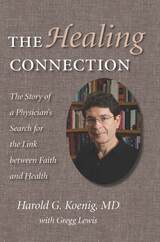 Healing Connection: Story Of Physicians Search For Link Between Faith & Hea
Harold Koenig
Templeton Press, 2004 "It is inspiring to see a physician who is unafraid to stand up for his religious beliefs and who understands how those beliefs can resonate with good science." —Larry Dossey, MD, author of Reinventing Medicine and Healing Words The name Harold G. Koenig is well known in the fast-growing field of spirituality and health. Founder and director of the widely respected Duke University Center for Theology, Spirituality, and Health, Dr. Koenig is recognized worldwide for his groundbreaking work in medical science and religious faith. In this book—now available in paperback—he shares his remarkable personal story and shows how personal trials became the catalyst for his pioneering research. In part one, he describes his turbulent youth: growing up on a California vineyard, college days of experimentation during the 1970s, adventures as a student researcher in Africa with Jane Goodall, an emotional breakdown, expulsion from medical school for disruptive behavior, battling mental illness as a street person in San Francisco. He refers to his ongoing battle with a chronic and debilitating physical disease in terms of the insights it gives him for his work, and he recounts the striking realization of God's call, the people and events that helped him refine a vision into a mission, and the subsequent professional opposition that resided alongside his success. Part two draws on the real-life examples of former patients and summarizes Koenig's most important findings concerning the impact of Christian faith on mental and physical health, encapsulated by the statement: religious faith and practice are connected to mental and physical health. In part three he challenges individuals and the American church to consider the implications of the research and to develop constructive ways of implementing the healing connection that can be found in faith.
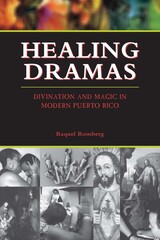 Healing Dramas: Divination and Magic in Modern Puerto Rico
By Raquel Romberg
University of Texas Press, 2009 In this intimate ethnography, Raquel Romberg seeks to illuminate the performative significance of healing rituals and magic works, their embodied nature, and their effectiveness in transforming the states of participants by focusing on the visible, albeit mostly obscure, ways in which healing and magic rituals proceed. The questions posed by Romberg emerge directly from the particular pragmatics of Puerto Rican brujería (witch-healing), shaped by the eclecticism of its rituals, the heterogeneous character of its participants, and the heterodoxy of its moral economy. What, if any, is the role of belief in magic and healing rituals? How do past discourses on possession enter into the performative experience of ritual in the here and now? Where does belief stop, and where do memories of the flesh begin? While these are questions that philosophers and anthropologists of religion ponder, they acquire a different meaning when asked from an ethnographic perspective. Written in an evocative, empathetic style, with theoretical ruminations about performance, the senses, and imagination woven into stories that highlight the drama and humanity of consultations, this book is an important contribution to the cross-cultural understanding of our capacity to experience the transcendental in corporeal ways.
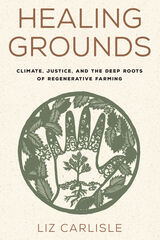 Healing Grounds: Climate, Justice, and the Deep Roots of Regenerative Farming
Liz Carlisle
Island Press, 2022 A powerful movement is happening in farming today—farmers are reconnecting with their roots to fight climate change. For one woman, that’s meant learning her tribe’s history to help bring back the buffalo. For another, it’s meant preserving forest purchased by her great-great-uncle, among the first wave of African Americans to buy land. Others are rejecting monoculture to grow corn, beans, and squash the way farmers in Mexico have done for centuries. Still others are rotating crops for the native cuisines of those who fled the “American wars” in Southeast Asia.
In Healing Grounds, Liz Carlisle tells the stories of Indigenous, Black, Latinx, and Asian American farmers who are reviving their ancestors’ methods of growing food—techniques long suppressed by the industrial food system. These farmers are restoring native prairies, nurturing beneficial fungi, and enriching soil health. While feeding their communities and revitalizing cultural ties to land, they are steadily stitching ecosystems back together and repairing the natural carbon cycle. This, Carlisle shows, is the true regenerative agriculture – not merely a set of technical tricks for storing CO2 in the ground, but a holistic approach that values diversity in both plants and people.
Cultivating this kind of regenerative farming will require reckoning with our nation’s agricultural history—a history marked by discrimination and displacement. And it will ultimately require dismantling power structures that have blocked many farmers of color from owning land or building wealth.
The task is great, but so is its promise. By coming together to restore these farmlands, we can not only heal our planet, we can heal our communities and ourselves.
 The Healing Hand: Man and Wound in the Ancient World
Guido Majno
Harvard University Press, 1975 This journey to the beginnings of the physician’s art brings to life the civilizations of the ancient world—Egypt of the Pharaohs, Greece at the time of Hippocrates, Rome under the Caesars, the India of Ashoka, and China as Mencius knew it. Probing the documents and artifacts of the ancient world with a scientist’s mind and a detective’s eye, Guido Majno pieces together the difficulties people faced in the effort to survive their injuries, as well as the odd, chilling, or inspiring ways in which they rose to the challenge. In asking whether the early healers might have benefited their patients, or only hastened their trip to the grave, Dr. Majno uncovered surprising answers by testing ancient prescriptions in a modern laboratory.
Illustrated with hundreds of photographs, many in full color, and climaxing ten years of work, The Healing Hand is a spectacular recreation of man’s attempts to conquer pain and disease.
The Healing Imagination of Olive Schreiner: Beyond South African Colonialism
Joyce Avrech Berkman
University of Massachusetts Press The first white South African novelist to win international recognition, Olive Schreiner (1855-1920) was also known for her political and social treatises, which promoted feminism, socialism, pacifism, and free thought and which criticized racism and British imperialism.
 Healing Invisible Wounds: Paths to Hope and Recovery in a Violent World
Richard F. Mollica
Vanderbilt University Press, 2006 In these personal reflections on his thirty years of clinical work with victims of genocide, torture, and abuse in the United States, Cambodia, Bosnia, and other parts of the world, Richard Mollica describes the surprising capacity of traumatized people to heal themselves. Here is how Neil Boothby, Director of the Program on Forced Migration and Health at the Mailman School of Public Health, Columbia University, describes the book: "Mollica provides a wealth of ethnographic and clinical evidence that suggests the human capacity to heal is innate--that the 'survival instinct' extends beyond the physical to include the psychological as well. He enables us to see how recovery from 'traumatic life events' needs to be viewed primarily as a 'mystery' to be listened to and explored, rather than solely as a 'problem' to be identified and solved. Healing involves a quest for meaning--with all of its emotional, cultural, religious, spiritual and existential attendants--even when bio-chemical reactions are also operative." Healing Invisible Wounds reveals how trauma survivors, through the telling of their stories, teach all of us how to deal with the tragic events of everyday life. Mollica's important discovery that humiliation--an instrument of violence that also leads to anger and despair--can be transformed through his therapeutic project into solace and redemption is a remarkable new contribution to survivors and clinicians. This book reveals how in every society we have to move away from viewing trauma survivors as "broken people" and "outcasts" to seeing them as courageous people actively contributing to larger social goals. When violence occurs, there is damage not only to individuals but to entire societies, and to the world. Through the journey of self-healing that survivors make, they enable the rest of us not only as individuals but as entire communities to recover from injury in a violent world.
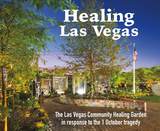 Healing Las Vegas: The Las Vegas Community Healing Garden in response to the 1 October tragedy
McAleer
University of Nevada Press, 2019 On Sunday, October 1, 2017, a gunman opened fire from thirty-two floors above a crowd of concertgoers at the Route 91 Harvest Festival on the Las Vegas Strip. The event left fifty-eight people killed, more than 860 injured, and thousands psychologically wounded. To date, this was the deadliest mass shooting in the United States in the last seventy years. Despite the chaos and terror, first responders, concert-goers, and passersby aided victims and survivors. Nearby businesses, hotels, and the university provided safety and services. Medical personnel rushed to area hospitals. And as the scope of the tragedy unfolded, the people of Las Vegas flooded blood donation centers and offered food, water, comfort, and care. And they created a garden—The Las Vegas Community Healing Garden.
The story of the garden unfolds through photographs and the words of survivors, first responders, family members, medical professionals, counselors, and members of the community. In only a matter of days, volunteers and local businesses transformed a vacant downtown lot into a serene urban oasis. Families and friends of those lost in the tragedy soon adopted each of the fifty-eight trees planted in honor of their loved ones, and visitors left behind colorful mementos, including painted rocks, photographs, and ornaments, as well as words of encouragement, love, loss, and strength.
In the aftermath of 1 October, an often misunderstood city revealed its soul under the most heartbreaking of circumstances. The inspirational voices and stories from a community touched by tragedy provide comfort and encouragement. And the organic response to the unthinkable is a testament to how one community came together at its darkest hour, chose hope over despair, unity over hate.
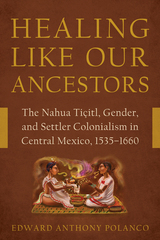 Healing Like Our Ancestors: The Nahua Tiçitl, Gender, and Settler Colonialism in Central Mexico, 1535–1660
Edward Anthony Polanco
University of Arizona Press, 2024 Offering a provocative new perspective, Healing Like Our Ancestors examines sixteenth- and seventeenth-century Nahua healers in central Mexico and how their practices have been misconstrued and misunderstood in colonial records.
Early colonial Spanish settlers defined, assessed, and admonished Nahua titiçih (healing specialists) and tiçiyotl (healing knowledge) in the process of building a society in Mexico that mirrored Iberia. Nevertheless, Nahua survivance (intergenerational knowledge transfer) has allowed communities to heal like their ancestors through changes and adaptations. Edward Anthony Polanco draws from diverse colonial primary sources, largely in Spanish and Nahuatl (the Nahua ancestral language), to explore how Spanish settlers framed titiçih, their knowledge, and their practices within a Western complex. Polanco argues for the usage of Indigenous terms when discussing Indigenous concepts and arms the reader with the Nahuatl words to discuss central Mexican Nahua healing. In particular, this book emphasizes the importance of women as titiçih and highlights their work as creators and keepers of knowledge. These vital Nahua perspectives of healing—and how they differed from the settler narrative—will guide community members as well as scholars and students of the history of science, Latin America, and Indigenous studies.
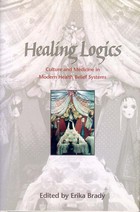 Healing Logics: Culture and Medicine in Modern Health Belief Systems
Erika Brady
Utah State University Press, 2001 Scholars in folklore and anthropology are more directly involved in various aspects of medicine—such as medical education, clinical pastoral care, and negotiation of transcultural issues—than ever before. Old models of investigation that artificially isolated "folk medicine," "complementary and alternative medicine," and "biomedicine" as mutually exclusive have proven too limited in exploring the real-life complexities of health belief systems as they observably exist and are applied by contemporary Americans. Recent research strongly suggests that individuals construct their health belief systmes from diverse sources of authority, including community and ethnic tradition, education, spiritual beliefs, personal experience, the influence of popular media, and perception of the goals and means of formal medicine. Healing Logics explores the diversity of these belief systems and how they interact—in competing, conflicting, and sometimes remarkably congruent ways. This book contains essays by leading scholars in the field and a comprehensive bibliography of folklore and medicine.
 Healing Memories: Puerto Rican Women's Literature in the United States
Elizabeth Garcia
University of Pittsburgh Press, 2018 Using an interdisciplinary approach, Healing Memories analyzes the ways that Puerto Rican women authors use their literary works to challenge historical methodologies that have silenced the historical experiences of Puerto Rican women in the United States. Following Aurora Levins Morales's alternative historical methodology she calls “curandera history,” this work analyzes the literary work of authors, including Aurora Levins Morales, Nicholasa Mohr, Esmeralda Santiago, and Judith Ortiz Cofer, and the ways they create medicinal histories that not only document the experiences of migrant women but also heal the trauma of their erasure from mainstream national history. Each analytical chapter focuses on the various methods used by each author including using the literary space as an archive, reclaiming memory, and (re)writing cultural history, all through a feminist lens that centers the voices and experiences of Puerto Rican women.
Healing Narratives: Women Writers Curing Cultural Dis-ease
Wilentz, Gay
Rutgers University Press, 2000 In Healing Narratives, Gay Wilentz explores the relationship between culture and health. In close reading of works by five women writers - Toni Cade Bambara, Erna Broder, Leslie Marmon Silko, Keri Hulme, and Jo Sinclair-she traces the narrative and structural similarities of a main character moving form a state of mental or physical disease toward wellness through reconnection with her cultural traditions. Whether due to the history of diaspora, colonial oppression, or the subversion of traditional culture by modernity, illness can only be overcome when the cultural construction of disease is recognized and a link to the indigenous is restored. Wilentz's cross-cultural approach-African American, Jamaican, Native American, Maori, and Jewish stories-offers a rich context from which the basis of cultural illness can be examined.
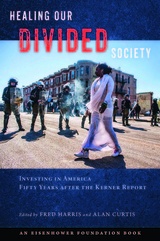 Healing Our Divided Society: Investing in America Fifty Years after the Kerner Report
Fred Harris and Alan Curtis
Temple University Press, 2018 In 1968, the Kerner Commission concluded that America was heading toward “two societies, one black, one white—separate and unequal.” Today, America’s communities are experiencing increasing racial tensions and inequality, working-class resentment over the unfulfilled American Dream, white supremacy violence, toxic inaction in Washington, and the decline of the nation’s example around the world. In Healing Our Divided Society, Fred Harris, the last surviving member of the Kerner Commission, along with Eisenhower Foundation CEO Alan Curtis, re-examine fifty years later the work still necessary towards the goals set forth in The Kerner Report. This timely volume unites the interests of minorities and white working- and middle-class Americans to propose a strategy to reduce poverty, inequality, and racial injustice. Reflecting on America’s urban climate today, this new report sets forth evidence-based policies concerning employment, education, housing, neighborhood development, and criminal justice based on what has been proven to work—and not work. Contributors include: Oscar Perry Abello, Elijah Anderson, Anil N.F. Aranha, Jared Bernstein, Henry G. Cisneros, Elliott Currie, Linda Darling-Hammond, Martha F. Davis, E. J. Dionne, Jr., Marian Wright Edelman, Delbert S. Elliott, Carol Emig, Jeff Faux, Ron Grzywinski, Michael P. Jeffries, Lamar K. Johnson, Celinda Lake, Marilyn Melkonian, Gary Orfield, Diane Ravitch, Laurie Robinson, Herbert C. Smitherman, Jr., Joseph Stiglitz, Dorothy Stoneman, Kevin Washburn, Valerie Wilson, Gary Younge, Julian E. Zelizer, and the editors
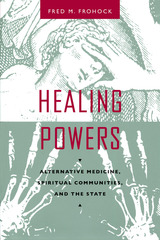 Healing Powers: Alternative Medicine, Spiritual Communities, and the State
Fred M. Frohock
University of Chicago Press, 1992 The personal testimony of individuals engaged in healing practices and the opposing voices of orthodox and alternative medicines are the center of Healing Powers. Focusing on medical norms and practices and on competing philosophies of the mind, the body, reality, and rationality across radically different "belief systems", Fred Frohock clarifies the social and legal dilemmas represented by "scientific medicine" and "alternative care."
"Frohock goes beyond the often irreconcilable differences between scientific biomedicine and alternative care by clarifying the social and legal dilemmas they present. . . . A noteworthy contribution forcing us to rethink what medical care is all about."—Jeffrey Michael Clare, Journal of the American Medical Association
"The book does more and better than simply provide a social-scientific proposal. It also gives not only a hearing but a voice to those who follow alternative therapies. . . . Frohock's accounts of their stories—along with the stories of the medical professionals—are eloquent and fascinating."—Allen Verhey, Medical Humanities Review
"Contains a storehouse of valuable information about the historical, philosophical, and psychological bases of alternative approaches to healing."—Marshall B. Kapp, New England Journal of Medicine
"Frohock introduces us to the scientific naturopaths and to physicians who believe in the mind's power to heal, to charismatics who believe in but cannot explain their powers, to those who test God and those who merely accept. He writes so well that I felt I had met these people."—Arthur W. Frank, Christian Century
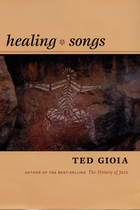 Healing Songs
Ted Gioia
Duke University Press, 2006 While the first healers were musicians who relied on rhythm and song to help cure the sick, over time Western thinkers and doctors lost touch with these traditions. In the West, for almost two millennia, the roles of the healer and the musician have been strictly separated. Until recently, that is. Over the past few decades there has been a resurgence of interest in healing music. In the midst of this nascent revival, Ted Gioia, a musician, composer, and widely praised author, offers the first detailed exploration of the uses of music for curative purposes from ancient times to the present. Gioia’s inquiry into the restorative powers of sound moves effortlessly from the history of shamanism to the role of Orpheus as a mythical figure linking Eastern and Western ideas about therapeutic music, and from Native American healing ceremonies to what clinical studies can reveal about the efficacy of contemporary methods of sonic healing. Gioia considers a broad range of therapies, providing a thoughtful, impartial guide to their histories and claims, their successes and failures. He examines a host of New Age practices, including toning, Cymatics, drumming circles, and the Tomatis method. And he explores how the medical establishment has begun to recognize and incorporate the therapeutic power of song. Acknowledging that the drumming circle will not—and should not—replace the emergency room, nor the shaman the cardiologist, Gioia suggests that the most promising path is one in which both the latest medical science and music—with its capacity to transform attitudes and bring people together—are brought to bear on the multifaceted healing process. In Healing Songs, as in its companion volume Work Songs, Gioia moves beyond studies of music centered on specific performers, time periods, or genres to illuminate how music enters into and transforms the experiences of everyday life.
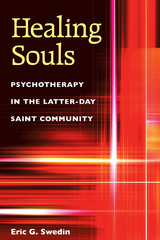 Healing Souls: Psychotherapy in the Latter-day Saint Community
Eric G. Swedin
University of Illinois Press, 2003 In this first history of psychotherapy among the Latter-day Saints, Eric G. Swedin describes how modern psychology has affected the "healing of souls” in the LDS community. But he also shows how this community melded its theological doctrines with mainstream psychiatry when secular concepts clashed with fundamental tenets of Mormonism.
The psychological professions pervasive in twentieth-century American society were viewed as dangerous by some religious communities. Healing Souls describes the LDS community's mixed feelings about science and modernity: while valuing knowledge, Mormons feared a challenge to faith. Nonetheless, psychology courses were introduced at Brigham Young University, and LDS psychotherapists began to introduce new ideas and practices to the community.
Swedin portrays the rise of professional organizations such as the Association of Mormon Counselors and Psychotherapists, as well as the importance of Allen E. Bergin, first director of the BYU Institute for Studies in Values and Human Behavior. Bergin and others paved the way for the LDS adoption of professional psychotherapy as an essential element of their "cure of souls."
Important chapters take up LDS psychopathology, feminist dissent, LDS philosophies of sexuality, and the LDS rejection of mainstream psychotherapy's selfist psychology on the basis of theological doctrines of family salvation, eternalism, and the natural man.
Healing Souls contributes to a more complete historical picture of the mental health professions in North America and a better understanding of how religious traditions and psychology have influenced each other.
 Healing Spaces: The Science of Place and Well-Being
Esther M. Sternberg, M.D.
Harvard University Press, 2009 “Esther Sternberg is a rare writer—a physician who healed herself…With her scientific expertise and crystal clear prose, she illuminates how intimately the brain and the immune system talk to each other, and how we can use place and space, sunlight and music, to reboot our brains and move from illness to health.”—Gail Sheehy, author of Passages
Does the world make you sick? If the distractions and distortions around you, the jarring colors and sounds, could shake up the healing chemistry of your mind, might your surroundings also have the power to heal you? This is the question Esther Sternberg explores in Healing Spaces, a look at the marvelously rich nexus of mind and body, perception and place.
Sternberg immerses us in the discoveries that have revealed a complicated working relationship between the senses, the emotions, and the immune system. First among these is the story of the researcher who, in the 1980s, found that hospital patients with a view of nature healed faster than those without. How could a pleasant view speed healing? The author pursues this question through a series of places and situations that explore the neurobiology of the senses. The book shows how a Disney theme park or a Frank Gehry concert hall, a labyrinth or a garden can trigger or reduce stress, induce anxiety or instill peace.
If our senses can lead us to a “place of healing,” it is no surprise that our place in nature is of critical importance in Sternberg’s account. The health of the environment is closely linked to personal health. The discoveries this book describes point to possibilities for designing hospitals, communities, and neighborhoods that promote healing and health for all.
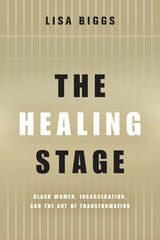 The Healing Stage: Black Women, Incarceration, and the Art of Transformation
Lisa Biggs
Ohio State University Press, 2022 Winner, 2023 NCA Lilla A. Heston Award for Outstanding Scholarship in Interpretation and Performance Studies Over the last five decades, Black women have been one of the fastest-growing segments of the global prison population, thanks to changes in policies that mandate incarceration for nonviolent offenses and criminalize what women do to survive interpersonal and state violence. In The Healing Stage, Lisa Biggs reveals how four ensembles of currently and formerly incarcerated women and their collaborating artists use theater and performance to challenge harmful policies and popular discourses that justify locking up “bad” women. Focusing on prison-based arts programs in the US and South Africa, Biggs illustrates how Black feminist cultural traditions—theater, dance, storytelling, poetry, humor, and protest—enable women to investigate the root causes of crime and refute dominant narratives about incarcerated women. In doing so, the arts initiatives that she writes about encourage individual and collective healing, a process of repair that exceeds state definitions of rehabilitation. These case studies offer powerful examples of how the labor of incarcerated Black women artists—some of the most marginalized and vulnerable people in our society—radically extends our knowledge of prison arts programs and our understanding of what is required to resolve human conflicts and protect women’s lives.
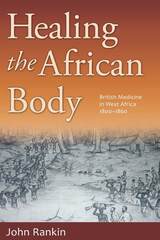 Healing the African Body: British Medicine in West Africa, 1800-1860
John Rankin
University of Missouri Press, 2015 This timely book explores the troubled intertwining of religion, medicine, empire, and race relations in the early nineteenth century. John Rankin analyzes the British use of medicine in West Africa as a tool to usher in a “softer” form of imperialism, considers how British colonial officials, missionaries, and doctors regarded Africans, and explores the impact of race classification on colonial constructs. Rankin goes beyond contemporary medical theory, examining the practice of medicine in colonial Africa as Britons dealt with the challenges of providing health care to their civilian employees, African soldiers, and the increasing numbers of freed slaves in the general population, even while the imperialists themselves were threatened by a lack of British doctors and western medicines. As Rankin writes, “The medical system sought to not only heal Africans but to ‘uplift’ them and make them more amenable to colonial control . . . Colonialism starts in the mind and can be pushed on the other solely through ideological pressure.”
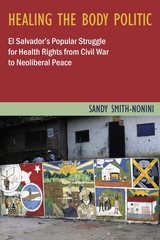 Healing the Body Politic: El Salvador's Popular Struggle for Health Rights from Civil War to Neoliberal Peace
Smith-Nonini, Sandy
Rutgers University Press, 2010 Incorporating investigative journalism and drawing on interviews with participants and leaders, Sandy Smith-Nonini examines the contested place of health and development in El Salvador over the last two decades. Healing the Body Politic recounts the dramatic story of radical health activism from its origins in liberation theology and guerrilla medicine during the third-world country's twelve-year civil war, through development of a remarkable "popular health system," administered by lay providers in a former war zone controlled by leftist rebels. This ethnography casts light on the conflicts between the conservative Ministry of Health and primary health advocates during the 1990s peace process--a time when the government sought to dismantle the effective peasant-run rural system. It offers a rare analysis of the White Marches of 2002û2003, when radicalized physicians rose to national leadership in a successful campaign against privatization of the social security health system. Healing the Body Politic contributes to the productive integration of medical and political anthropology by bringing the semiotics of health and the body to bear on cultural understandings of warfare, the state, and globalization.
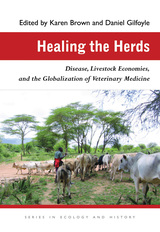 Healing the Herds: Disease, Livestock Economies, and the Globalization of Veterinary Medicine
Karen Brown
Ohio University Press, 2010 During the early 1990s, the ability of dangerous diseases to pass between animals and humans was brought once more to the public consciousness. These concerns continue to raise questions about how livestock diseases have been managed over time and in different social, economic, and political circumstances. Healing the Herds: Disease, Livestock Economies, and the Globalization of Veterinary Medicine brings together case studies from the Americas, western Europe, and the European and Japanese colonies to illustrate how the rapid growth of the international trade in animals through the nineteenth century engendered the spread of infectious diseases, sometimes with devastating consequences for indigenous pastoral societies. At different times and across much of the globe, livestock epidemics have challenged social order and provoked state interventions, often opposed by farmers and herders. The intensification of agriculture has transformed environments, with consequences for animal and human health. But the last two centuries have also witnessed major changes in the way societies have conceptualized diseases and sought to control them. From the late nineteenth century, advances in veterinary technologies afforded veterinary scientists a new professional status and allowed them to wield greater political influence. While older methods have remained important to strategies of control and prevention, as demonstrated during the outbreak of foot-and-mouth disease in Britain in 2001, the rise of germ theories and the discovery of vaccines against some infections made it possible to move beyond the blunt tools of animal culls and restrictive quarantines of the past. Healing the Herds: Disease, Livestock Economies, and the Globalization of Veterinary Medicine offers a new and exciting comparative approach to the complex interrelationships of microbes, markets, and medicine in the global economy.
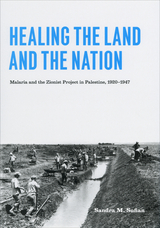 Healing the Land and the Nation: Malaria and the Zionist Project in Palestine, 1920-1947
Sandra M. Sufian
University of Chicago Press, 2007 A novel inquiry into the sociopolitical dimensions of public medicine, Healing the Land and the Nation traces the relationships between disease, hygiene, politics, geography, and nationalism in British Mandatory Palestine between the world wars. Taking up the case of malaria control in Jewish-held lands, Sandra Sufian illustrates how efforts to thwart the disease were intimately tied to the project of Zionist nation-building, especially the movement’s efforts to repurpose and improve its lands. The project of eradicating malaria also took on a metaphorical dimension—erasing anti-Semitic stereotypes of the “parasitic” Diaspora Jew and creating strong, healthy Jews in Palestine. Sufian shows that, in reclaiming the land and the health of its people in Palestine, Zionists expressed key ideological and political elements of their nation-building project.
Taking its title from a Jewish public health mantra, Healing the Land and the Nation situates antimalarial medicine and politics within larger colonial histories. By analyzing the science alongside the politics of Jewish settlement, Sufian addresses contested questions of social organization and the effects of land reclamation upon the indigenous Palestinian population in a decidedly innovative way. The book will be of great interest to scholars of the Middle East, Jewish studies, and environmental history, as well as to those studying colonialism, nationalism, and public health and medicine.
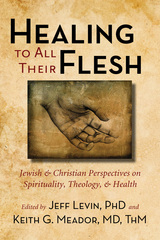 Healing to All Their Flesh: Jewish and Christian Perspectives on Spirituality, Theology, and Health
Jeff Levin
Templeton Press, 2012 Healing to All Their Flesh asks us to step back and carefully rethink the relationship between religion and health. It does so by examining overlooked issues of theology and meaning that lie at the foundation of religion’s supposed beneficial function. Is a religion-health relationship consistent with understandings of faith within respective traditions? What does this actually imply? What does it not imply? How have these ideas been distorted? Why does this matter—for medicine and healthcare and also for the practice of faith? Is the ultimate relation between spirit and flesh, as mediated by the context of human belief and experience, a topic that can even be approached through empirical observation, scientific reasoning, and the logic of intellectual discourse?8 pag e photo insert
The editors of this collection, Drs. Jeff Levin and Keith G. Meador, have gathered together the writings of leading Jewish and Christian theological, pastoral, ethical, and religious scholars to answer these important questions. Contributors include Richard Address, William Cutter, Elliot N. Dorff, Dayle A. Friedman, Stanley Hauerwas, Warren Kinghorn, M. Therese Lysaught, Stephen G. Post, John Swinton, and Simkha Y. Weintraub, with a foreword by Samuel E. Karff.
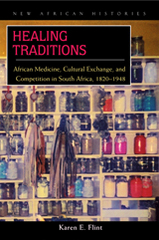 Healing Traditions: African Medicine, Cultural Exchange, and Competition in South Africa, 1820–1948
Karen E. Flint
Ohio University Press, 2008 In August 2004, South Africa officially sought to legally recognize the practice of traditional healers. Largely in response to the HIV/AIDS pandemic, and limited both by the number of practitioners and by patients’ access to treatment, biomedical practitioners looked toward the country’s traditional healers as important agents in the development of medical education and treatment. This collaboration has not been easy. The two medical cultures embrace different ideas about the body and the origin of illness, but they do share a history of commercial and ideological competition and different relations to state power. Healing Traditions: African Medicine, Cultural Exchange, and Competition in South Africa, 1820–1948 provides a long-overdue historical perspective to these interactions and an understanding that is vital for the development of medical strategies to effectively deal with South Africa’s healthcare challenges. Between 1820 and 1948 traditional healers in Natal, South Africa, transformed themselves from politically powerful men and women who challenged colonial rule and law into successful entrepreneurs who competed for turf and patients with white biomedical doctors and pharmacists. To understand what is “traditional” about traditional medicine, Flint argues that we must consider the cultural actors and processes not commonly associated with African therapeutics: white biomedical practitioners, Indian healers, and the implementing of white rule. Carefully crafted, well written, and powerfully argued, Flint’s analysis of the ways that indigenous medical knowledge and therapeutic practices were forged, contested, and transformed over two centuries is highly illuminating, as is her demonstration that many “traditional” practices changed over time. Her discussion of African and Indian medical encounters opens up a whole new way of thinking about the social basis of health and healing in South Africa. This important book will be core reading for classes and future scholarship on health and healing in Africa.
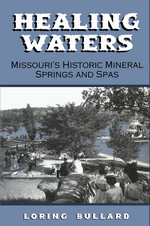 Healing Waters: Missouri's Historic Mineral Springs and Spas
Loring Bullard
University of Missouri Press, 2004 Missouri’s mineral springs and resorts played a vital role in the social and economic development of the state. In Healing Waters, Loring Bullard delves into the long history of these springs and spas, concentrating particularly on the use and development of the mineral springs from 1800 to about the 1930s. During this period, there were at least eighty sites in the state that could be described as resorts. Because so many people were drawn to the springs by their faith in the healing virtues of the springwater, towns were frequently founded at the mineral springs. These places fought hard to capture the attention of Missourians who were seeking better health, relaxation, or good times in the late 1800s and early 1900s. Bullard first examines the development of mineral water resorts in Europe from ancient times, early spa traditions in America, and Missouri’s frontier spas. He then discusses the establishment of saltworks at the state’s saline springs and the importance of the early salt trade; the brisk business that grew around the bottling of mineral waters; the use and development of mineralized groundwater resources; the geologic and biologic factors that create Missouri’s mineral waters; and public and professional belief in the curative values of mineral waters. Healing Waters also traces the demise of Missouri’s mineral water resorts and towns. Well into the twentieth century, when modern medicine had seemingly taken hold, many physicians and scientists continued to proclaim the medicinal virtues of mineral waters. However, by the second quarter of the twentieth century, medical science and popular opinion had discounted the immediate medical usefulness of mineral waters. As advances were made in microbiology and biochemistry, and with the inherent promise of drug cures, orthodox medicine began to turn a cold shoulder on mineral water treatments. Spa treatments, with their long regimens, also did not fit well with the increasingly fast-paced lifestyles of the public. By visiting the sites, gathering local historical accounts, interviewing local citizens, and photographing remaining artifacts, Bullard has done a masterful job in providing the answers to why these vibrant social centers came to be and why they faded.
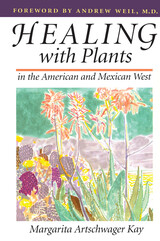 Healing with Plants in the American and Mexican West
Margarita Artschwager Kay
University of Arizona Press, 1996 Disenchanted with biomedicine and dismayed by its cost, increasing numbers of people are seeking alternative therapies such as the healing plants discussed in this book. Plant medicine is a billion-dollar business: health food stores, small yerberias, and even giant grocery store chains carry hundreds of medicinal herbs. By one estimate, up to one-third of the U.S. population uses alternative medicine—generally in addition to conventional therapy and commonly without telling their doctors. The heart of this volume is a complete description of 100 plants commonly used today, often for the same purposes reported by chroniclers of the Aztecs or eighteenth-century European explorers. Information for each plant includes botanical and common plant names, history, contemporary uses, a description of how the plant is prepared and administered, and brief phytochemical data. Discussions of folk efficacy and folk properties—beliefs in how and why the herb heals—help to explain the continued use of each plant into the present day. Are any of these plants dangerous, and do any of them really work? Where did they come from, and where are they available now? How can health-care practitioners gain the confidence of their patients to learn whether they are using alternative medicines for specific illnesses, symptoms, or injuries? Perhaps most intriguing, which of these plants might be waiting to take the place of known antibiotics as pathological organisms become increasingly resistant to modern miracle drugs? Answers to these and other questions will pique the interest of general readers and will be an invaluable resource for health-care providers—especially nurses and other primary-care providers, who often must find an interface between biomedical and more traditional therapies. For all readers, the book opens a window into many ethnic cultures of the region—Mexican American communities, desert Pima, coastal Seri, and others. Here is the fascinating saga of how their healing plants from prehistoric times melded with Old World herbs brought by the Europeans to create the unique pharmacopoeia available today here and in other parts of the world. Plants included:
Acacia (Cassie, Acacia)
Achillea (Yarrow)
Agastache (Giant Hyssop)
Agave (Century Plant)
Allium (Garlic, Onion)
Aloe (Aloe)
Ambrosia (Ragweed)
Anemopsis (Yerba Mansa)
Arctostaphylos (Bearberry, Uva Ursi)
Argemone (Prickly Poppy)
Aristolochia (Bithwort, Snakeroot)
Arracacia (Arracacha)
Artemisia (Wormwood, Mugwort, Western Mugwort, Sagebrush)
Asclepias (Milkweed)
Baccharis (Desert Broom, Seep Willow)
Bocconia (Tree Celandine)
Buddleia (Butterfly Bush)
Bursera (Elephant Tree)
Caesalpinia (Mexican Bird-of-Paradise)
Cannabis (Marijuana)
Capsicum (Chili)
Carnegiea (Saguaro)
Casimiroa (Zapote)
Cassia (Senna)
Cereus (Cactus)
Chenopodium (Goosefoot, Wormseed)
Citrus (Lemon, Lime, Orange)
Datura (Jimson Weed)
Ephedra (Mormon Tea)
Equisetum (Horsetail)
Eryngium (Eryngo, Button Snakeroot)
Eucalyptus (Eucalyptus)
Euphorbia (Spurge)
Eysenhardtia (Kidneywood)
Gnaphalium (Everlasting, Cudweed)
Guaiacum (Lignum Vitae)
Guazuma (Guazuma)
Gutierrezia (Turpentine Bush)
Haematoxylon (Logwood)
Haplopappus (Jimmyweed)
Heterotheca (Telegraph Plant, Falso Arnica)
Hintonia (Copalqu¡n)
Ibervillea (Coyote Melon)
Jacquinia (Jacquinia)
Jatropha (Limberbush)
Juniperus (Juniper)
Karwinskia (Coffeeberry)
Kohleria (Tree Gloxinia)
Krameria (Ratany)
Lantana (Lantana)
Larrea (Creosote Bush, Greasewood)
Ligusticum (Lovage)
Lippia (Oregano)
Lysiloma (Featherbush)
Malva (Mallow)
Mammillaria (Pincushion Cactus)
Mascagnia (Mascagnia)
Matricaria (Chamomile)
Mentha (Mint)
Nicotiana (Tobacco)
Ocimum (Basil)
Opuntia (Cholla, Prickly Pear)
Perezia (Perezia)
Persea (Avocado)
Phaseolus (Bean)
Phoradendron, Stru
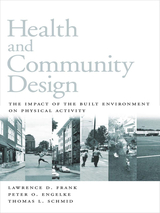 Health and Community Design: The Impact Of The Built Environment On Physical Activity
Lawrence D. Frank, Peter O. Engelke, and Thomas L. Schmid
Island Press, 2003 Health and Community Design is a comprehensive examination of how the built environment encourages or discourages physical activity, drawing together insights from a range of research on the relationships between urban form and public health. It provides important information about the factors that influence decisions about physical activity and modes of travel, and about how land use patterns can be changed to help overcome barriers to physical activity. Chapters examine: • the historical relationship between health and urban form in the United States
• why urban and suburban development should be designed to promote moderate types of physical activity
• the divergent needs and requirements of different groups of people and the role of those needs in setting policy
• how different settings make it easier or more difficult to incorporate walking and bicycling into everyday activities A concluding chapter reviews the arguments presented and sketches a research agenda for the future.
Health and Disease in the Neolithic Lengyel Culture
Edited by Václav Smrcka and Olivér Gábor
Karolinum Press, 2020 Lasting from around 4800 to 4000 BCE, the Lengyel culture helped usher in the Copper Age in Central Europe with the rise of mining, craft production, and the trading of copper and obsidian, in addition to larger-scale farming. In Health and Disease in the Neolithic Lengyel Culture, the authors investigate the migration of the Lengyel people as they moved west from their place of origin in modern-day Hungary to areas in what is now the Czech Republic and Poland. By drawing on research into the trace elements of strontium, carbon, and nitrogen found in human bone tissue, as well paleopathological analyses of congenital defects, this book proves that the Lengyel migration occurred in waves, providing important details about the changes in the diet, health, and mobility of a people who were crucial to the development of early European civilization
Health and Economic Outcomes Among the Alumni of the Wounded Warrior Project: 2013
Jennifer L. Cerully
RAND Corporation, 2014 In this report, the authors use the Wounded Warrior Project’s 2013 survey of its members (alumni) to understand the physical, mental, and economic challenges that Wounded Warriors face. The researchers find that at least half of alumni reported dealing with mental health conditions such as depression and posttraumatic stress disorder, and many of these alumni reported difficulties or delays in seeking mental health care, or not doing so at all.
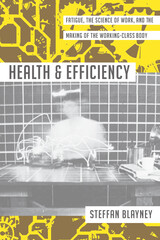 Health and Efficiency: Fatigue, the Science of Work, and the Making of the Working-Class Body
Steffan Blayney
University of Massachusetts Press, 2022 A new model of health emerged in Britain between 1870 and 1939. Centered on the working body, organized around the concept of efficiency, and grounded in scientific understandings of human labor, scientists, politicians, and capitalists of the era believed that national economic productivity could be maximized by transforming the body of the worker into a machine. At the core of this approach was the conviction that worker productivity was intimately connected to worker health. Under this new “science of work,” fatigue was seen as the ultimate pathology of the working-class body, reducing workers’ capacity to perform continued physical or mental labor. As Steffan Blayney shows, the equation between health and efficiency did not go unchallenged. While biomedical and psychological experts sought to render the body measurable, governable, and intelligible, ordinary men and women found ways to resist the logics of productivity and efficiency imposed on them, and to articulate alternative perspectives on work, health, and the body.
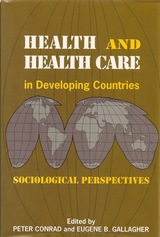 Health and Health Care In Developing Countries: Sociological Perspectives
Peter Conrad
Temple University Press, 1993 In this seminal collection of articles on health care in the Third World, sociological perspectives are applied to medical issues in revealing ways. Fourteen essays (all but two of which are original to this volume) examine the social production of health, disease, and systems of care throughout the developing world. The volume covers a range of areas—central Africa, Nigeria, Singapore, Taiwan, Indonesia, Nepal, China, United Arab Emirates, Oman, and Mexico—and a broad scope of topics, from emergency care, the AIDS epidemic, and women's health care, to public health programs and national health care policies.
Contributors address the central question of whether health systems in developing areas should emphasize the role of clinical medicine and individual physicians or community and preventive medical resources. The major health problems faced by these societies—inadequate sanitation, infectious disease, high infant-child mortality, and a lack of family planning—indicate the greater need for health educators and public health workers despite many poor nations' desire for Western doctors. Other topics that are examined include the process of seeking medical aid; the relationship between traditional and modern medicines; medical education, hospital care, and communication between doctors and patients in developing countries; and the relevance and application of sociology in Third World settings.
This volume seeks to draw attention to the significance of medical sociology for understanding Third World health problems and to show how examining developing societies may necessitate reframing or modifying some Western sociological notions. In addition, these essays stretch the boundaries of medical sociology to include Third World issues.
 Health and Human Flourishing: Religion, Medicine, and Moral Anthropology
Carol R. Taylor and Roberto Dell’Oro, Editors
Georgetown University Press, 2006 What, exactly, does it mean to be human? It is an age-old question, one for which theology, philosophy, science, and medicine have all provided different answers. But though a unified response to the question can no longer be taken for granted, how we answer it frames the wide range of different norms, principles, values, and intuitions that characterize today's bioethical discussions. If we don't know what it means to be human, how can we judge whether biomedical sciences threaten or enhance our humanity? This fundamental question, however, receives little attention in the study of bioethics. In a field consumed with the promises and perils of new medical discoveries, emerging technologies, and unprecedented social change, current conversations about bioethics focus primarily on questions of harm and benefit, patient autonomy, and equality of health care distribution. Prevailing models of medical ethics emphasize human capacity for self-control and self-determination, rarely considering such inescapable dimensions of the human condition as disability, loss, and suffering, community and dignity, all of which make it difficult for us to be truly independent. In Health and Human Flourishing, contributors from a wide range of disciplines mine the intersection of the secular and the religious, the medical and the moral, to unearth the ethical and clinical implications of these facets of human existence. Their aim is a richer bioethics, one that takes into account the roles of vulnerability, dignity, integrity, and relationality in human affliction as well as human thriving. Including an examination of how a theological anthropology—a theological understanding of what it means to be a human being—can help us better understand health care, social policy, and science, this thought-provoking anthology will inspire much-needed conversation among philosophers, theologians, and health care professionals.
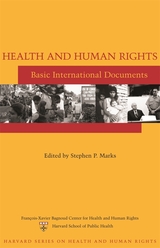 Health and Human Rights: Basic International Documents
Stephen P. Marks
Harvard University Press This collection of texts provides the practitioner, scholar, and advocate with easy access to the most basic instruments of international law and policy that express the values of human rights for advancing health. It is the first in a series on health and human rights from the Francois-Xavier Bagnoud Center for Health and Human Rights at the Harvard School of Public Health. Topics include: professional ethics; research and experimentation; treatment of prisoners and detainees; patients' rights; right to health; right to life; freedom from torture, war crimes, crimes against humanity, and genocide; the right to an adequate standard of living; women and reproductive health; children; persons with disabilities; rights of older persons; infectious diseases; business, trade, and intellectual property; occupational health and safety; biotechnology; and protection of the environment. This work will be an indispensable reference for students and professors in courses covering the intersection of health and human rights.
Health and Human Rights: Basic International Documents, Second Edition
Stephen P. Marks
Harvard University Press This collection of texts is updated and expanded from the first edition to provide the practitioner, scholar, and advocate with access to the most basic instruments of international law and policy that express the values of human rights for advancing health. The topics covered include professional ethics; research and experimentation; treatment of prisoners and detainees; patients' rights; right to health; right to life; freedom from torture, war crimes, crimes against humanity, and genocide; the right to an adequate standard of living; women and reproductive health; children; persons with disabilities; rights of older persons; infectious diseases; business, trade, and intellectual property; occupational health and safety; biotechnology; and protection of the environment. This book will be an indispensable reference work.
 Health and Human Rights: Basic International Documents, Third Edition
Stephen P. Marks
Harvard University Press The collection of materials in this latest edition of Health and Human Rights: Basic International Documents has been updated and expanded from the first two editions to provide the practitioner, scholar, and advocate with access to the most basic instruments of international law and policy that express the values of human rights for advancing health. The topics covered include professional ethics; research and experimentation; bioethics and biotechnology; the right to health; the right to life; freedom from torture, war crimes, crimes against humanity, and genocide; the right to an adequate standard of living; women and reproductive health; children; persons with disabilities; the rights of other vulnerable groups; infectious diseases; business, trade, and intellectual property; non-communicable diseases; the right to a clean environment; and sustainable development. This book will be an indispensable reference for everyone working at the intersection of health and human rights.
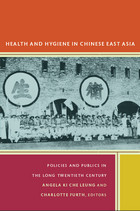 Health and Hygiene in Chinese East Asia: Policies and Publics in the Long Twentieth Century
Angela Ki Che Leung and Charlotte Furth, eds.
Duke University Press, 2010 This collection expands the history of colonial medicine and public health by exploring efforts to overcome disease and improve human health in Chinese regions of East Asia from the late nineteenth century to the present. The contributors consider the science and politics of public health policymaking and implementation in Taiwan, Manchuria, Hong Kong, and the Yangzi River delta, focusing mostly on towns and villages rather than cities. Whether discussing the resistance of lay midwives in colonial Taiwan to the Japanese campaign to replace them with experts in “scientific motherhood” or the reaction of British colonists in Shanghai to Chinese diet and health regimes, they illuminate the effects of foreign interventions and influences on particular situations and localities. They discuss responses to epidemics from the plague in early-twentieth-century Manchuria to SARS in southern China, Singapore, and Taiwan, but they also emphasize that public health is not just about epidemic crises. As essays on marsh drainage in Taiwan, the enforcement of sanitary ordinances in Shanghai, and vaccination drives in Manchuria show, throughout the twentieth century public health bureaucracies have primarily been engaged in the mundane activities of education, prevention, and monitoring. Contributors. Warwick Anderson, Charlotte Furth, Marta E. Hanson, Sean Hsiang-lin Lei, Angela Ki Che Leung, Shang-Jen Li, Yushang Li, Yi-Ping Lin, Shiyung Liu, Ruth Rogaski, Yen-Fen Tseng, Chia-ling Wu, Xinzhong Yu
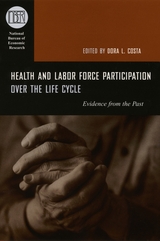 Health and Labor Force Participation over the Life Cycle: Evidence from the Past
Edited by Dora L. Costa
University of Chicago Press, 2003 The twentieth century saw significant increases in both life expectancy and retirement rates-changes that have had dramatic impacts on nearly every aspect of society and the economy. Forecasting future trends in health and retirement rates, as we must do now, requires investigation of such long-term trends and their causes.
To that end, this book draws on new data-an extensive longitudinal survey of Union Army veterans born between 1820 and 1850-to examine the factors that affected health and labor force participation in nineteenth-century America. Contributors consider the impacts of a variety of conditions-including social class, wealth, occupation, family, and community-on the morbidity and mortality of the group. The papers investigate and address a number of special topics, including the influence of previous exposure to infectious disease, migration, and community factors such as lead in water mains. They also analyze the roles of income, health, and social class in retirement decisions, paying particular attention to the social context of disability.
Economists and historians who specialize in demography or labor, as well as those who study public health, will welcome the unique contributions offered by this book, which offers a clearer view than ever before of the workings and complexities of life, death, and labor during the nineteenth century.
 Health and Social Change in International Perspective
Lincoln C. Chen
Harvard University Press, 1994 Health and Social Change in International Perspective brings together an unprecedented interdisciplinary series of approaches to understanding the social dimensions of health change around the world. The seventeen contributors—demographers, epidemiologists, economists, anthropologists, public health scientists—are among the intellectual leaders of efforts to respond to the world’s health challenges.
Moving beyond the limits of established theories about demographic and epidemiologic transition, this book offers broad explorations of the social causes and consequences of health change. Consensus is reached on some matters, but critical debate and controversy predominate in others. The authors address several critical questions: What are the forms and structures of health transitions? Do these changes assume universally consistent patterns, or are health transitions particularistic, reflecting space, time, and community? What are the methodological issues in definition and measurement? And how can understanding improve health policy, interventions, and the research agenda?
Exploring new frontiers of a vital topic, Health and Social Change in International Perspective is an invaluable resource for social and health scientists working to understand world health change.
Health and Society in Early Modern Sweden
Mari Eyice
Amsterdam University Press, 2024 The understanding of what health is and how it can be maintained has changed through history. Questions like who can perform healing? and what sort of bodies are considered healthy? have elicited widely divergent responses in different societies. This volume explores how health was understood and practiced in the early modern Nordic region, with a focus on Sweden, including Finland. The chapters examine topics such as the dyslexia of Charles XI, lay perceptions of bodily and mental variability, and the health benefits attributed to using the sauna. Together, the essays give a holistic view of how practices of health evolved in close symmetry with societal institutions and localised worldviews. As such, the volume is a timely intervention into the social history of medicine, contributing to the historicisation of health as a concept and shedding light on developments in the Nordic world.
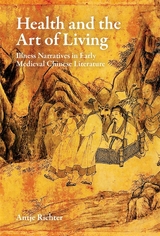 Health and the Art of Living: Illness Narratives in Early Medieval Chinese Literature
Antje Richter
Harvard University Press, 2025 Health and the Art of Living offers reflections on health and illness in early medieval Chinese literature (ca. 200–ca. 600). Surveying a range of literary sources—essays, prefaces, correspondence, religious scriptures, and poetry—it explores the spectrum of views on health and illness expressed in these texts. Part One, centered on the essay “Nurturing the Vital Breath” in Liu Xie’s Literary Mind and the Carving of Dragons, reveals the deep concern of writers, troubled by overwork and excessive mental exertion, with the preservation and cultivation of their literary creativity. For them, the ability to write was inextricably connected with their social roles as officials. Part Two turns to self-narratives of health and illness in authorial prefaces, informal notes, formal letters, and official communications. Writers of these texts depicted their physical condition according to specific rhetorical purposes, whether that was to legitimize authorship, maintain intimate relationships, or avoid office. Part Three describes the rise of sickbed poetry, shaped by Xie Lingyun and the Vimalakīrti-nirdeśa-sūtra, which established illness as a topic in the refined literature of the period. Drawing attention to the grounding of literature in the lived experience of their creators, this book illuminates the conditions of literary production in early medieval China.
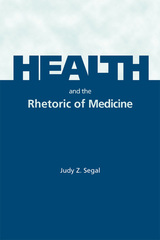 Health and the Rhetoric of Medicine
Judy Z. Segal
Southern Illinois University Press, 2005 Assessing rhetorical principles of contemporary health issues Hypochondriacs are vulnerable to media hype, anorexics are susceptible to public scrutiny, and migraine sufferers are tainted with the history of the “migraine personality,” maintains rhetorical theorist Judy Z. Segal. All are influenced by the power of persuasion. Health and the Rhetoric of Medicine explores persistent health conditions that resist conventional medical solutions. Using a range of rhetorical principles, Segal analyzes how patients and their illnesses are formed within the physician/patient relationship. The intractable problem of a patient’s rejection of a doctor’s advice, says Segal, can be considered a rhetorical failure—a failure of persuasion. Examining the discourse of medicine through case studies, applications, and analyses, Segal illustrates how illnesses are described in ways that limit patients’ choices and satisfaction. She also illuminates psychiatric conditions, infectious diseases, genetic testing, and cosmetic surgeries through the lens of rhetorical theory. Health and the Rhetoric of Medicine bridges critical analysis for scholarly, professional, and lay audiences. Segal highlights the persuasive element in diagnosis, health policy, illness experience, and illness narratives. She also addresses questions of direct-to-consumer advertising of prescription drugs, the role of health information in creating the “worried well” and problems of trust and expertise in physician/patient relationships. A useful resource for critical common sense in everyday life, the text provides an effective examination of a society increasingly influenced by the rhetoric of health and medicine.
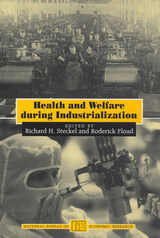 Health and Welfare during Industrialization
Edited by Richard H. Steckel and Roderick Floud
University of Chicago Press, 1997 In this unique anthology, Steckel and Floud coordinate ten essays that bring a new perspective to inquiry about standard of living in modern times. These papers are arranged for international comparison, and they individually examine evidence of health and welfare during and after industrialization in eight countries: the United States, Britain, Sweden, the Netherlands, France, Germany, Japan, and Australia.
The essays incorporate several indicators of quality of life, especially real per capita income and health, but also real wages, education, and inequality. And while the authors use traditional measures of health such as life expectancy and mortality rates, this volume stands alone in its extensive use of new "anthropometric" data—information about height, weight and body mass index that indicates changes in nations' well-being. Consequently, Health and Welfare during Industrialization signals a new direction in economic history, a broader and more thorough understanding of what constitutes standard of living.
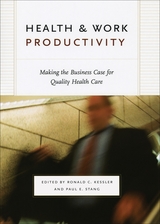 Health and Work Productivity: Making the Business Case for Quality Health Care
Edited by Ronald C. Kessler and Paul E. Stang
University of Chicago Press, 2006 A recent study of productivity in the workplace revealed that workers spend on average eight percent of their workday doing nothing. This statistic takes on greater significance when we find that health problems impact employee productivity loss by an even greater percentage. In light of this discovery, a group of leading experts from the emerging field of health and productivity research argues that the expansion of health care benefits represents a substantial investment opportunity for employers.
Health and Work Productivity presents state-of-the-art health and productivity research that suggests interventions aimed at prevention, early detection, and best-practice treatment of workers along with an informed allocation strategy can produce significant cost-benefits for employers. Contributors cover all the major aspects of this new area of research: approaches to studying the effects of health on productivity, ways for employers to estimate the costs of productivity loss, concrete suggestions for future research developments in the area, and the implications of this research for public policy.
Health at Fifty
William H. Robey
Harvard University Press For thirty-three years the Faculty of the Harvard Medical School has given a series of free Sunday afternoon lectures, making available to the public current knowledge of the causation, treatment, and prevention of disease. The lectures have attained an established place in the program of events in Greater Boston, and have maintained large, usually capacity, audiences. The demand for copies of various lectures has been so great that we have now chosen twelve of the most popular ones from the last two or three years, for publication in this timely volume. Its aim is to clarify, explain, and interpret the recent developments in various fields of medicine and research, to warn of unsuspected dangers, and to stress the necessity of seeking sources of skilled advice rather than temporizing, depending on personal interpretation of symptoms, or tampering with drugs, techniques, or cults which have neither efficacy nor scientific basis.
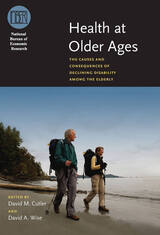 Health at Older Ages: The Causes and Consequences of Declining Disability Among the Elderly
Edited by David M. Cutler and David A. Wise
University of Chicago Press, 2009 Americans are living longer—and staying healthier longer—than ever before. Despite the rapid disappearance of pensions and health care benefits for retirees, older people are healthier and better off than they were twenty years ago. In Health at Older Ages, a distinguished team of economists analyzes the foundations of disability decline, quantifies this phenomenon in economic terms, and proposes what might be done to accelerate future improvements in the health of our most elderly populations.
This breakthrough volume argues that educational attainment, high socioeconomic status, an older retirement age, and accessible medical care have improved the health and quality of life of seniors. Along the way, it outlines the economic benefits of disability decline, such as an increased rate of seniors in the workplace, relief for the healthcare system and care-giving families, and reduced medical expenses for the elderly themselves. Health at Older Ages will be an essential contribution to the debate about meeting the medical needs of an aging nation.
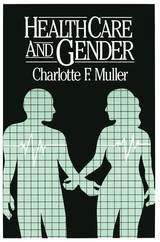 Health Care and Gender
Charlotte Muller
Russell Sage Foundation, 1990 Health and medical services should meet individuals' needs regardless of gender, but in both subtle and overt ways this is very often not the case. Gender biases result not only in flawed access to care but also in insufficient medical research, uninformed diagnoses, and gaps in covering critical needs. In Health Care and Gender, Charlotte Muller provides a contemporary assessment of the forces that sustain gender biases in the health and medical professions. Beginning with an analysis of gender comparisons in health care usage and adequacy of treatment, Muller discusses the experiences of many different women: working women with insurance coverage, the poor dependent on Medicaid, and the elderly. She also focuses on the issues facing women of reproductive age and shows how poverty or extremely volatile political and ethical controversy may impede their search for basic maternity and family planning services. Drawing on a large body of evidence from medical, health, and behavioral literature and from national statistics, Health Care and Gender probes a timely and crucial topic. For scholars, analysts, and policy makers interested in women's studies, health and medical care, gerontology, consumer and labor economics, and social justice. Muller's thorough analysis looks to the future by presenting agendas for reform, research, and evaluation.
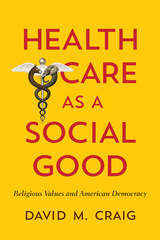 Health Care as a Social Good: Religious Values and American Democracy
David M. Craig
Georgetown University Press, 2016 David M. Craig traveled across the United States to assess health care access, delivery and finance in this country. He interviewed religious hospital administrators and interfaith activists, learning how they balance the values of economic efficiency and community accountability. He met with conservatives, liberals, and moderates, reviewing their ideas for market reform or support for the Affordable Care Act. He discovered that health care in the US is not a private good or a public good. Decades of public policy and philanthropic service have made health care a shared social good. Health Care as a Social Good: Religious Values and the American Democracy argues that as escalating health costs absorb more and more of family income and government budgets, we need to take stock of the full range of health care values to create a different and more affordable community-based health care system. Transformation of that system is a national priority but Americans have failed to find a way to work together that bypasses our differences. Craig insists that community engagement around the common religious conviction that healing is a shared responsibility can help us achieve this transformation—one that will not only help us realize a new and better system, but one that reflects the ideals of American democracy and the common good.
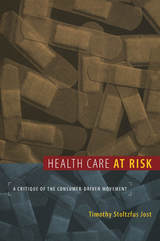 Health Care at Risk: A Critique of the Consumer-Driven Movement
Timothy Stoltzfus Jost
Duke University Press, 2007 In Health Care at Risk Timothy Stoltzfus Jost, a leading expert in health law, weighs in on consumer-driven health care (CDHC), which many policymakers and analysts are promoting as the answer to the severe access, cost, and quality problems afflicting the American health care system. The idea behind CDHC is simple: consumers should be encouraged to save for medical care with health savings accounts, rely on these accounts to cover routine medical expenses, and turn to insurance only to cover catastrophic medical events. Advocates of consumer-driven health care believe that if consumers are spending their own money on medical care, they will purchase only services with real value to them. Jost contends that supporters of CDHC rely on oversimplified ideas about health care, health care systems, economics, and human nature. In this concise, straightforward analysis, Jost challenges the historical and theoretical assumptions on which the consumer-driven health care movement is based and reexamines the empirical evidence that it claims as support. He traces the histories of both private health insurance in the United States and the CDHC movement. The idea animating the drive for consumer-driven health care is that the fundamental problem with the American health care system is what economists call “moral hazard,” the risk that consumers overuse services for which they do not bear the cost. Jost reveals moral hazard as an inadequate explanation of the complex problems plaguing the American health care system, and he points to troubling legal and ethical issues raised by CDHC. He describes how other countries have achieved universal access to high-quality health care at lower cost, without relying extensively on cost sharing, and he concludes with a proposal for how the United States might do the same, incorporating aspects of CDHC while recognizing its limitations.
 Health Care Ethics: A Catholic Theological Analysis, Fifth Edition
Benedict M. Ashley, OP, Jean deBlois, CSJ, and Kevin D. O'Rourke, OP
Georgetown University Press, 2006 Health Care Ethics is a comprehensive study of significant issues affecting health care and the ethics of health care from the perspective of Catholic theology. It aims to help Christian, and especially Catholic, health care professionals solve concrete problems in terms of principles rooted in scripture and tested by individual experience; however, its basis in real medical experience makes this book a valuable resource for anyone with a general interest in health care ethics. This fifth edition, which includes important contributions by Jean deBlois, C.S.J., considers everyday ethical questions and dilemmas in clinical care and deals more deeply with issues of women's health, mental health, sexual orientation, artificial reproduction, and the new social issues in health care. The authors devote special attention to the various ethical theories currently in use in the United States while clearly presenting a method of ethical decision making based in the Catholic tradition. They discuss the needs of the human person, outlining what it means to be human, both as an individual and as part of a community. This volume has been significantly updated to include new discussions of recent clinical innovations and theoretical issues that have arisen in the field: • the Human Genome Project
• efforts to control sexual selection of infants
• efforts to genetically modify the human genotype and phenotype
• the development of palliative care as a medical specialty
• the acceptance of non-heart beating persons as organ donors
• embryo development and stem cell research
• reconstructive and cosmetic surgery
• nutrition and obesity
• medical mistakes
• the negative effects of managed care on the patient-physician relationship
• recent papal allocution regarding care of patients in a persistent vegetative state and palliative care for dying patients
 Health Care Ethics: A Theological Analysis, Fourth Edition
Benedict M. Ashley, OP, and Kevin D. O'Rourke, OP, Editors
Georgetown University Press, 1997 This fourth edition of Health Care Ethics provides a contemporary study of broad and major issues affecting health care and the ethics of health care from the perspective of Catholic teachings and theological investigation. It aims to help Christian, and especially Catholic, health care professionals solve concrete problems in terms of principles rooted in Scripture and tested by individual experience. Since the last edition of Health Care Ethics, there have been many changes in the fields of health care medicine and theology that have necessitated a fourth edition. Ashley and O'Rourke have revised their seminal work to address the publication of significant documents by the Church and the restructuring of the health care system. Features of the revised fourth edition: • Discusses significant Church documents issued since the third edition includes "The Splendor of Truth" (Veritatis Splendor), and the "Gospel of Life" (Evangelium Vitae); the "Instruction on the Vocation of Theologians"; the Catechism of the Catholic Church; and the Revised Ethical and Religious Directives for Catholic Health Services. • Examines the implications of managed care techniques. • Probes such changes in the practice of medicine as the new emphasis on preventive care, the involvement of individuals in their own care, greater use of pharmaceuticals in psychiatry, and the greater role of genetics in diagnosis and prognosis. • Explores the quest for more compassionate care of the dying. • Updates the bibliography.
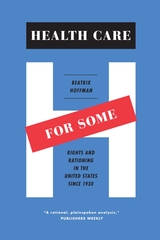 Health Care for Some: Rights and Rationing in the United States since 1930
Beatrix Hoffman
University of Chicago Press, 2012 In Health Care for Some, Beatrix Hoffman offers an engaging and in-depth look at America’s long tradition of unequal access to health care. She argues that two main features have characterized the US health system: a refusal to adopt a right to care and a particularly American approach to the rationing of care. Health Care for Some shows that the haphazard way the US system allocates medical services—using income, race, region, insurance coverage, and many other factors—is a disorganized, illogical, and powerful form of rationing. And unlike rationing in most countries, which is intended to keep costs down, rationing in the United States has actually led to increased costs, resulting in the most expensive health care system in the world.
While most histories of US health care emphasize failed policy reforms, Health Care for Some looks at the system from the ground up in order to examine how rationing is experienced by ordinary Americans and how experiences of rationing have led to claims for a right to health care. By taking this approach, Hoffman puts a much-needed human face on a topic that is too often dominated by talking heads.
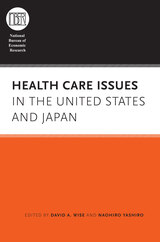 Health Care Issues in the United States and Japan
Edited by David A. Wise and Naohiro Yashiro
University of Chicago Press, 2006 Recent data show wide disparity between Japan and the United States in the effectiveness of their health care systems. Japan spends close to the lowest percentage of its gross domestic product on health care among OECD countries, the United States spends the highest, yet life expectancies in Japan are among the world’s longest. Clearly, a great deal can be learned from a comprehensive comparative analysis of health care issues in these two countries.
In Health Care Issues in the United States and Japan, contributors explore the structural characteristics of the health care systems in both nations, the economic incentives underlying the systems, and how they operate in practice. Japan’s system, they show, is characterized by generous insurance schemes, a lack of gatekeepers, and fee-for-service mechanisms. The United States’ structure, on the other hand, is distinguished by for-profit hospitals, privatized health insurance, and managed care. But despite its relative success, an aging population and a general shift from infectious diseases to more chronic maladies are forcing the Japanese to consider a model more closely resembling that of the United States.
In an age when rising health care costs and aging populations are motivating reforms throughout the world, this timely study will prove invaluable.
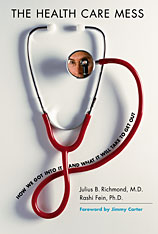 The Health Care Mess: How We Got Into It and What It Will Take To Get Out
Julius B. Richmond and Rashi Fein, Ph.D.
Harvard University Press, 2005 If we can decode the human genome and fashion working machines out of atoms, why can't we navigate the quagmire that is our health care system? In this important new book, Julius Richmond and Rashi Fein recount the fraught history of health care in America since the 1960s. After the advent of Medicare and Medicaid and with the progressive goal to make advances in medical care available to all, medical costs began their upward spiral. Cost control measures failed and led to the HMO revolution, turning patients into consumers and doctors into providers. The swelling ranks of Americans without any insurance at all dragged the United States to the bottom of the list of industrialized nations.
Over the last century medical education was also profoundly transformed into today's powerful triumvirate of academic medical centers, schools of medicine and public health, and research programs, all of which have shaped medical practice and medical care. The authors show how the promises of medical advances have not been matched either by financing or by delivery of care.
As a new crisis looms, and the existing patchwork of insurance is poised to unravel, American leaders must again take up the question of health care. This book brings the voice of reason and the promise of compromise to that debate.
The Health Care Professional as Friend and Healer: Building on the Work of Edmund D. Pellegrino
David C. Thomasma and Judith Lee Kissell, Editors
Georgetown University Press, 2000 This book illuminates issues in medical ethics revolving around the complex bond between healer and patient, focusing on friendship and other important values in the healing relationship. Embracing medicine, philosophy, theology, and bioethics, it considers whether bioethical issues in medicine, nursing, and dentistry can be examined from the perspective of the healing relationship rather than external moral principles. Distinguished contributors explore the role of the health professional, the moral basis of health care, greater emphasis on the humanities in medical education, and some of the current challenges facing healers today.
 Health Care Reform: A Human Rights Approach
Audrey R. Chapman, Editor
Georgetown University Press, 1994 Arguing that health care should be a human right rather than a commodity, the distinguished contributors to this volume call for a new social covenant establishing a right to a standard of health care consistent with society's level of resources. By linking rights with limits, they offer a framework for seeking national consensus on a cost-conscious standard of universal medical care. The authors identify the policy implications of recognizing and implementing such a right and develop specific criteria to measure the success of health care reform from a human rights perspective. Health Care Reform also offers specific and timely criticism of managed competition and its offspring, the Clinton plan for health care reform. Because health care reform will inevitably be an ongoing process of assessment and revision—especially since managed competition has not been implemented elsewhere—this book will last beyond the moment by providing vital standards to guide the future evolution of the health care system.
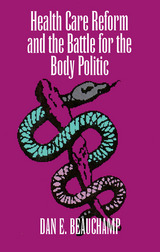 Health Care Reform and the Battle for the Body Politic
Dan Beauchamp
Temple University Press, 1996 "Dan Beauchamp's important book melds a personal odyssey, an abiding, passionate commitment to one version of comprehensive health reform, and highly disciplined political analysis. His years in the Cuomo Administration provide him with rich insight into how that scion of liberalism inched toward, but ultimately shied away from, major health reform in the Empire State. His provocative assessment of the missed opportunities represented by the Clinton health plan also deserves the attention of any serious student of health politics and policy."
--Frank J. Thompson, Professor of Dean, Graduate School of Public Affairs, State University of New York at Albany
While most studies of health care reform have focused on solving the market's failure, controlling costs, or providing universal access, Dan E. Beauchamp adeptly discusses health care reform as a strategy for dealing with the failures of politics--not just the failures of the health care market. As the former Deputy Commissioner for Policy and Planning for the New York State Department of Health, Beauchamp presents a revelatory first-person narrative about his work to develop a universal health care and insurance plan for New York State. His enlightening personal account includes discussions of his efforts to develop a national model of the New York plan for Mario Cuomo (during the period when the governor considered running for the Democratic nomination for president), and his perceptive critique of the failed Clinton plan for reform.
Beauchamp gets beyond topics like global budgets, rate-setting, and managed competition to outline the idea of health plans as a means for the public to come together in a way that will change forever the way we think about health care, which he calls "the battle for the body politic." A large part of engaging in the "battle," he argues, involves addressing and resolving racial and class divisions that have always underscored America's political reality. Ultimately, Beauchamp argues for a reform that would promote health and social equality, one that would change and strengthen our social awareness of health care as a common good.
"Dan Beauchamp is a singular and important voice in the ongoing health care debate. Instead of focusing on the technical details of health reform, he spins a compelling personal narrative, entices the reader into the truly important questions: How do health plans work politically? How can they change the way we think about health, health care and ourselves as a country? While economists focus on financing schemes, and bioethicists search for underlying values, Beauchamp probes how a health care system shapes our politics and affects our experience of who we are as Americans. His book is exceedingly valuable; it reveals just how much is at stake in health care reform."
--Larry R. Churchill, Professor and Chair, Department of Social Medicine, University of North Carolina at Chapel Hill
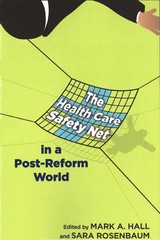 The Health Care Safety Net in a Post-Reform World
Hall, Mark A
Rutgers University Press, 2012 The Health Care Safety Net in a Post-Reform World examines how national health care reform will impact safety net programs that serve low-income and uninsured patients. The “safety net” refers to the collection of hospitals, clinics, and doctors who treat disadvantaged people, including those without insurance, regardless of their ability to pay. Despite comprehensive national health care reform, over twenty million people will remain uninsured. And many of those who obtain insurance from reform will continue to face shortages of providers in their communities willing or able to serve them. As the demand for care grows with expanded insurance, so will the pressure on an overstretched safety net.
This book, with contributions from leading health care scholars, is the first comprehensive assessment of the safety net in over a decade. Rather than view health insurance and the health care safety net as alternatives to each other, it examines their potential to be complementary aspects of a broader effort to achieve equity and quality in health care access. It also considers whether the safety net can be improved and strengthened to a level that can provide truly universal access, both through expanded insurance and the creation of a well-integrated and reasonably supported network of direct health care access for the uninsured. Seeing safety net institutions as key components of post-health care reform in the United States—as opposed to stop-gap measures or as part of the problem—is a bold idea. And as presented in this volume, it is an idea whose time has come.
Health Colonialism: Urban Wastelands and Hospital Frontiers
Shiloh Krupar
University of Minnesota Press, 2023 The role of American hospital expansions in health disparities and medical apartheid
Health Colonialism considers how U.S. urban development policies contribute to the uneven and unjust distribution of health care in this country. Here, Shiloh Krupar investigates the racially inequitable effects of elite U.S. hospitals on their surrounding neighborhoods and their role in consolidating frontiers of land primed for redevelopment. Naming this frontier “medical brownfields,” Krupar shows how hospitals leverage their domestic real estate empires to underwrite international prospecting for patients and overseas services and specialty clinics. Her pointed analysis reveals that decolonizing health care efforts must scrutinize the land practices of nonprofit medical institutions and the liberal foundations of medical apartheid perpetuated by globalizing American health care.
Health, Culture, and Community
Benjamin D. Paul
Russell Sage Foundation, 1955 This casebook documents public reactions to health programs and health situations in sixteen widely differing communities of the world. Some of the studies record successes, others failures. Of interest to anyone concerned with preventive medicine, public health, community betterment, or cultural problems involving peoples of different backgrounds and beliefs.
 Health Dimensions of Sex and Reproduction: The Global Burden of Sexually Transmitted Diseases, HIV, Maternal Conditions, Perinatal Disorders, and Congenital Anomalies
Christopher J. L. Murray
Harvard University Press, 1998 From the health risks of sexual activity to those of pregnancy, abortion, and childbirth, reproduction constitutes enormous risks to a woman’s health. Ill-health conditions related to sex and reproduction account for 25 percent of the global disease burden in adult women. In sub-Saharan Africa, they account for over 40 percent. The catastrophic effects of reproductive ill-health, however, are not limited to women; for infants and adult men, they inflict 25 percent and 1 percent respectively of the global burden.
This volume offers comprehensive data and detailed discussions of the epidemiologies of three sexually transmitted diseases, HIV, and five specific maternal conditions, as well as those of congenital anomalies and perinatal conditions. Projections of the HIV epidemic are provided: by 2020 HIV is projected to double to 2.5 percent of the global disease burden.
Health Dimensions of Sex and Reproduction will serve as a comprehensive reference for epidemiologists, public health specialists, practitioners and advocates of STD and HIV prevention, and reproductive and neonatal health.
 Health, Disease, and Illness: Concepts in Medicine
Arthur L. Caplan, James J. McCartney, and Dominic A. Sisti. Foreword byEdmund D. Pellegrino
Georgetown University Press, 2004 In the 1850s, "Drapetomania" was the medical term for a disease found among black slaves in the United States. The main symptom was a strange desire to run away from their masters. In earlier centuries gout was understood as a metabolic disease of the affluent, so much so that it became a badge of uppercrust honor—and a medical excuse to avoid hard work. Today, is there such a thing as mental illness, or is mental illness just a myth? Is Alzheimer's really a disease? What is menopause—a biological or a social construction? Historically one can see that health, disease, and illness are concepts that have been ever fluid. Modern science, sociology, philosophy, even society—among other factors—constantly have these issues under microscopes, learning more, defining and redefining ever more exactly. Yet often that scrutiny, instead of leading toward hard answers, only leads to more questions. Health, Disease, and Illness brings together a sterling list of classic and contemporary thinkers to examine the history, state, and future of ever-changing "concepts" in medicine. Divided into four parts—Historical Discussions; Characterizing Health, Disease, and Illness; Clinical Applications of Health and Disease; and Normalcy, Genetic Disease, and Enhancement: The Future of the Concepts of Health and Disease—the reader can see the evolutionary arc of medical concepts from the Greek physician Galen of Pergamum (ca. 150 ce) who proposed that "the best doctor is also a philosopher," to contemporary discussions of the genome and morality. The editors have recognized a crucial need for a deeper integration of medicine and philosophy with each other, particularly in an age of dynamically changing medical science—and what it means, medically, philosophically, to be human.
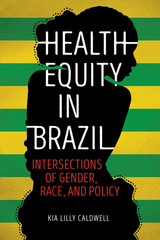 Health Equity in Brazil: Intersections of Gender, Race, and Policy
Kia Lilly Caldwell
University of Illinois Press, 2017 Brazil's leadership role in the fight against HIV has brought its public health system widespread praise. But the nation still faces serious health challenges and inequities. Though home to the world's second largest African-descendant population, Brazil failed to address many of its public health issues that disproportionately impact Afro-Brazilian women and men. Kia Lilly Caldwell draws on twenty years of engagement with activists, issues, and policy initiatives to document how the country's feminist health movement and black women's movement have fought for much-needed changes in women's health. Merging ethnography with a historical analysis of policies and programs, Caldwell offers a close examination of institutional and structural factors that have impacted the quest for gender and racial health equity in Brazil. As she shows, activists have played an essential role in policy development in areas ranging from maternal mortality to female sterilization. Caldwell's insightful portrait of the public health system also details how its weaknesses contribute to ongoing failures and challenges while also imperiling the advances that have been made.
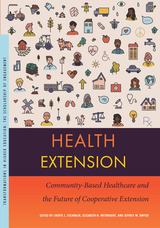 Health Extension: Community-Based Healthcare and the Future of Cooperative Extension
Cheryl L. Eschbach
Michigan State University Press, 2024 Health Extension: Community-Based Healthcare and the Future of Cooperative Extension explores innovation in extension health programs, engaged scholarship promoting research-based information in communities, and the evaluation and documentation of community programs and their impacts. This volume provides land-grant and university-based colleagues up-to-date information on using the Cooperative Extension System (CES) for community engagement in healthcare while also familiarizing those outside CES and the academy with a roadmap for improvement. The contributions of a diverse array of scholars challenge the status quo in extension programs by characterizing the introspection, understanding, creativity, partnerships, and leadership that will be required to improve lives and communities in the twenty-first century. This perspective underscores the role of CES as foundational to the future of Health Extension and offers an alternative to approaches that utilize the CES as a model without the accompanying advantages of history, community embeddedness, and sustainability.
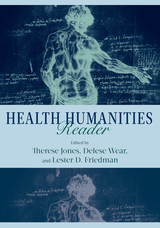 Health Humanities Reader
Jones, Therese
Rutgers University Press, 2014 Over the past forty years, the health humanities, previously called the medical humanities, has emerged as one of the most exciting fields for interdisciplinary scholarship, advancing humanistic inquiry into bioethics, human rights, health care, and the uses of technology. It has also helped inspire medical practitioners to engage in deeper reflection about the human elements of their practice.
In Health Humanities Reader, editors Therese Jones, Delese Wear, and Lester D. Friedman have assembled fifty-four leading scholars, educators, artists, and clinicians to survey the rich body of work that has already emerged from the field—and to imagine fresh approaches to the health humanities in these original essays. The collection’s contributors reflect the extraordinary diversity of the field, including scholars from the disciplines of disability studies, history, literature, nursing, religion, narrative medicine, philosophy, bioethics, medicine, and the social sciences.
With warmth and humor, critical acumen and ethical insight, Health Humanities Reader truly humanizes the field of medicine. Its accessible language and broad scope offers something for everyone from the experienced medical professional to a reader interested in health and illness.
Health, Hygiene and Eugenics in Southeastern Europe to 1945
Christian Promitzer
Central European University Press, 2011 This volume is a collection of chapters that deal with issues of health, hygiene and eugenics in Southeastern Europe to 1945, specifically, in Bosnia-Herzegovina, Bulgaria, Croatia, Greece and Romania. Its major concern is to examine the transfer of medical ideas to society via local, national and international agencies and to show in how far developments in public health, preventive medicine, social hygiene, welfare, gender relations and eugenics followed a regional pattern. This volume provides insights into a region that has to date been marginal to scholarship of the social history of medicine.
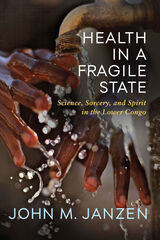 Health in a Fragile State: Science, Sorcery, and Spirit in the Lower Congo
John M. Janzen
University of Wisconsin Press, 2019 Based on extensive field research in the Manianga region of the Lower Congo, Health in a Fragile State is an anthropological account of public health and health care after the collapse of the Congolese state in the 1980s and 1990s. This work brings into focus John M. Janzen's earlier books on African health and healing, revealing the collaborative effort by local, national, and international agencies to create viable alternative institutions to those that represented the centralized state. This book documents and analyzes the realignment of existing institutions and the creation of new ones that shape health and healing.
Janzen explores the manner in which power and information, including science, are legitimized in the preservation and improvement of health. Institutional validity and knowledge empower citizens and health practitioners to gain the upper hand over the region's principal diseases, including malaria, tuberculosis, typhoid, and HIV/AIDS.
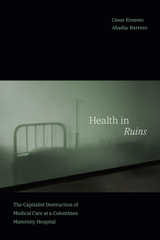 Health in Ruins: The Capitalist Destruction of Medical Care at a Colombian Maternity Hospital
César Ernesto Abadía-Barrero
Duke University Press, 2022 In Health in Ruins César Ernesto Abadía-Barrero chronicles the story of El Materno—Colombia’s oldest maternity and neonatal health center and teaching hospital—over several decades as it faced constant threats of government shutdown. Using team-based and collaborative ethnography to analyze the social life of neoliberal health policy, Abadía-Barrero details the everyday dynamics around teaching, learning, and working in health care before, during, and after privatization. He argues that health care privatization is not only about defunding public hospitals; it also ruins rich traditions of medical care by denying or destroying ways of practicing medicine that challenge Western medicine. Despite radical cuts in funding and a corrupt and malfunctioning privatized system, El Materno’s professors, staff, and students continued to find ways to provide innovative, high-quality, and noncommodified health care. By tracking the violences, conflicts, hopes, and uncertainties that characterized the struggles to keep El Materno open, Abadía-Barrero demonstrates that any study of medical care needs to be embedded in larger political histories.
Health Informatics: Technologies and applications
Gaurav Gupta
The Institution of Engineering and Technology, 2025 Health Informatics: Technologies and applications covers technological advances in healthcare that contribute to precision medicine and early detection of diseases. The editors explore the evolution of medical devices with attention to data management, patient safety and cost effectiveness.
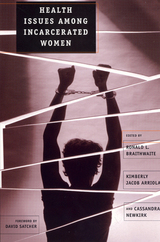 Health Issues Among Incarcerated Women
Edited by Ronald L. Braithwaite, Kimberly Jacob Arriola, and Cassandra Newkirk
Rutgers University Press, 2006 The female inmate population in the United States has exploded in the past two decades, increasing nearly six-fold. The U.S. correctional system, however, has not expanded its health care to provide for this growing population of women. This comprehensive reader addresses the physical and mental needs of women inmates and suggests that they cannot be properly treated unless their lifestyles before, during, and after incarceration are considered. This book abounds with statistics that outline the unique needs of the female inmate population. For instance, a significant proportion of female inmates suffer physical and sexual violence before serving time. Incarcerated teenagers are more likely than others from their age group to have engaged in behaviors that increased their risk for contracting sexually transmitted diseases like HIV. Because African American women are more likely than their counterparts to encounter prison time, their needs warrant specific attention. Bringing together twenty original essays, this volume will be invaluable for lobbyists and policy makers as well as for graduate students and faculty in the fields of criminal justice and public health.
Health Issues in Latino Males: A Social and Structural Approach
Aguirre-Molina, Marilyn
Rutgers University Press, 2010 It is estimated that more than 50 million Latinos live in the United States. This is projected to more than double by 2050. In Health Issues in Latino Males experts from public health, medicine, and sociology examine the issues affecting Latino men's health and recommend policies to overcome inequities and better serve this population. The book addresses sexual and reproductive health; alcohol, tobacco, and drug use; mental and physical health among those in the juvenile justice or prison systems; chronic diseases; HIV/AIDS; Alzheimer's and dementia; and health issues among war veterans. It discusses utilization, insurance coverage, and research programs, and includes an extensive appendix charting epidemiological data on Latino health.
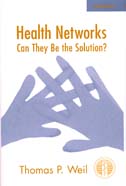 Health Networks: Can They Be the Solution?
Thomas P. Weil
University of Michigan Press, 2001 Thomas P. Weil believes that the formation of health networks, or integrated delivery systems, represents a more sophisticated attempt to restructure America's health system than those previously undertaken. He argues that this is so because integrated delivery systems require the application of established business principles and well-researched clinical acumen to the delivery of medical care services. This book evaluates whether recently formed health networks can generate enough fiscal savings to provide greater access to and quality of health care despite the current trend of cutbacks in reimbursement from Medicare and managed care plans.
Unfortunately, most hospitals that have formed alliances with a previous competitor or nearby teaching facility have found that they are not yet achieving the savings originally forecast. Weil finds that these shortcomings often have been caused by the difficulties in achieving a strategic fit between two partners, in finding a middle ground when differences in culture and values surface, and in implementing operational efficiencies. The book concludes with a discussion of a number of ways in which networks might cut costs in the future.
Health Networks will be of interest to medical practitioners and administrators, as well as to students in health services management programs.
Thomas P. Weil is President, Bedford Health Associates, Inc., management consultants for health and hospital services.
 The Health of the Commonwealth: A Brief History of Medicine, Public Health, and Disease in Pennsylvania
James E. Higgins
Temple University Press, 2020 “The history of medicine in Pennsylvania is no less vital to understanding the state’s past than is its political or industrial history,” writes James Higgins in The Health of the Commonwealth, his overview of medicine and public health in the state. Covering the outbreak of yellow fever in 1793 through the 1976 Legionnaire’s Disease epidemic, and the challenges of the present day, he shows how Pennsylvania has played a central role in humanity’s understanding of—and progress against—disease. Higgins provides close readings of specific medical advances—for instance, scientists at the University of Pittsburgh discovered the polio vaccine—and of disease outbreaks, like AIDS. He examines sanitation and water purification efforts, allopathic medicine and alternative therapies, and the building of the state’s tuberculosis sanitaria. Higgins also describes Native American and pre-modern European folk medicine, the rise of public health in the state, and women’s roles in both folk and scientific medicine. The Health of the Commonwealth places Pennsylvania’s unique contribution to the history of public health and medicine in a larger narrative of health and disease throughout the United States and the world.
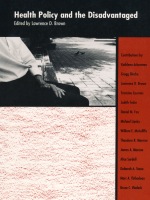 Health Policy and the Disadvantaged
Lawrence D. Brown, ed.
Duke University Press, 1991 This important collection of essays, originating in a 1989 conference on the disadvantaged in American health care, provides incisive commentary on U.S. health care policy and politics. Examining public responses to health crises and analyzing the political logic of the American community, this volume charts the immobility of U.S. health policy in recent years and points to its disastrous consequences for the 1990s. Focusing on the particular needs of disadvantaged groups—the elderly, children, people with AIDS, the mentally ill, the chemically dependent, the homeless, the hungry, the medically uninsured—these essays develop strong policy statements. The authors describe the growth in U.S. health care programs, from Kerr-Mills to Medicare, Medicaid, and subsequent revisions, and stress the serious omissions resulting from incremental policy expansion, both in identifying disadvantaged groups and in implementing programs. They report the weakness of the U.S. health care system compared to systems of other technologically developed countries. Contributors. Deborah A. Stone and Theodore R. Marmor, Judith Feder, Alice Sardell, Bruce C. Vladeck, Michael Lipsky and Marc A. Thibodeau, Daniel M. Fox, William E. McAuliffe, M. Gregg Bloche and Francine Cournos, Lawrence D. Brown, James A. Morrone
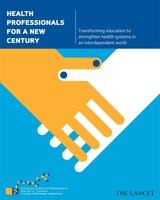 Health Professionals for a New Century: Transforming Education to Strengthen Health Systems in an Interdependent World
Julio Frenk and Lincoln C. Chen
Harvard University Press One hundred years ago a series of seminal documents, starting with the Flexner Report of 1910, sparked an enormous burst of energy to harness the power of science to transform higher education in health. Professional education, however, has not been able to keep pace with the challenges of the 21st century. A new generation of reforms is needed to meet the demands of health systems in an interdependent world.
The report of the Commission on the Education of Health Professionals for the 21st Century, a global independent initiative consisting of 20 leaders from diverse disciplinary backgrounds and institutional affiliations, articulates a fresh vision and recommends renewed actions. Building on a rich legacy of educational reforms during the past century, the Commission’s findings and recommendations adopt a global and multi-professional perspective using a systems approach to analyze education and health, with a focus on institutional and instructional reforms.
Health Psychology: A Discipline and a Profession
Edited by George C. Stone
University of Chicago Press, 1987 In 1976, a small group of psychologists urged that more research be done on aspects of health and health care outside the domain of mental health. Today, health psychology is one of the fastest growing divisions of the American Psychological Association; journals and textbooks in increasing numbers are another signal of rapid growth in this field.
 Health Sector Reform in Developing Countries: Making Health Development Sustainable
Peter Berman
Harvard University Press, 1995 In Mexico City or Nairobi or Manila, a young girl in one part of the city is near death with measles, while, not far away, an elderly man awaits transplantation of a new kidney. How is one denied a cheap, simple, and effective remedy while another can command the most advanced technology medicine can offer? Can countries like Mexico, Kenya, or the Philippines, with limited funds and medical resources, find an affordable, effective, and fair way to balance competing health needs and demands?
Such dilemmas are the focus of this insightful book in which leading international researchers bring together the latest thinking on how developing countries can reform health care. The choices these poorer countries make today will determine the pace of health improvement for vast numbers of people now and in the future. Exploring new ideas and concepts, as well as the practical experiences of nations in all parts of the world, this volume provides valuable insights and information to both generalists and specialists interested in how health care will look in the world of the twenty-first century.
Health Services Administration: Policy Cases and the Case Method
Roy Penchansky
Harvard University Press Primarily intended for use in developing the analytical and administrative skills of students in the field, this collection of case studies in health services administration includes histories of many diverse and significant developments, from the Saskatchewan physicians' strike to the Chilean National Health Service. In addition, the book contains extensive reference information on multiphasic screening group practice, welfare drug programs, nursing education, and unionization of hospital employees. Several articles on the case method of teaching will be useful to educators.
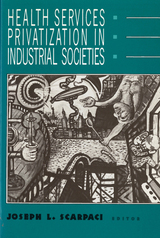 Health Services Privatization in Industrial Societies
Scarpaci, Joseph L
Rutgers University Press, 1989 As governments in industrialized nations around the world face fiscal crises, they are increasingly turning over the functions of the welfare state to the private sector. Health care systems are particularly tempting targets for privatization. The costs of health care have risen faster than many other services. Health care systems fail to reward efficiency, and liberal welfare policies have enlarged the number of people who benefit from public health care services, and have done so in ways that often seem inequitable. The particular forms that privatized health care take are closely intertwined with local and political and economic circumstances, but the popularity of the idea in all kinds of governments, in all parts of the world, is very striking. This book looks at the theory and practice of privatization of health services internationally. The contributors argue that the restructuring of health care systems affects local communities in markedly uneven ways. Ultimately, they conclude, conflicts arising from economic and geographic inequities implicit in privatization will limit the degree to which any government can dismantle its health care services.
Health Services Research: Key to Health Policy
Eli Ginzberg
Harvard University Press, 1991 Despite the long and distinguished history of health services research in the United States, this unparalleled work is the first comprehensive account of what health services research aims to do and what the research has actually accomplished. Specially commissioned essays by a roster of leading scholars offer an incisive look at the current potential of the field.
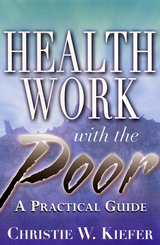 Health Work with the Poor: A Practical Guide
Kiefer, Christie W
Rutgers University Press, 2000 Christie Kiefer vividly brings home the meaning of poverty in peoples’ lives as he examines both their access to—and their lack of—health care. Aimed at both students and professionals in the field, this book argues that individuals serving the poor have the means and obligation to address the root causes of ill health of the poor, not just the symptoms. These causes, Kiefer argues, are overwhelmingly social and political. In a ringing indictment of the factors that perpetuate poverty, he declares that the work of healing at its best must include advocacy. Health Work with the Poor offers to both health workers and activists a wealth of practical information. Kiefer’s trenchant analysis of the factors that help cause and perpetuate poverty offers students the needed intellectual framework not only to accomplish short-term change but also to strive toward long-term social advocacy. Each chapter ends with a set of discussion questions—a real boon for instructors. Appendices on Internet resources for the study of poverty and on a proposed program detailing how to teach health workers in a way that promotes social awareness make this book a valuable resource for courses on poverty and health. It will also be an indispensable manual for all those who work with the poor.
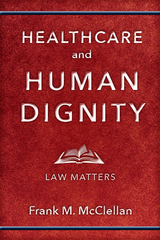 Healthcare and Human Dignity: Law Matters
Frank M. McClellan
Rutgers University Press, 2020 The individual and structural biases that affect the American healthcare system have serious emotional and physical consequences that all too often go unseen. These biases are often rooted in power, class, racial, gender or sexual orientation prejudices, and as a result, the injured parties usually lack the resources needed to protect themselves. In Healthcare and Human Dignity, individual worth, equality, and autonomy emerge as the dominant values at stake in encounters with doctors, nurses, hospitals, and drug companies. Although the public is aware of legal battles over autonomy and dignity in the context of death, the everyday patient’s need for dignity has received scant attention. Thus, in Healthcare, law professor Frank McClellan’s collection of cases and individual experiences bring these stories to life and establish beyond doubt that human dignity is of utmost priority in the everyday process of healthcare decision making.
Healthcare in Ireland and Britain 1850-1970: Voluntary, regional and comparative perspectives
Edited by Donnacha Sean Lucey and Virginia Crossman
University of London Press, 2015 This volume explores developments in health and social care in Ireland and Britain during the nineteenth and twentieth centuries. The central objectives are to highlight the role of voluntarism in healthcare, to examine healthcare in local and regional contexts, and to provide comparative perspectives. The collection is based on two interconnected and overlapping research themes: voluntarism and healthcare, and regionalism/localism and healthcare. It includes two synoptic overviews by leading authorities in the field, and ten case studies focusing on particular aspects of voluntary and/or regional healthcare in Ireland and Britain.
Healthcare Monitoring and Data Analysis using IoT: Technologies and applications
Vishal Jain
The Institution of Engineering and Technology, 2022 IoT-enabled healthcare technologies can be used for remote health monitoring, rehabilitation assessment and assisted ambient living. Healthcare analytics can be applied to the data gathered from these different areas to improve healthcare outcomes by providing clinicians with real-world, real-time data so they can more easily support and advise their patients.
Healthcare Reform and Poverty in Latin America
Edited by Peter Lloyd-Sherlock
University of London Press, 2000 Most Latin American countries are now attempting the radical reform of their healthcare financing and delivery systems. In many cases, these reforms complement and contribute to broader neo-liberal orthodoxies of economic and social reform. Key strategies include decentralising hospital administration and the promotion of private health insurance. However, experiences across the region are quite diverse, and countries such as Cuba persist with a system of healthcare based on very different principles. This book identifies key problems facing healthcare systems in the region and evaluates the reforms that have been implemented to date. It pays particular attention to problems of implementation and the impact that changes to health policy are having on poor and vulnerable groups.
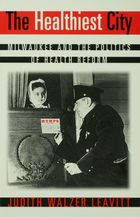 The Healthiest City: Milwaukee and the Politics of Health Reform
Judith W. Leavitt
University of Wisconsin Press, 1996 Between 1850 and 1900, Milwaukee’s rapid population growth also gave rise to high death rates, infectious diseases, crowded housing, filthy streets, inadequate water supplies, and incredible stench. The Healthiest City shows how a coalition of reform groups brought about community education and municipal action to achieve for Milwaukee the title of “the healthiest city” by the 1930s. This highly praised book reminds us that cutting funds and regulations for preserving public health results in inconvenience, illness, and even death.
“A major work. . . . Leavitt focuses on three illustrative issues—smallpox, garbage, and milk, representing the larger areas of infectious disease, sanitation, and food control.”—Norman Gevitz, Journal of the American Medical Association
“Leavitt’s research provides additional evidence . . . that improvements in sanitation, living conditions, and diet contributed more to the overall decline in mortality rates than advances in medical practice. . . . A solid contribution to the history of urban reform politics and public health.”—Jo Ann Carrigan, Journal of American History
 The Healthy Body and Victorian Culture
Bruce Haley
Harvard University Press, 1978 Health obsessed the Victorians. The quest for health guided Victorian living habits, shaped educational goals, and sanctioned a mania for athletic sports. As both metaphor and ideal, it influenced psychology, religion, moral philosophy; it affected the writing of history as well as the criticism of literature. Here is a wide-ranging and ably written exploration of this fascinating aspect of Victorian ideas.
Bruce Haley looks at developments in personal and public health, and at theories about the relation between medical and psychological disorders. He examines influential conceptions of the healthy man: Carlyle's healthy hero, Spencer's biologically perfect man, Newman's gentleman-Christian, Kingsley's muscular Christian. He describes the development of sports and physical training in nineteenth-century England and their importance in schools and universities. He traces the concept of healthy body and healthy mind in boy's fiction (such as Torn Brown's School Days), self-help literature, and the widely read novels of George Eliot, Wilkie Collins, George Meredith, and Charles Kingsley. All these strands of social history, literature, and philosophy are woven together into a seamless whole.
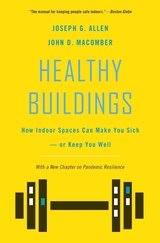 Healthy Buildings: How Indoor Spaces Can Make You Sick—or Keep You Well
Joseph G. Allen and John D. Macomber
Harvard University Press, 2022 A revised and updated edition of the landmark work the New York Times hailed as “a call to action for every developer, building owner, shareholder, chief executive, manager, teacher, worker and parent to start demanding healthy buildings with cleaner indoor air.”
For too long we’ve designed buildings that haven’t focused on the people inside—their health, their ability to work effectively, and what that means for the bottom line. An authoritative introduction to a movement whose vital importance is now all too clear, Healthy Buildings breaks down the science and makes a compelling business case for creating healthier offices, schools, and homes.
As the COVID-19 crisis brought into sharp focus, indoor spaces can make you sick—or keep you healthy. Fortunately, we now have the know-how and technology to keep people safe indoors. But there is more to securing your office, school, or home than wiping down surfaces. Levels of carbon dioxide, particulates, humidity, pollution, and a toxic soup of volatile organic compounds from everyday products can influence our health in ways people aren’t always aware of.
This landmark book, revised and updated with the latest research since the COVID-19 pandemic, lays out a compelling case for more environmentally friendly and less toxic offices, schools, and homes. It features a concise explanation of disease transmission indoors, and provides tips for making buildings the first line of defense. Joe Allen and John Macomber dispel the myth that we can’t have both energy-efficient buildings and good indoor air quality. We can—and must—have both. At the center of the great convergence of green, smart, and safe buildings, healthy buildings are vital to the push for more sustainable urbanization that will shape our future.
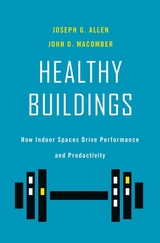 Healthy Buildings: How Indoor Spaces Drive Performance and Productivity
Joseph G. Allen and John D. Macomber
Harvard University Press, 2020 A New York Times Favorite Book of the Year for Healthy Living
A Fortune Best Book of the Year
An AIA New York Book of the Year
“This book should be essential reading for all who commission, design, manage, and use buildings—indeed anyone who is interested in a healthy environment.”
—Norman Foster
As schools and businesses around the world consider when and how to reopen their doors to fight COVID-19, the Director of Harvard’s Healthy Buildings Program and Harvard Business School’s leading expert on urban resilience reveal what you can do to harness the power of your offices, homes, and schools to protect your health—and boost every aspect of your performance and well-being.
Ever feel tired during a meeting? That’s because most conference rooms are not bringing in enough fresh air. When that door opens, it literally breathes life back into the room. But there is a lot more acting on your body that you can’t feel or see. From our offices and homes to schools, hospitals, and restaurants, the indoor spaces where we work, learn, play, eat, and heal have an outsized impact on our performance and well-being. They affect our creativity, focus, and problem-solving ability and can make us sick—jeopardizing our future and dragging down profits in the process.
Charismatic pioneers of the healthy building movement who have paired up to combine the cutting-edge science of Harvard’s School of Public Health with the financial know-how of the Harvard Business School, Joseph Allen and John Macomber make a compelling case in this urgently needed book for why every business and home owner should make certain relatively low-cost investments a top priority. Grounded in exposure and risk science and relevant to anyone newly concerned about how their surroundings impact their health, Healthy Buildings can help you evaluate the impact of small, easily controllable environmental fluctuations on your immediate well-being and long-term reproductive and lung health. It shows how our indoor environment can have a dramatic impact on a whole host of higher order cognitive functions—including things like concentration, strategic thinking, troubleshooting, and decision-making. Study after study has found that your performance will dramatically improve if you are working in optimal conditions (with high rates of ventilation, few damaging persistent chemicals, and optimal humidity, lighting and noise control). So what would it take to turn that knowledge into action?
Cutting through the jargon to explain complex processes in simple and compelling language, Allen and Macomber show how buildings can both expose you to and protect you from disease. They reveal the 9 Foundations of a Healthy Building, share insider tips, and show how tracking what they call “health performance indicators” with smart technology can boost a company’s performance and create economic value. With decades of practice in protecting worker health, they offer a clear way forward right now, and show us what comes next in a post-COVID world. While the “green” building movement introduced important new efficiencies, it’s time to look beyond the four walls—placing the decisions we make around buildings into the larger conversation around development and health, and prioritizing the most important and vulnerable asset of any building: its people.
 The Healthy Child: His Physical, Psychological, and Social Development
Harold C. Stuart
Harvard University Press Intended for professionals, The Healthy Child provides the background essential for workers in the fields of education, psychology, nutrition, social work, nursing, public health, and medicine. The range of disciplines and occupational experience represented by the contributors makes possible the presentation of a broad view of the child and his needs at all stages.
Written to increase the understanding of general principles and their application, the contributions include discussions of maternal health and nutrition during pregnancy and their relation to the fetus and infant, physical growth and development, psychological and social development, educational progress, nutrition, and the general aspects of illness and immunity by age periods. In the concluding chapter, these basic aspects of child development are related to the organization of maternal and child health services in different kinds of communities.
The contributors emphasize throughout the interrelation of physical and psychological aspects of child development with family and other social circumstances, as well as with the effects of illnesses and handicaps.
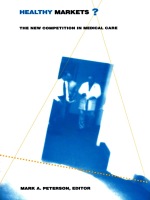 Healthy Markets?: The New Competition in Medical Care
Mark A. Peterson, ed.
Duke University Press, 1999 When federal and state policy makers’ efforts to enact sweeping health care reform in the mid-1990s ended in stalemate, the private sector unleashed initiatives that have affected virtually every aspect of health care. With updated essays first published in issues of the Journal of Health Politics, Policy and Law, Healthy Markets? offers the most comprehensive and critical examination yet found in a single volume of the economic, political, and social implications of this recent market transformation of health care in the United States. With original contributions from leading social science health policy analysts, this volume addresses the full context of health system change. Believing that the analysis of health care change is too important to be left to economists alone, Mark A. Peterson has collected a mulitdisciplinary group of experts who revisit the contentious debate over the market approaches to health care and consider the disparate effects of these approaches on cost, quality, and coverage of both managed care and Medicaid and Medicare. While market enthusiasts applaud the enhanced efficiency, reduced excess capacity, and abatement of the decades-long health care cost explosion, a backlash has emerged among many providers and the public against the perceived excesses of the market: diminished access to care, commercialization of the physician-patient relationship, and exacerbated inequality. Contributors assess these varied responses while examining the impact that market-based applications are likely to have for future health policy making, the significance of the U.S. experience for policy makers abroad, and the lessons that these changes might provide for thinking sensibly about the future of our health care system. This volume will be useful for public policy analysts, economists, social scientists, health care providers and administrators, and others interested in the future—and in understanding the past—of American health care. Contributors. Gary S. Belkin, Lawrence D. Brown, Robert G. Evans, Martin Gaynor, Paul B. Ginsburg, Marsha Gold, Theodore R. Marmor, Cathie Jo Martin, Jonathan B. Oberlander, Mark V. Pauly, Mark A. Peterson, Thomas Rice, Deborah A. Stone, William B. Vogt, Kenneth E. Thorpe
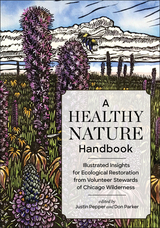 A Healthy Nature Handbook: Illustrated Insights for Ecological Restoration from Volunteer Stewards of Chicago Wilderness
Edited by Justin Pepper and Don Parker
Island Press, 2021 The Chicago metropolitan area is home to far more protected nature than most people realize. Over half a million acres of protected land known as the Chicago Wilderness are owned and managed by county forest preserve districts and other public and private sector partners. But there’s a critical factor of the Chicago Wilderness conservation effort that makes it unique: a pioneering grassroots volunteer community, thousands strong, has worked for decades alongside agency staff to restore these nearby natural areas, learning how to manage biodiversity in an altered and ever-changing urban context.
A Healthy Nature Handbook captures hard-earned ecological wisdom from this community in engaging and highly readable chapters, each including illustrated restoration sequences. Restoration leaders cover large-scale seeding approaches, native seed production, wetland and grassland bird habitat restoration, monitoring, and community building.
Contributions from local artists bring the region’s beauty to life with vibrant watercolors, oil paintings, and sketches. A Healthy Nature Handbook is packed with successful approaches to restoring nature and is a testament to both the Chicago region’s surprising natural wealth and the stewards that are committed to its lasting health.
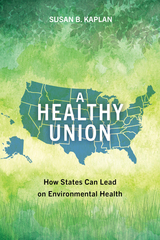 A Healthy Union: How States Can Lead on Environmental Health
Susan Kaplan
Island Press, 2025 States have tremendous power to protect their residents’ health. In the absence of adequate federal safeguards against pollution and toxic chemicals, state policies are the strongest tools available to create safe, sustainable environments. The good news is, around the country, red states and blue states are taking up the charge.
In California, state agencies are partnering with disadvantaged communities to measure air quality, reduce pollution, and advance environmental justice. In Texas, a state law requires every school to cut down on the use of dangerous pesticides, helping to keep kids safe. In New York, a network of clinics trains medical professionals in occupational health and children’s environmental health, ensuring that patients receive excellent care and specialists are ready to advocate for protective policies. The success of these programs is not haphazard; instead, effective approaches share key elements, including state-university-industry partnerships, collaboration across government agencies, and strong environmental health education.
In A Healthy Union, Susan Kaplan highlights examples of groundbreaking state environmental health policies, exploring what has worked, what needs improvement, and how other areas of the country can build on these advances. Further, she shows how public health advocates can push forward new protections, creating safer environments for the next generation. Ultimately, Kaplan argues, we need a coordinated federal and state response to environmental health threats. Until then, innovative policy solutions can go a long way to improve the nation’s wellbeing, one state at a time.
|
|



